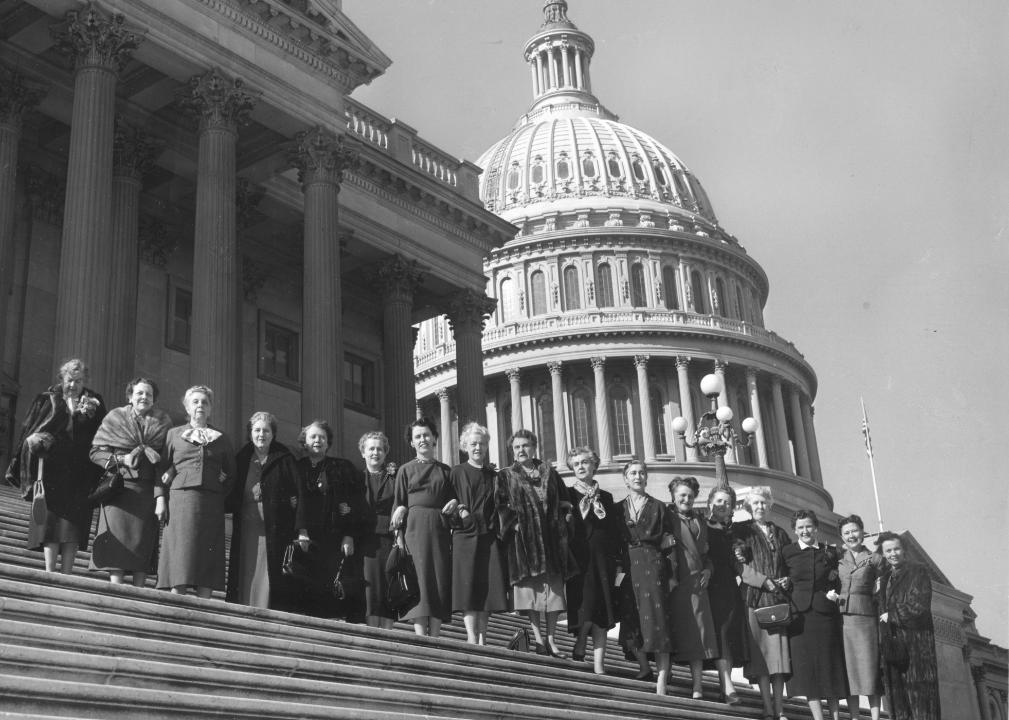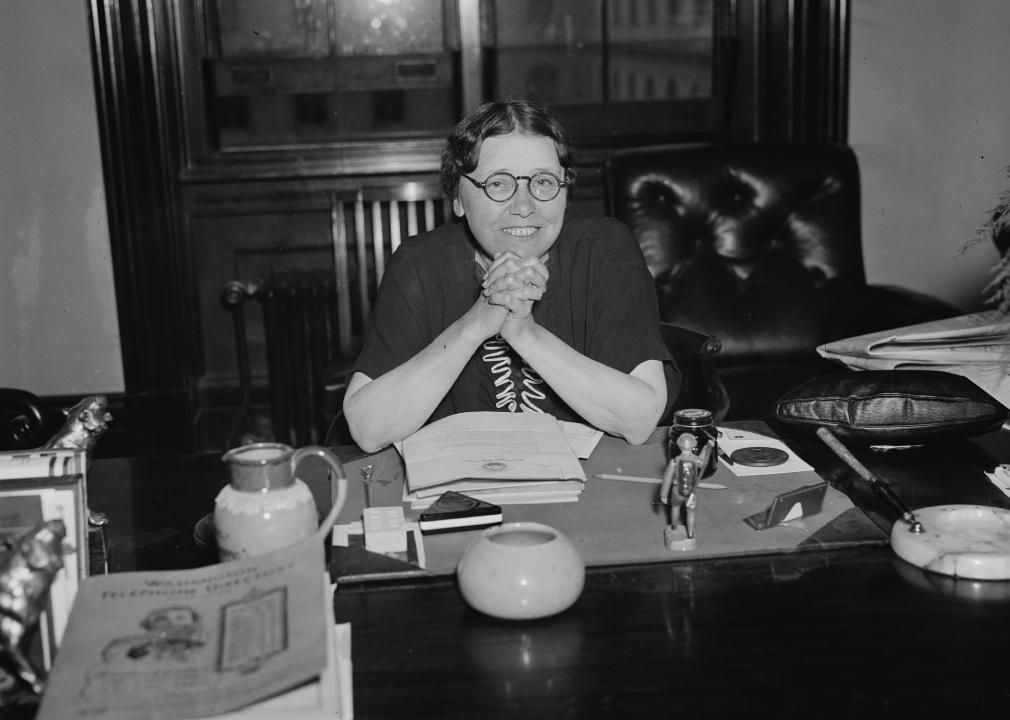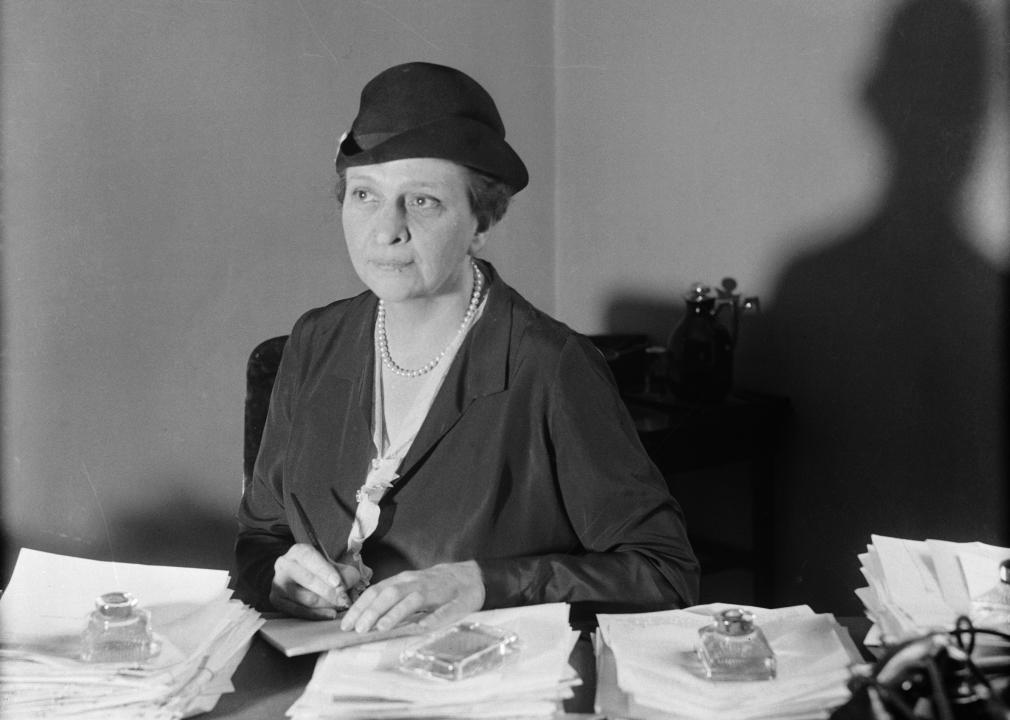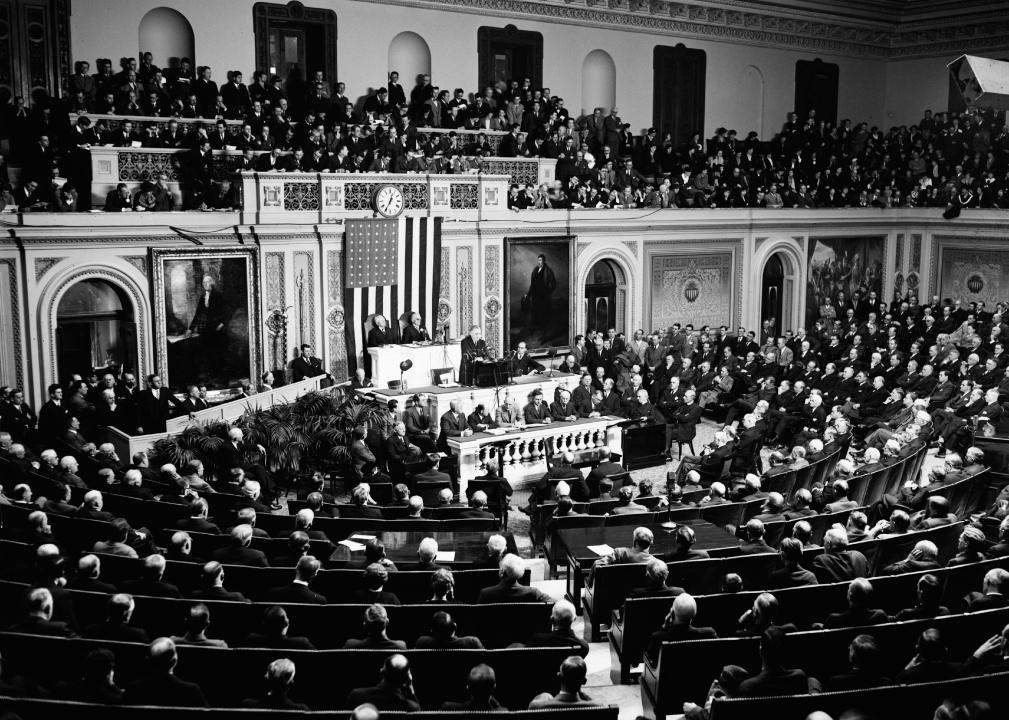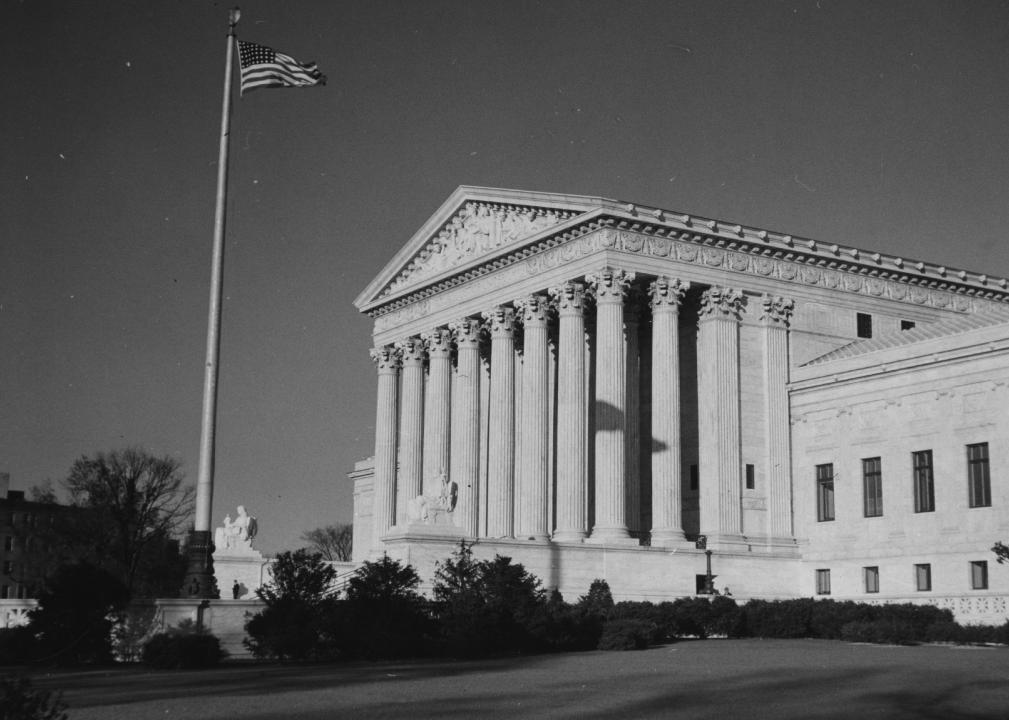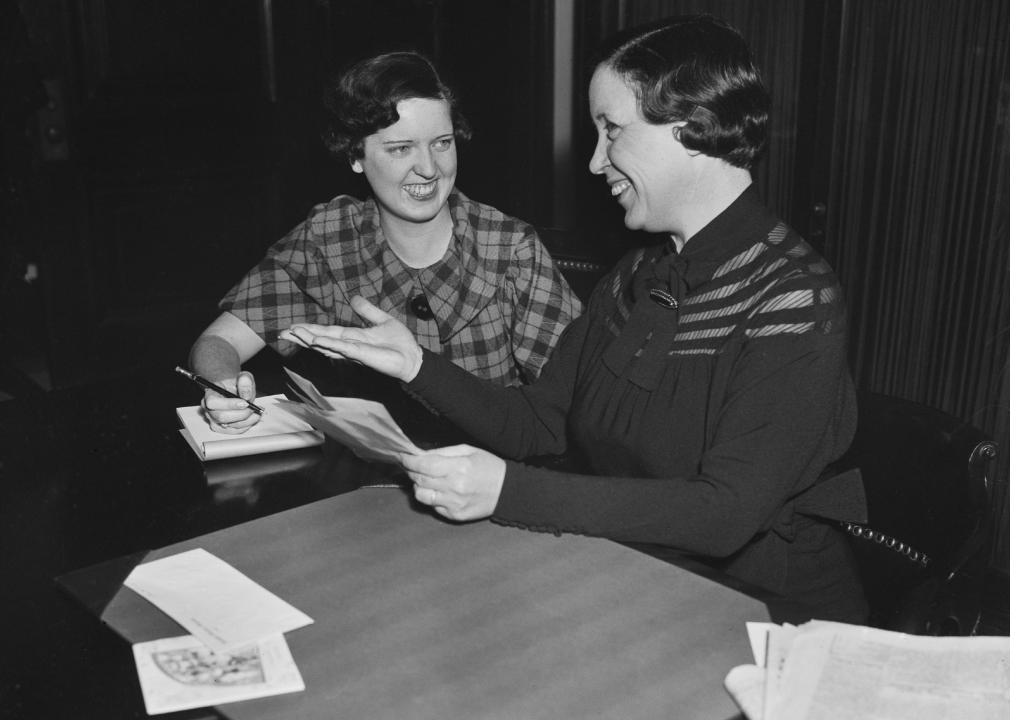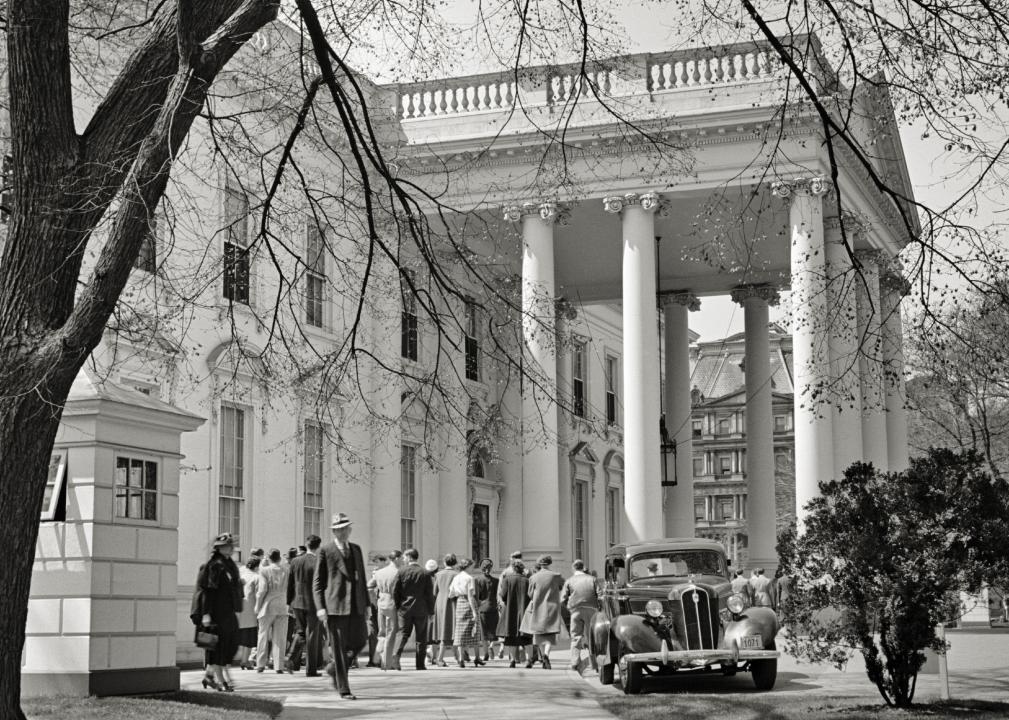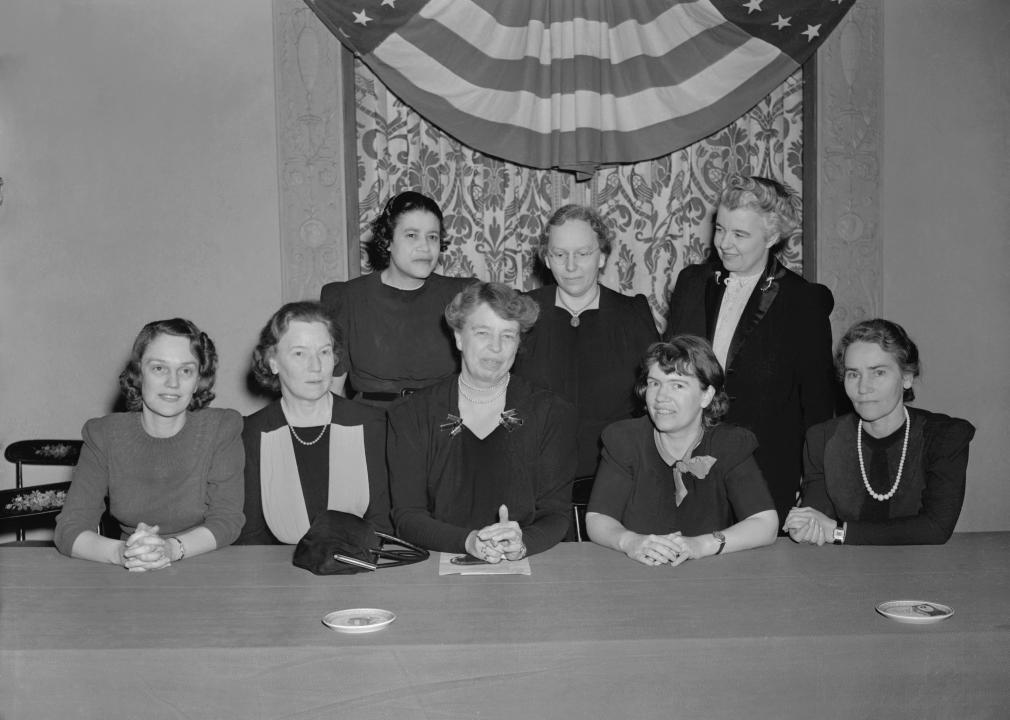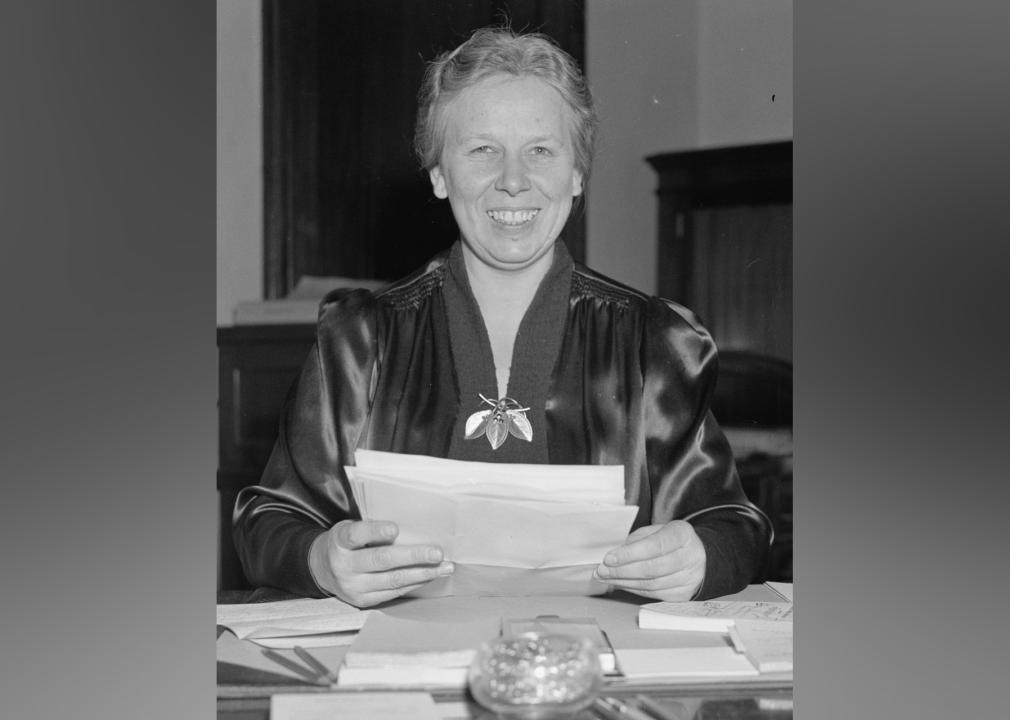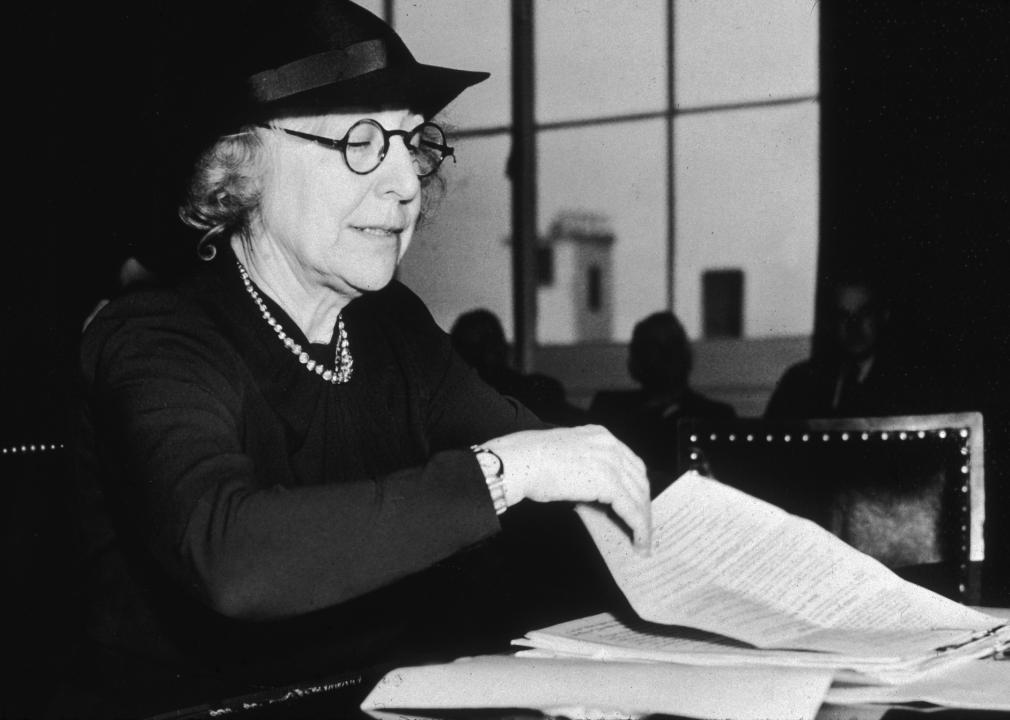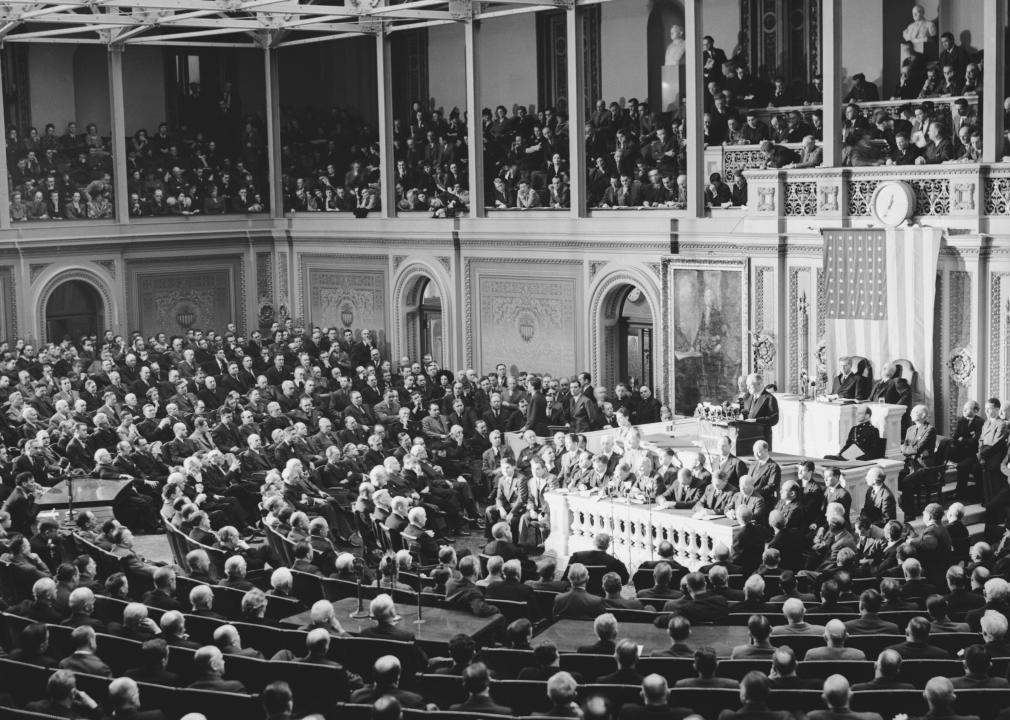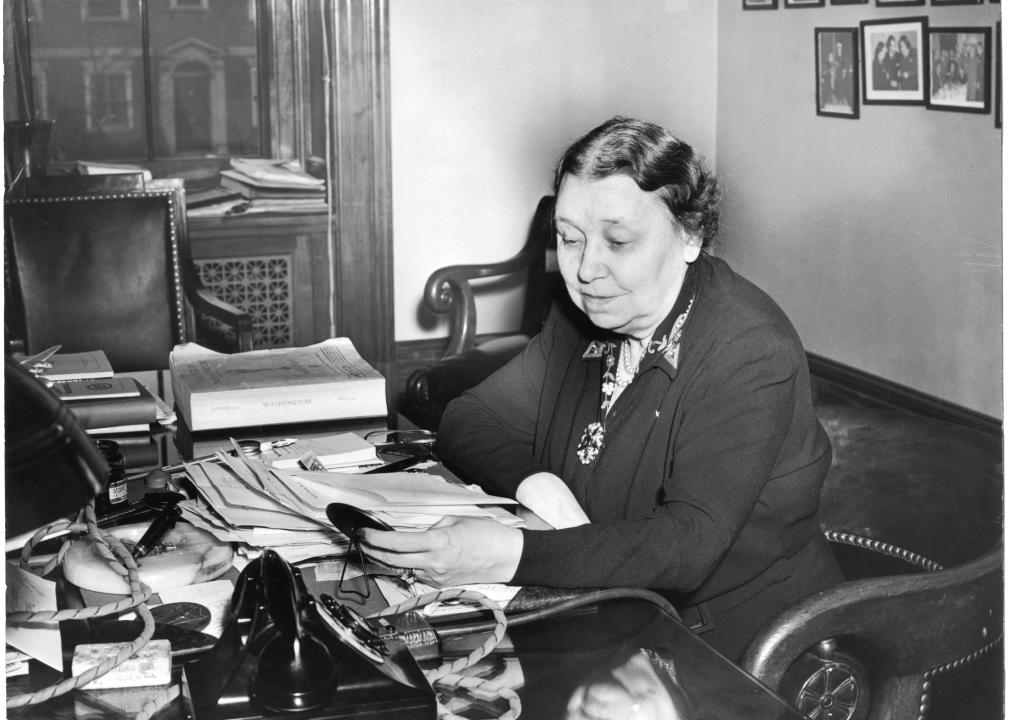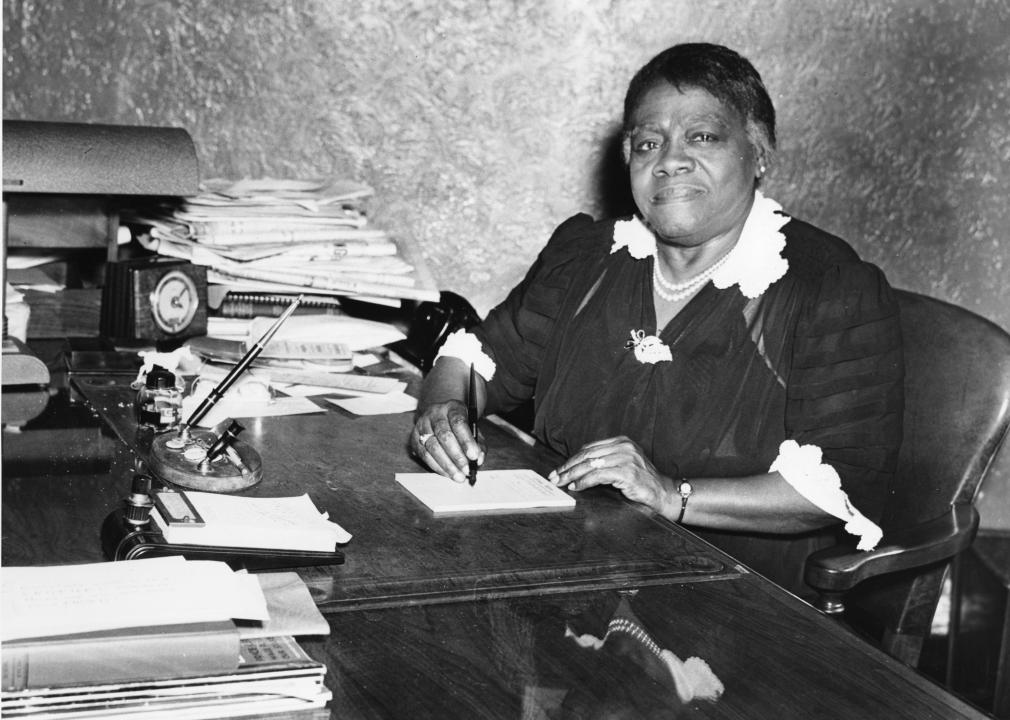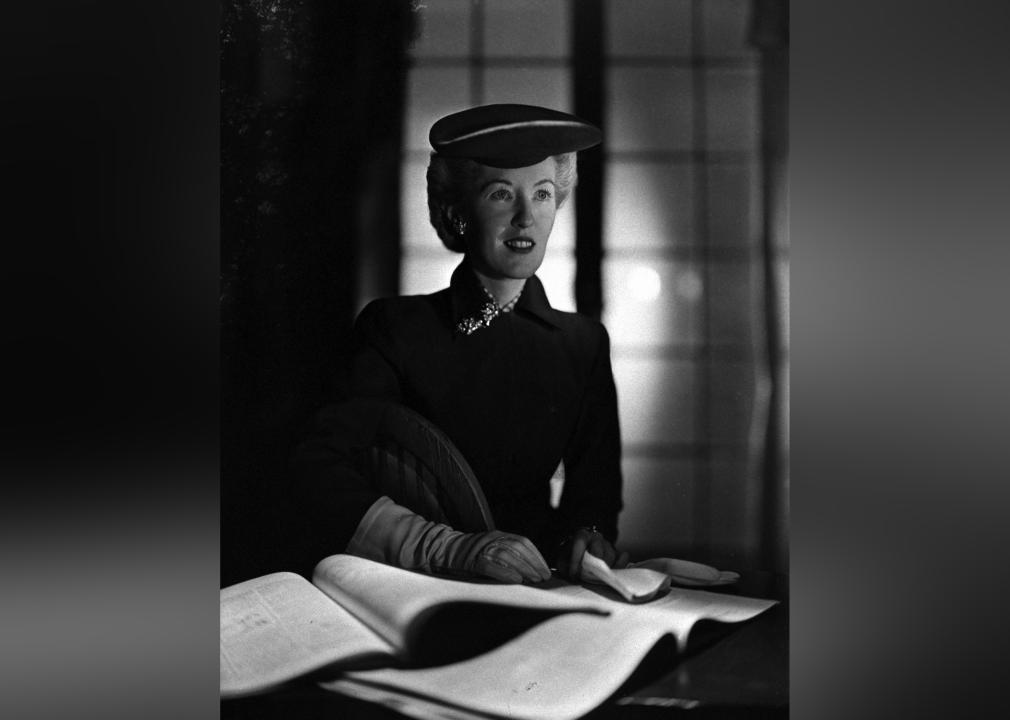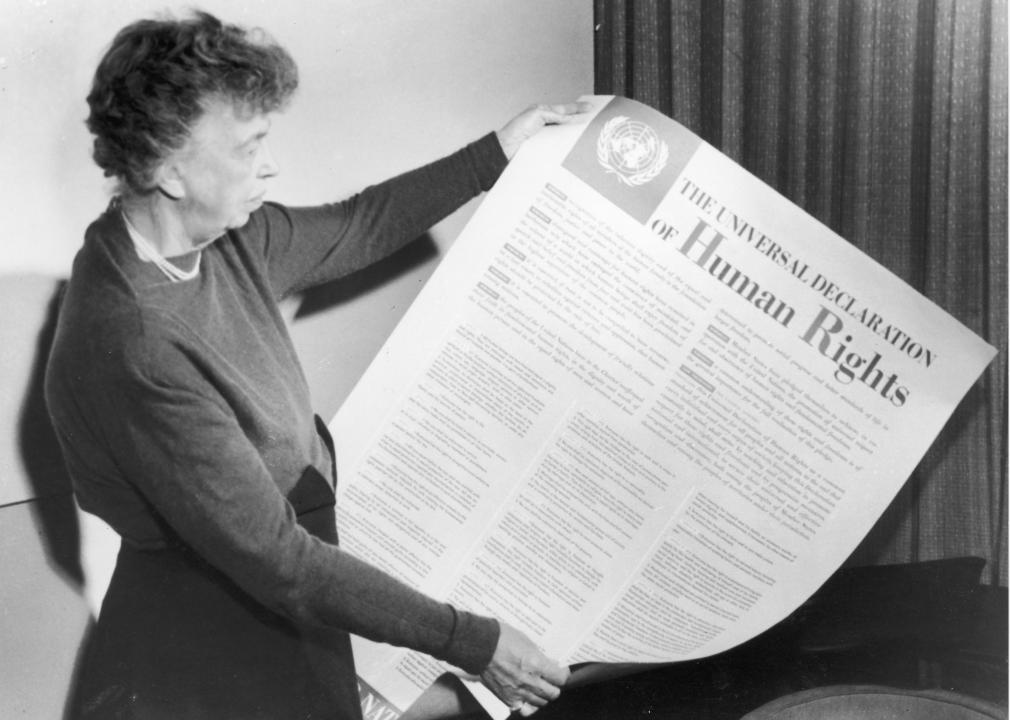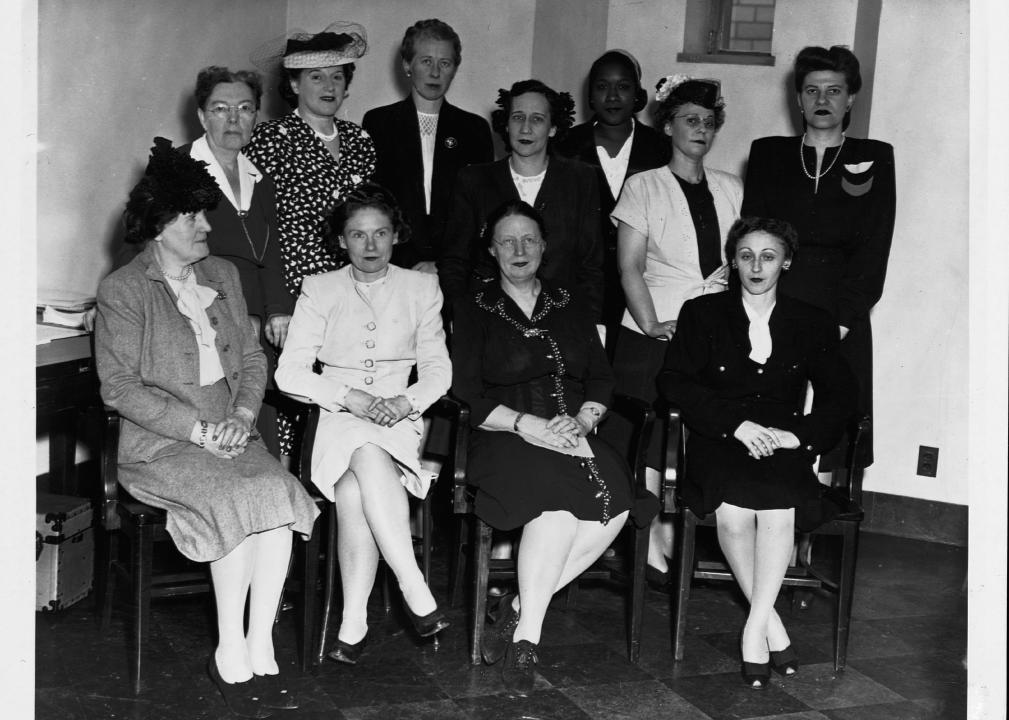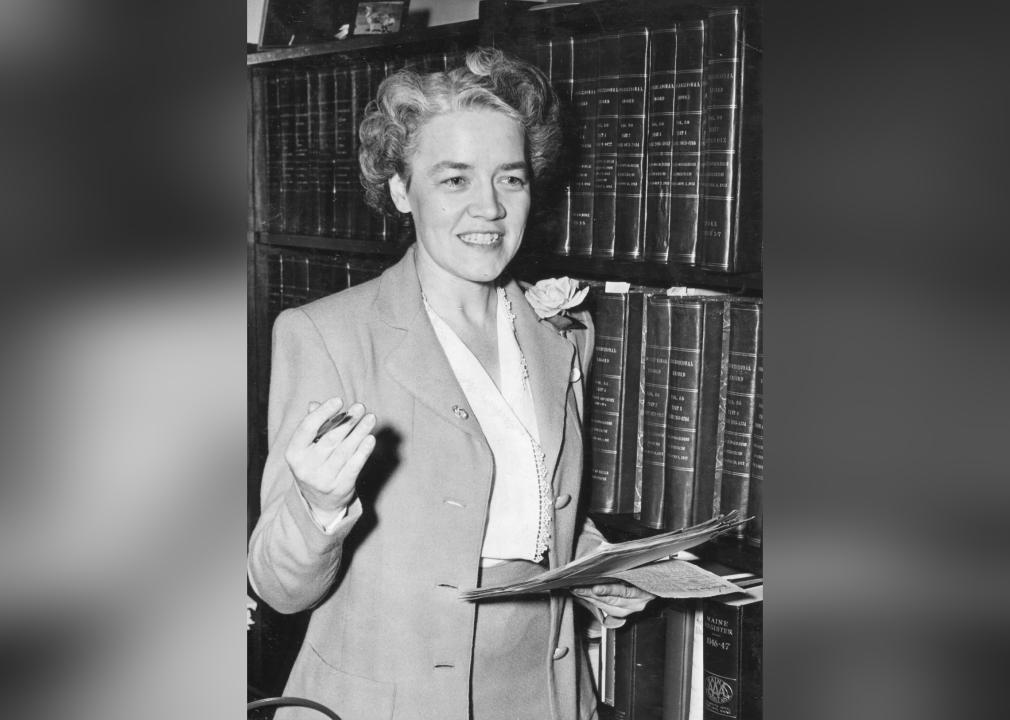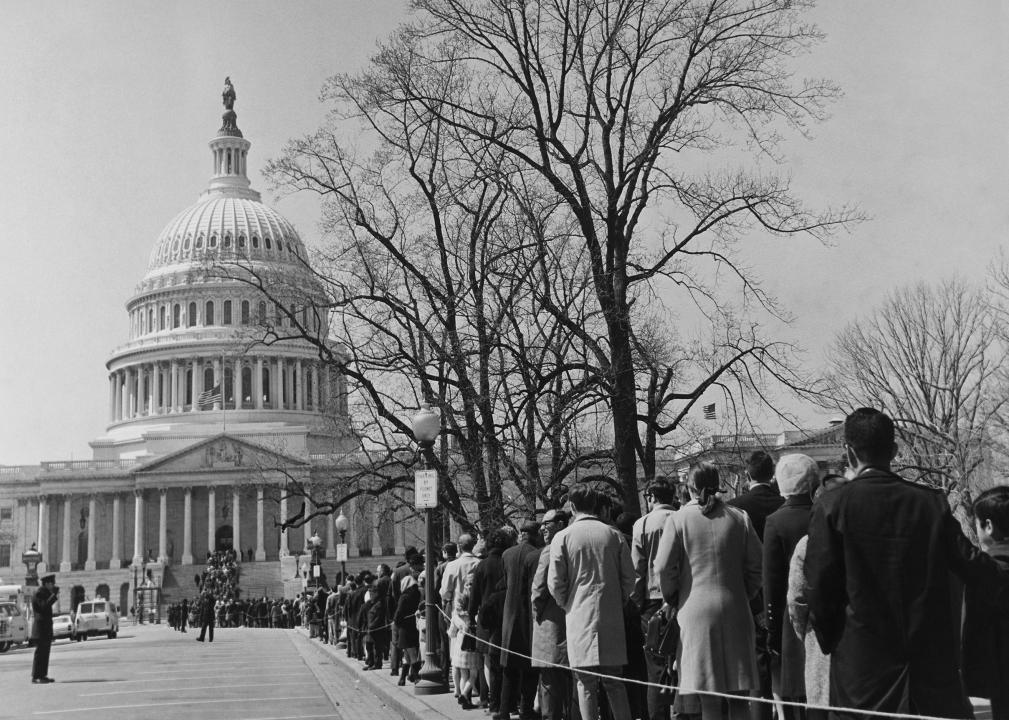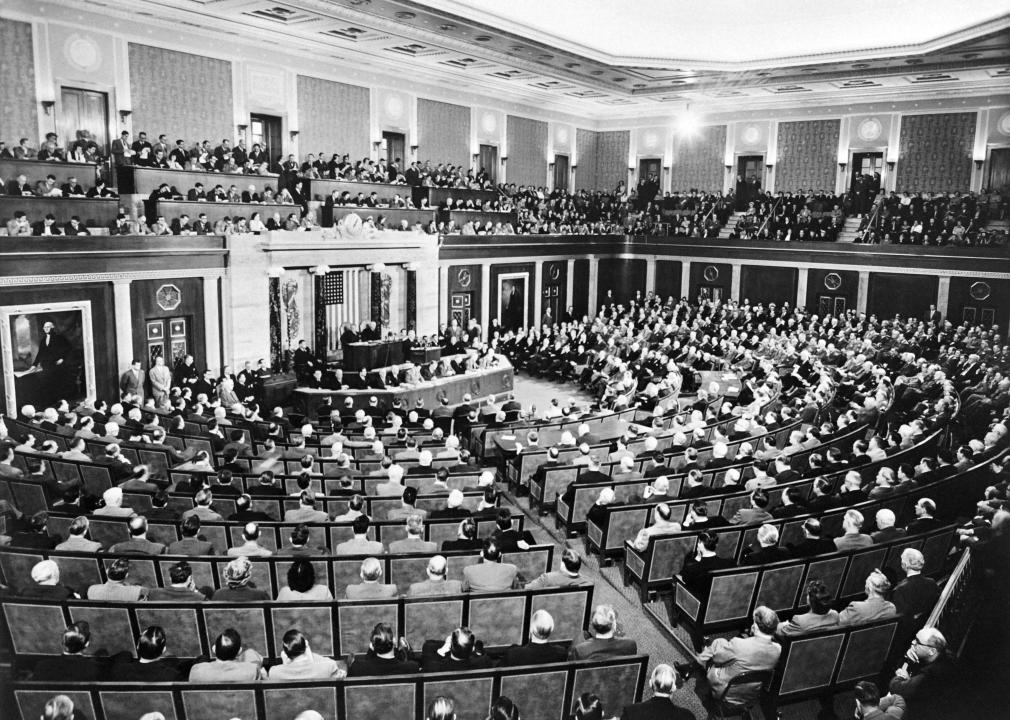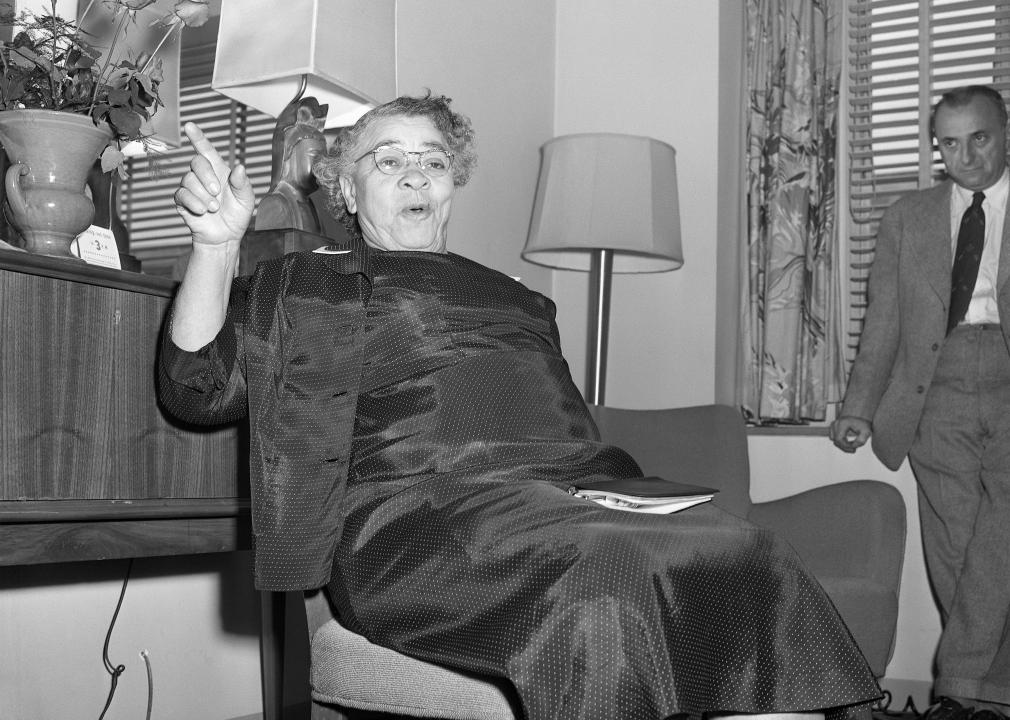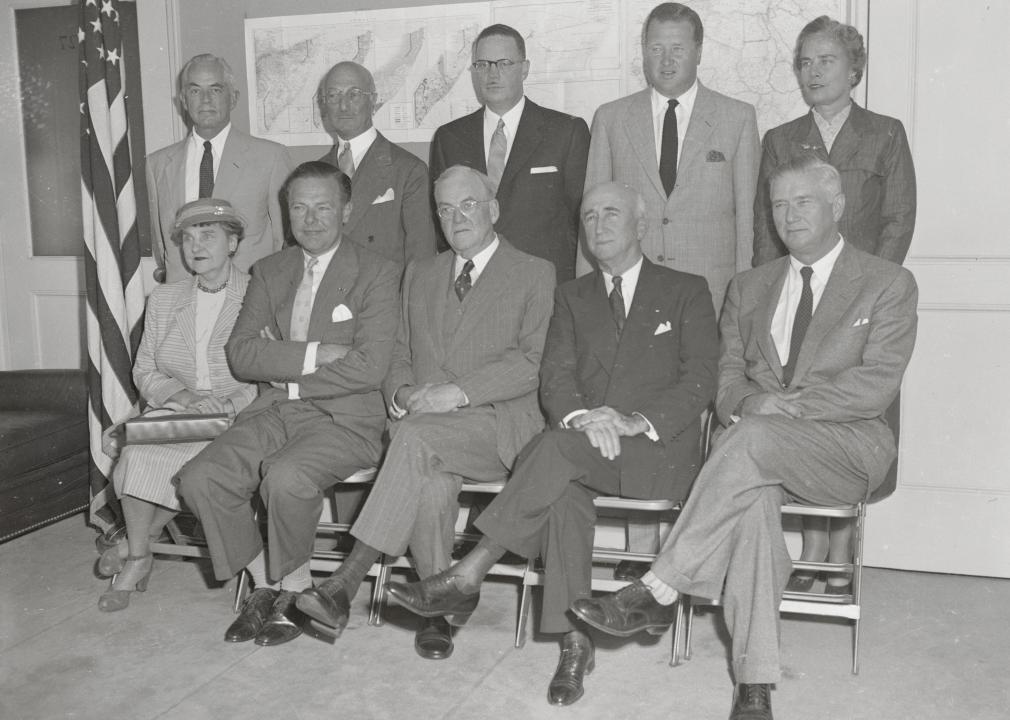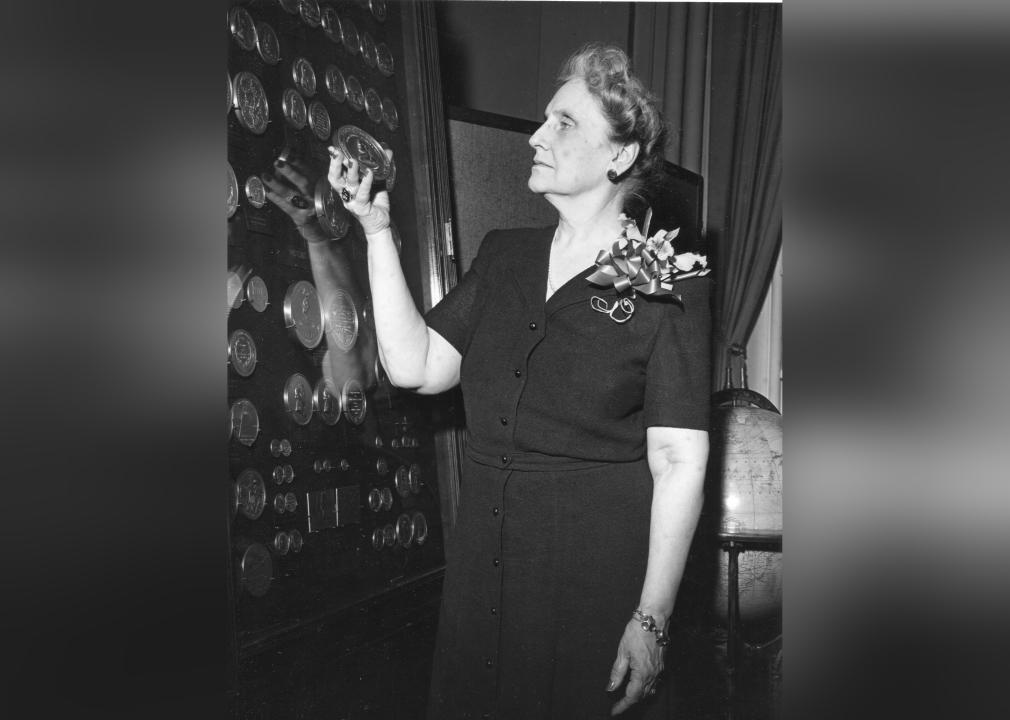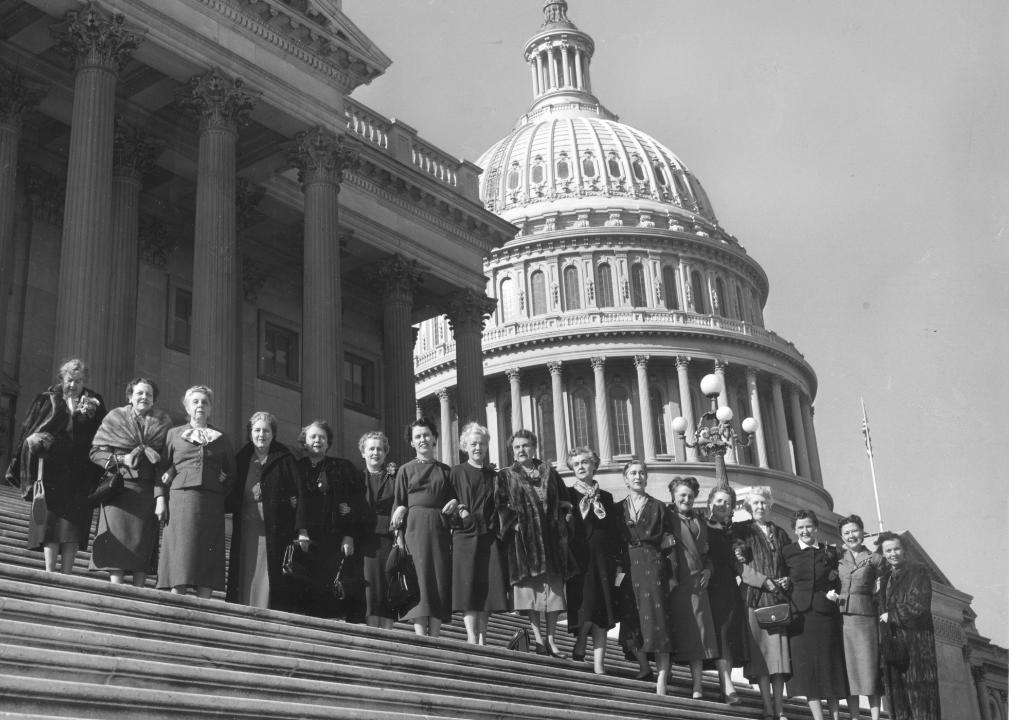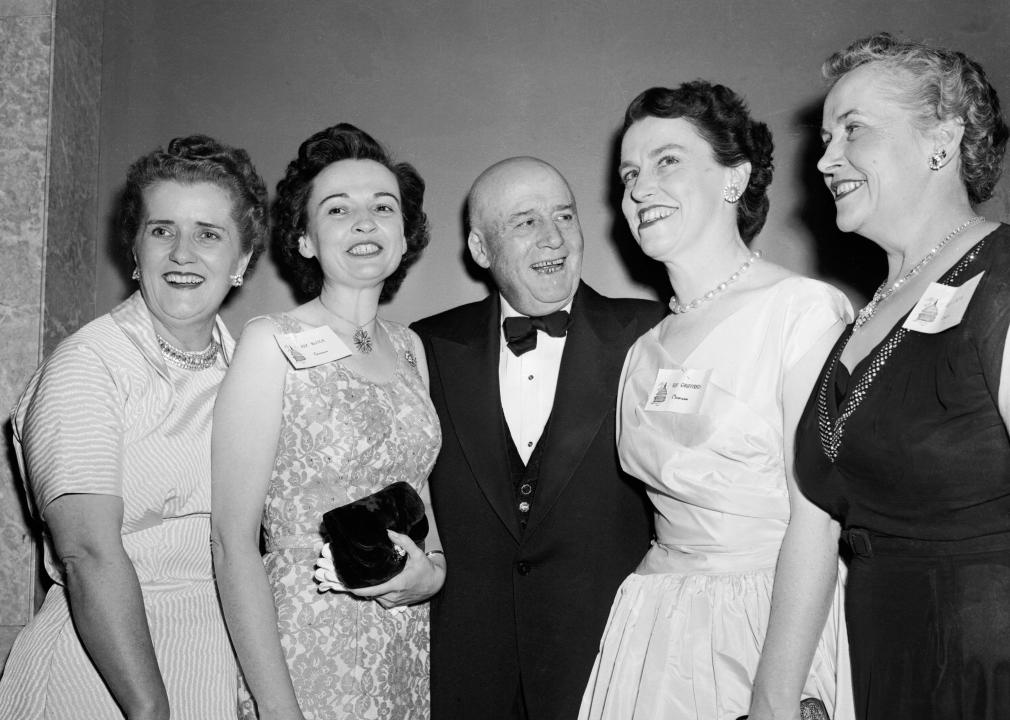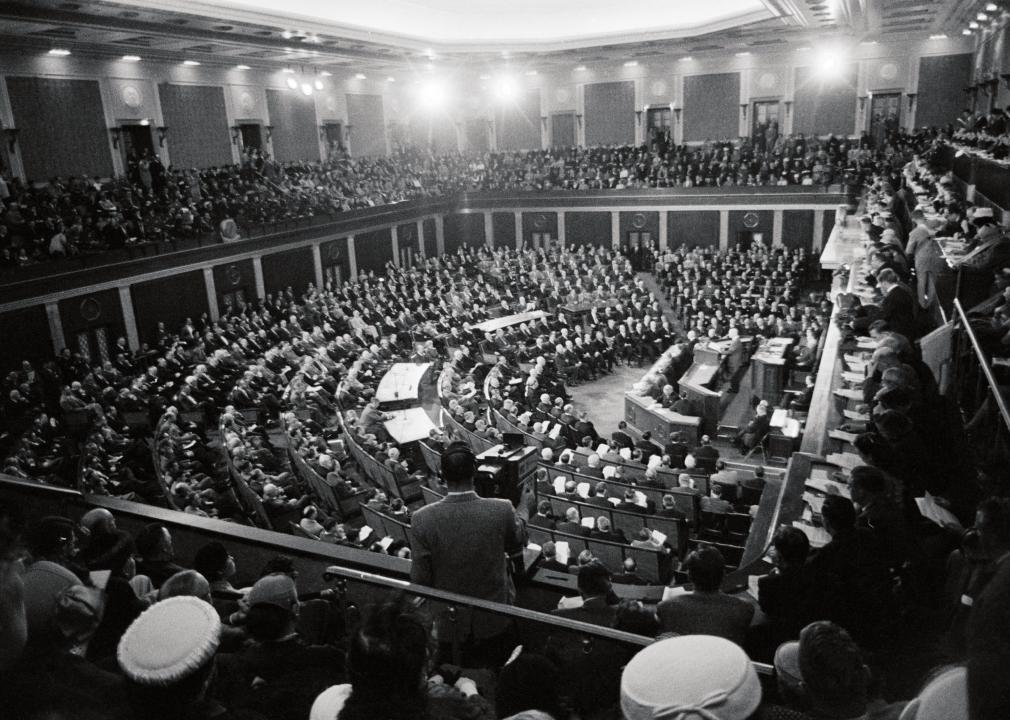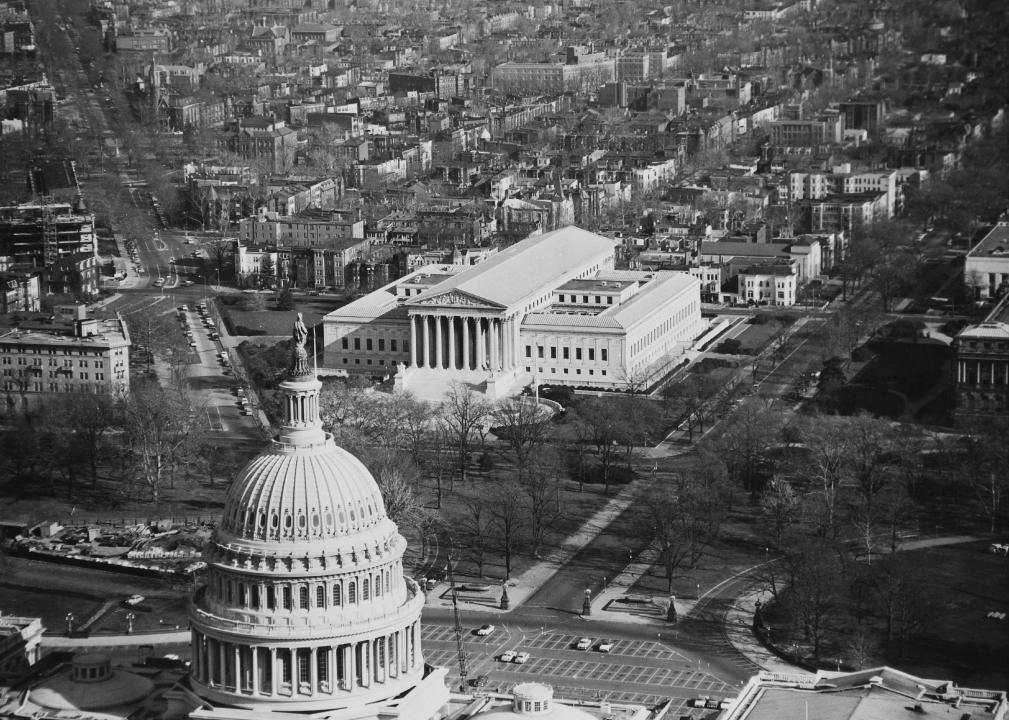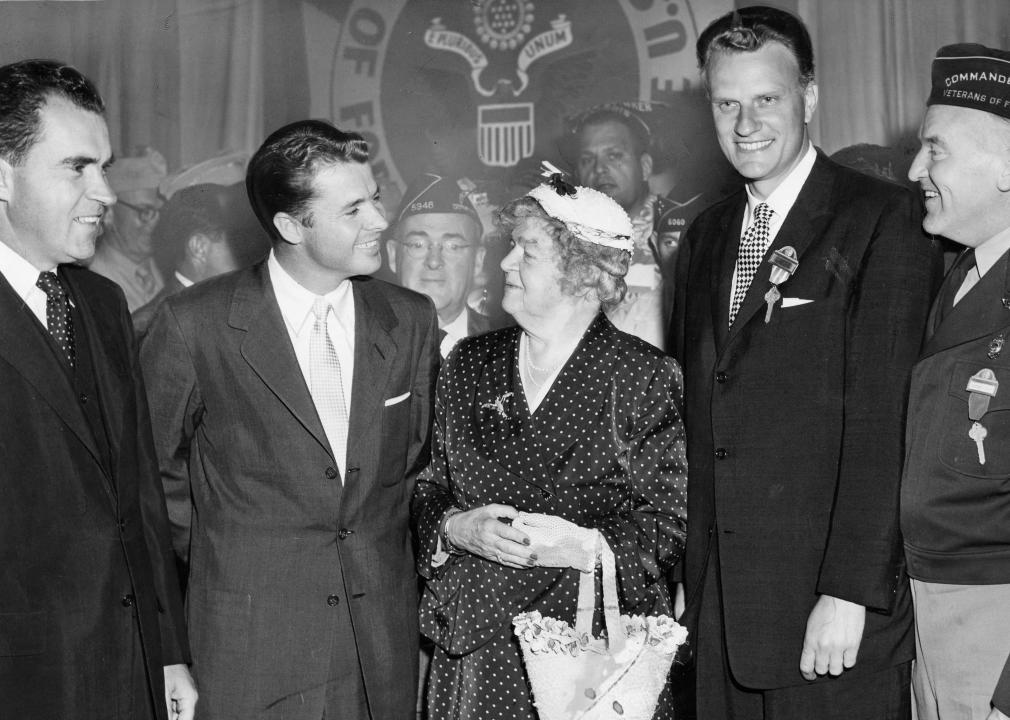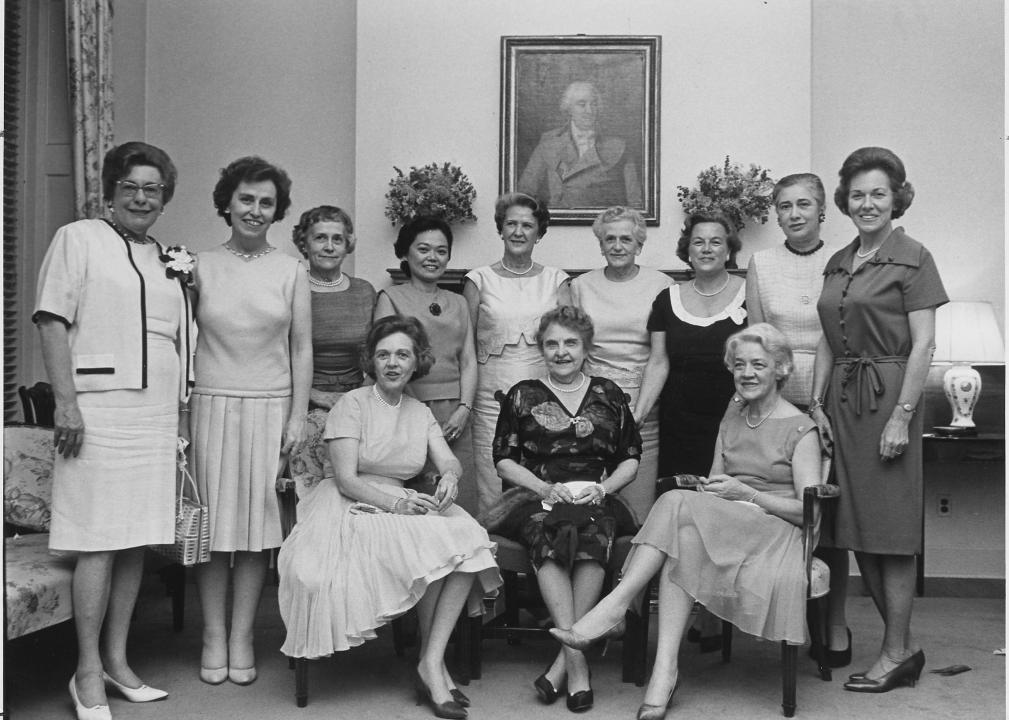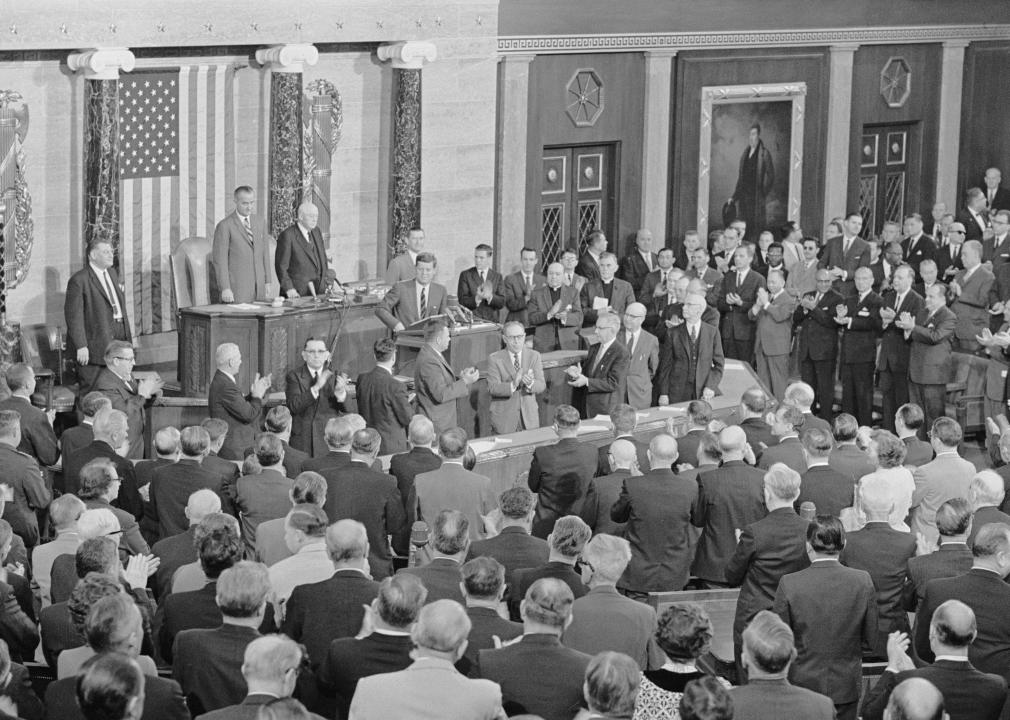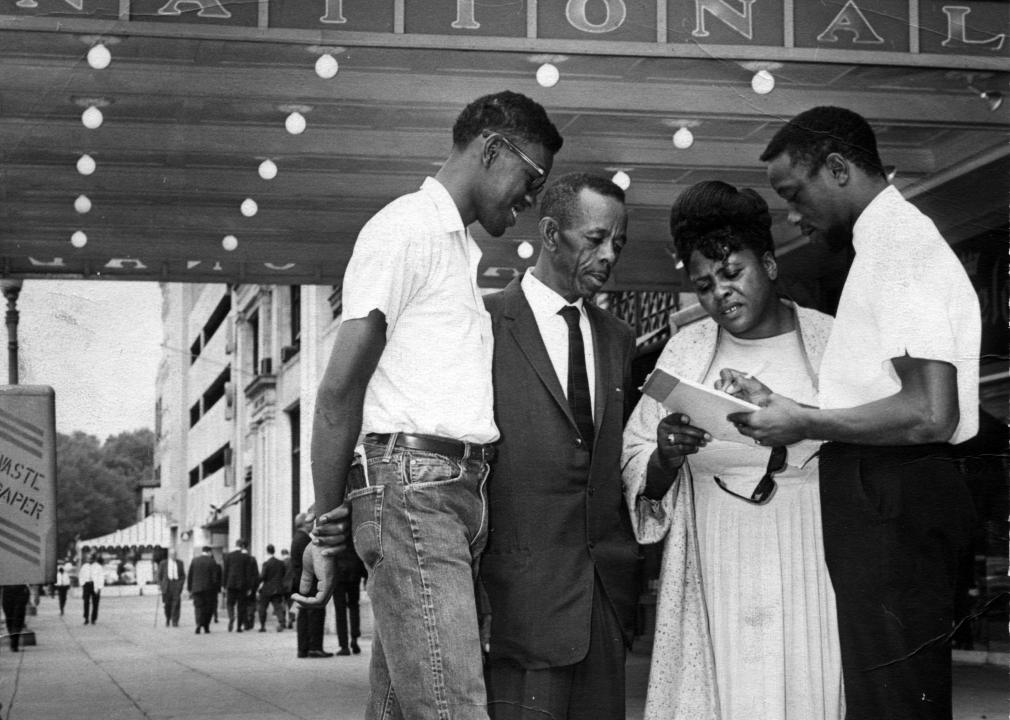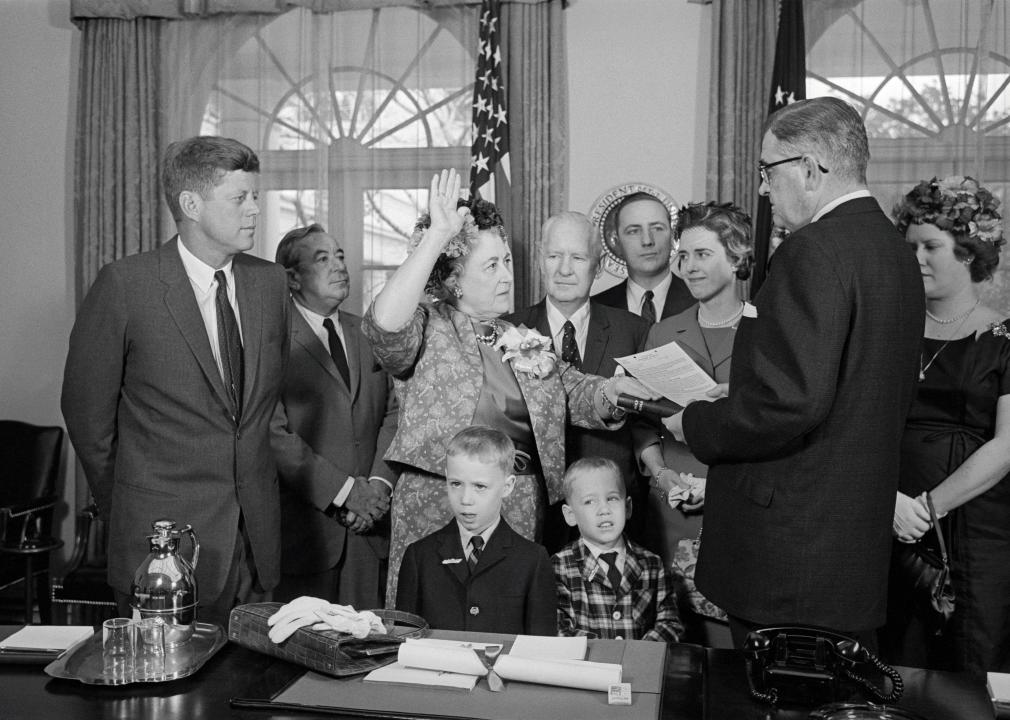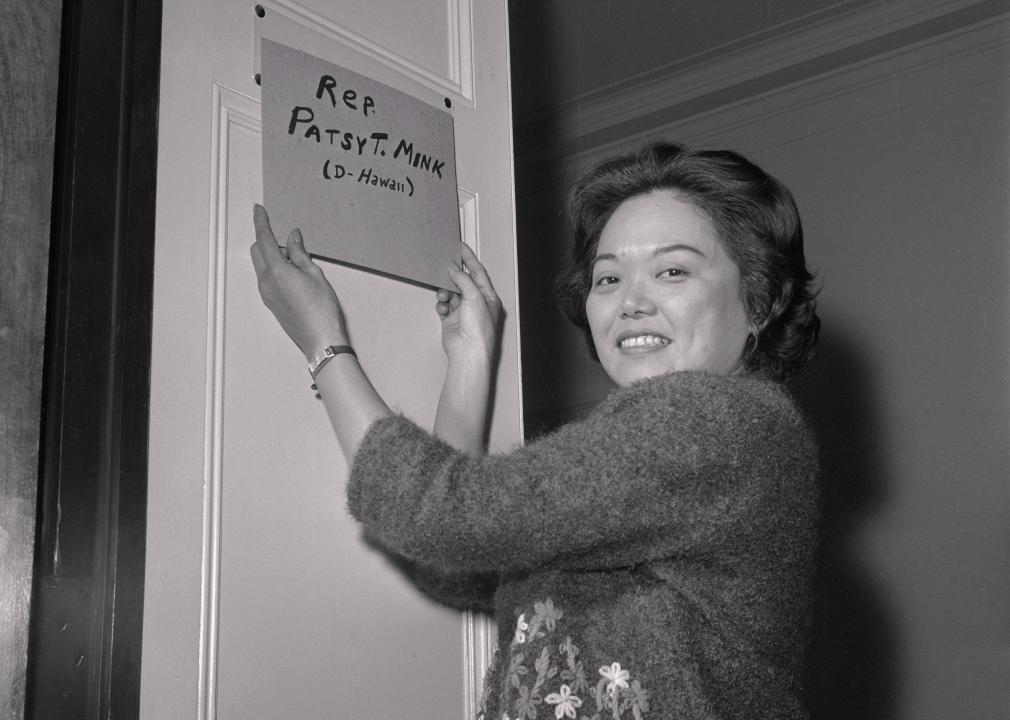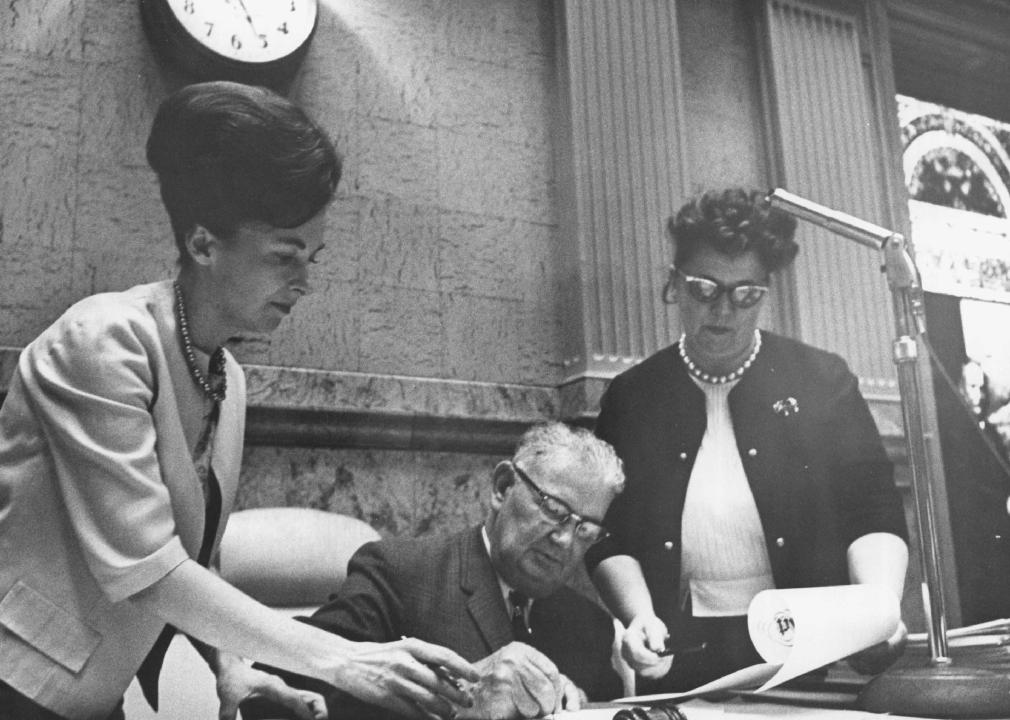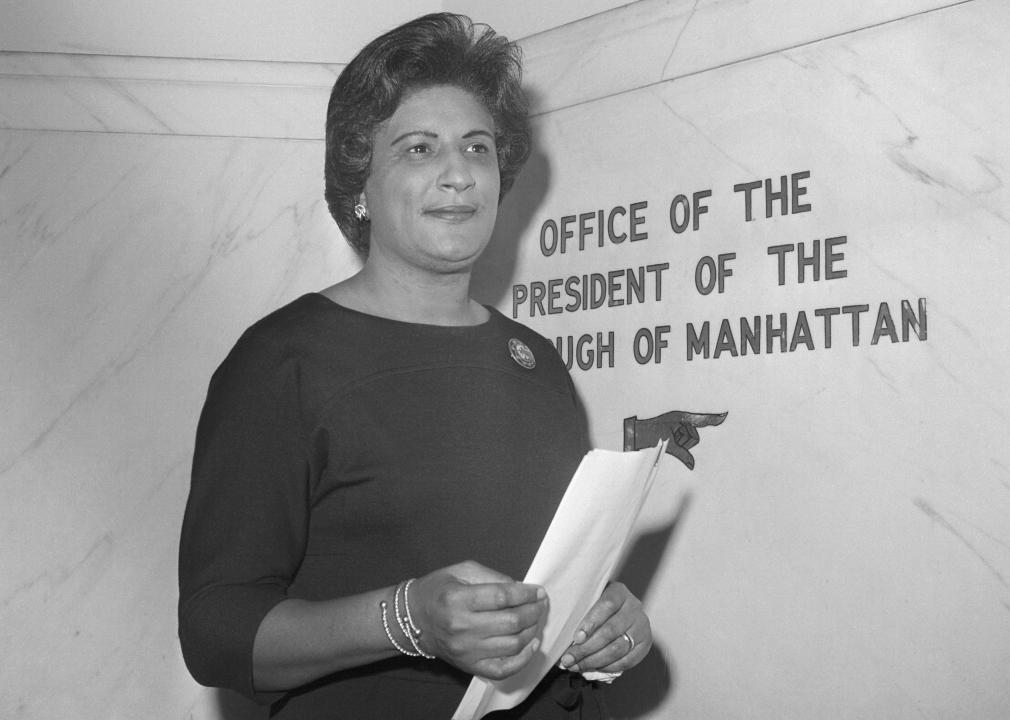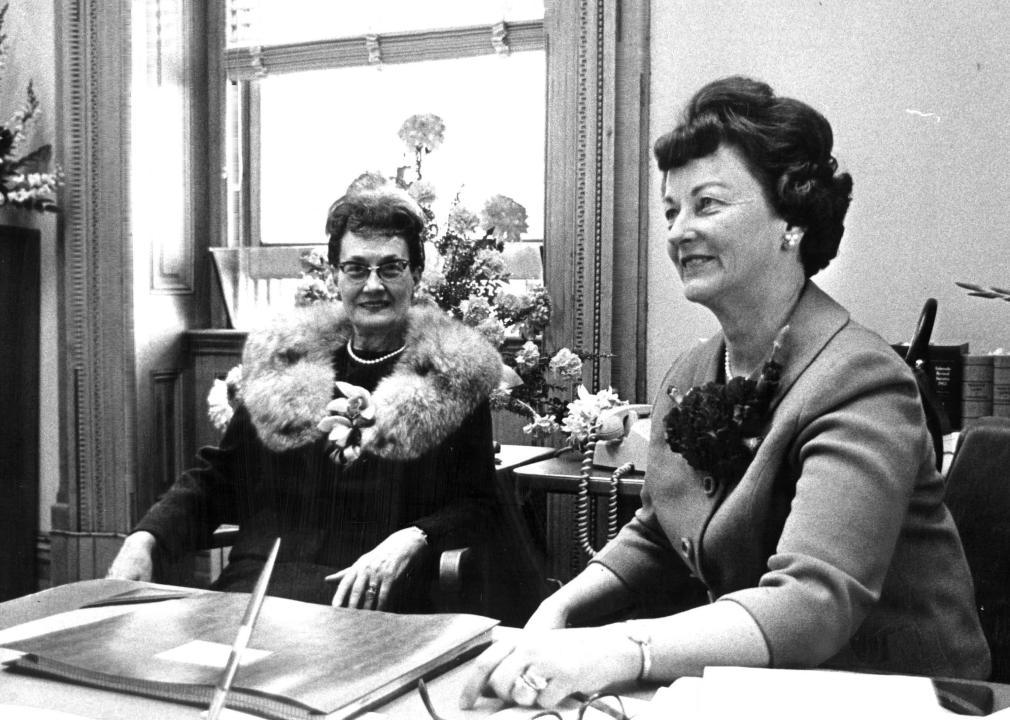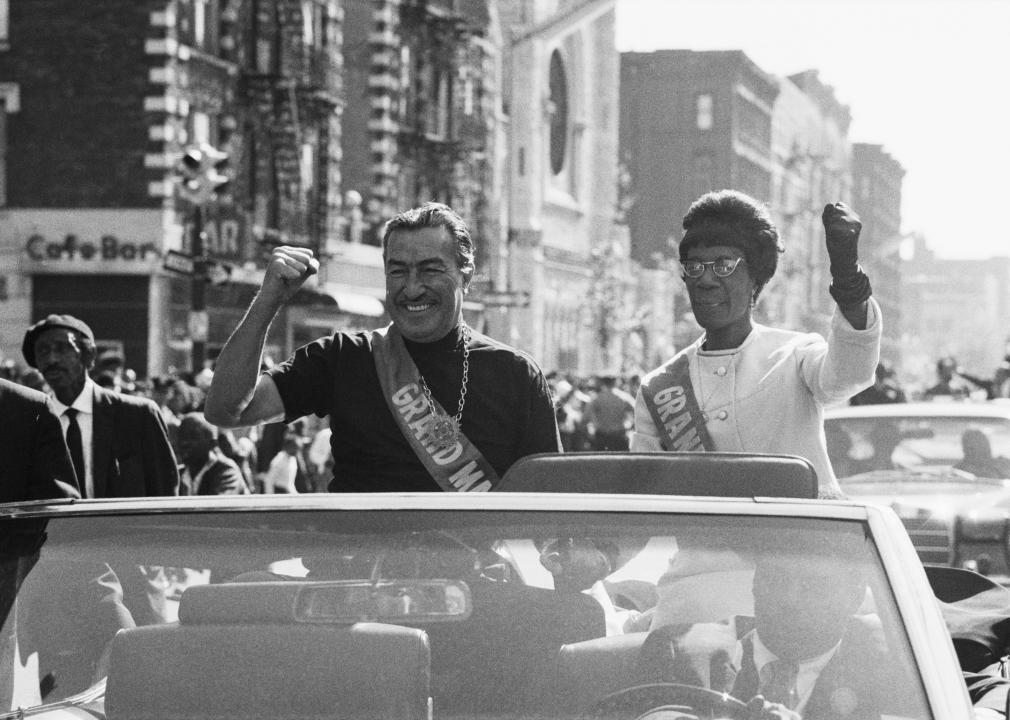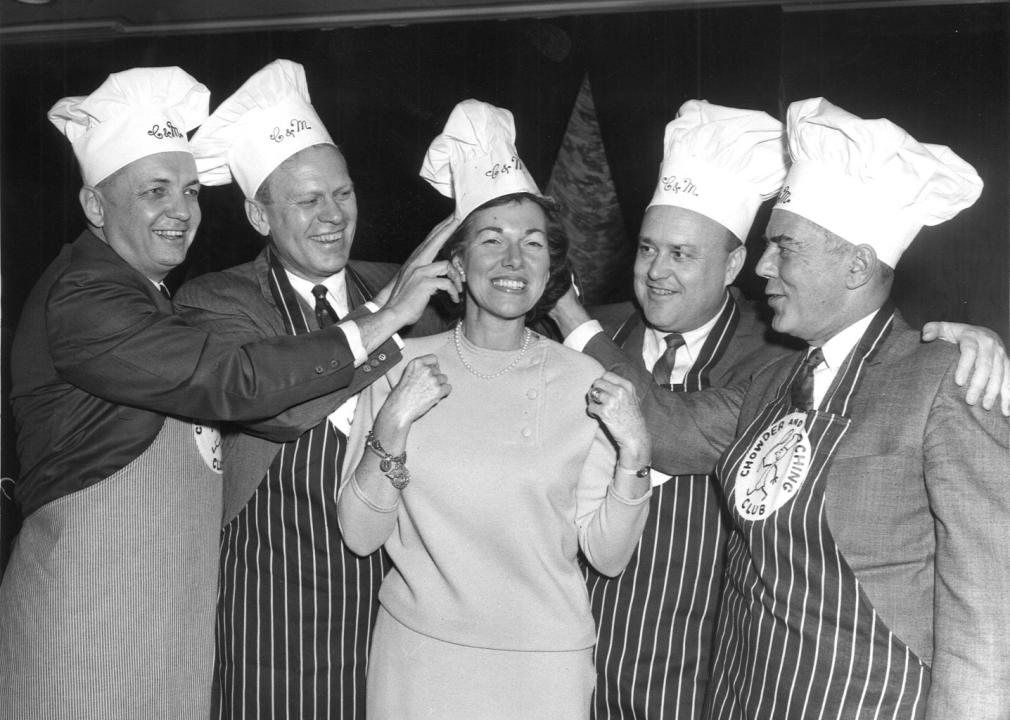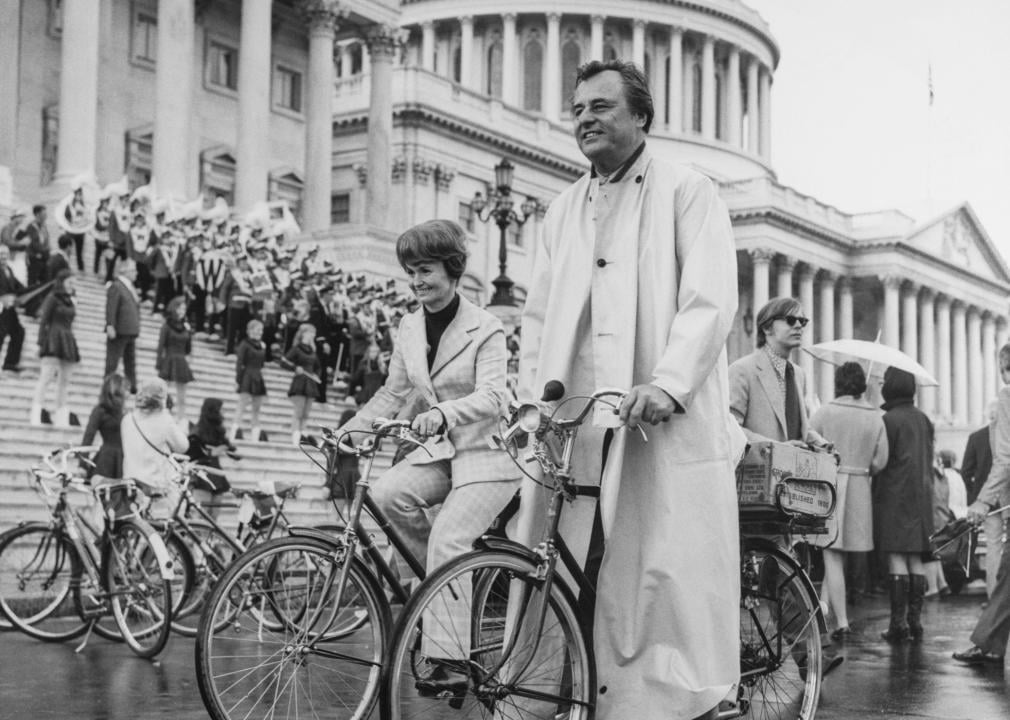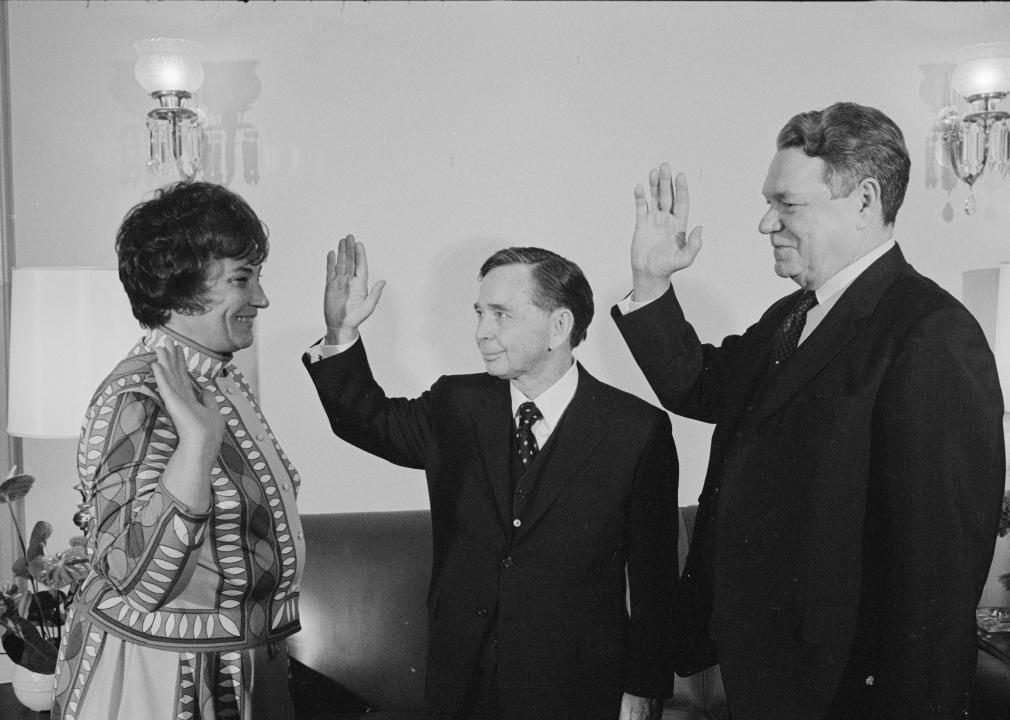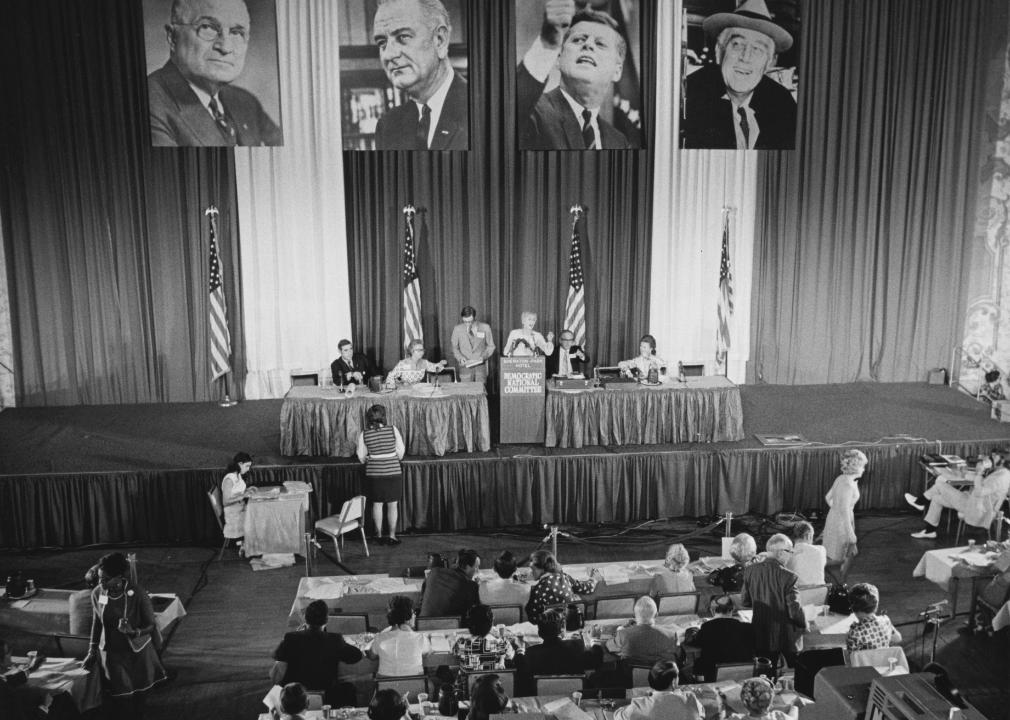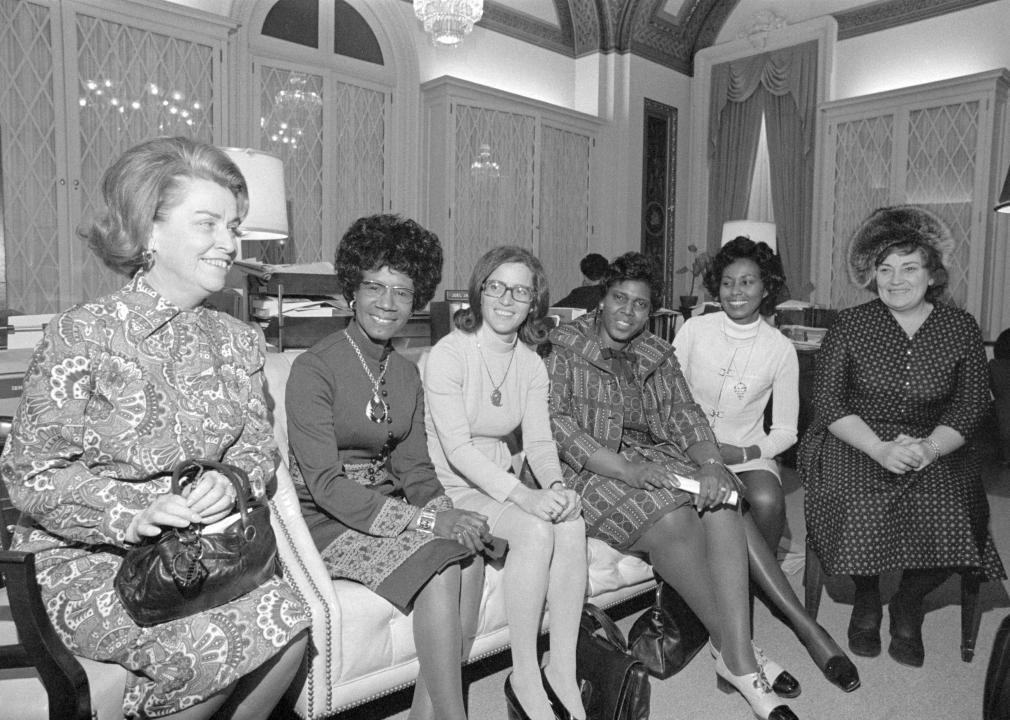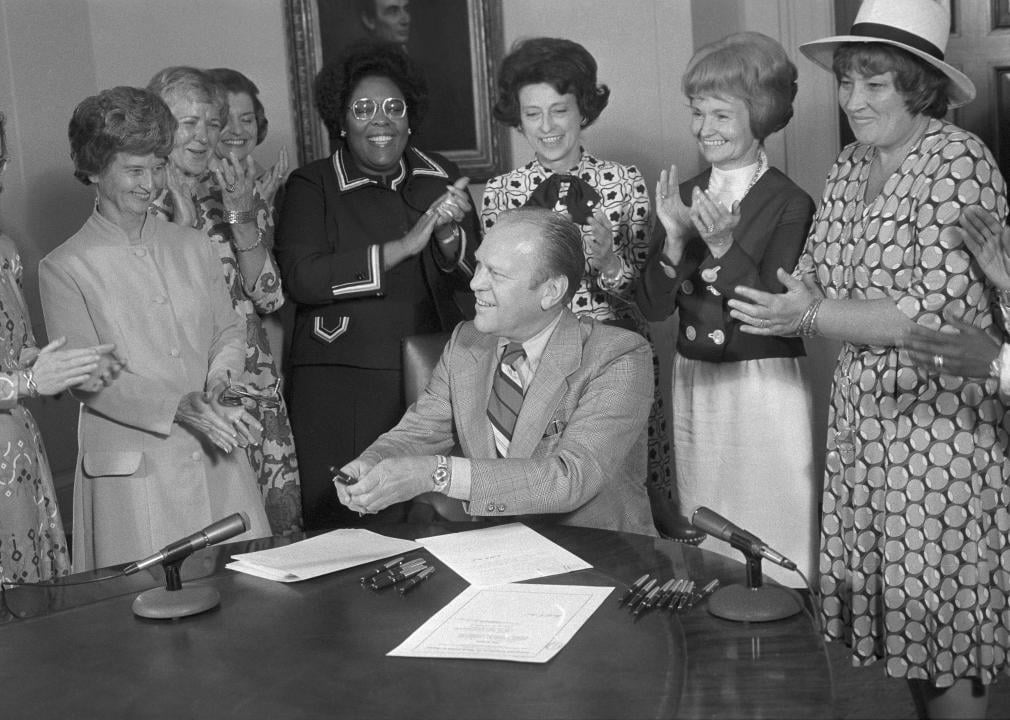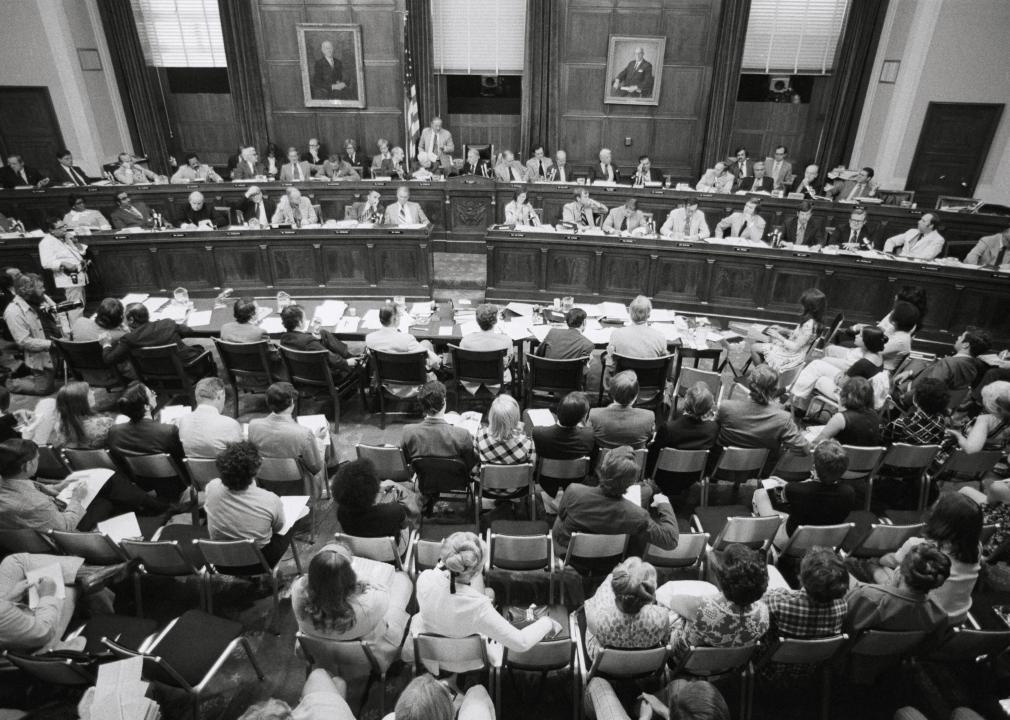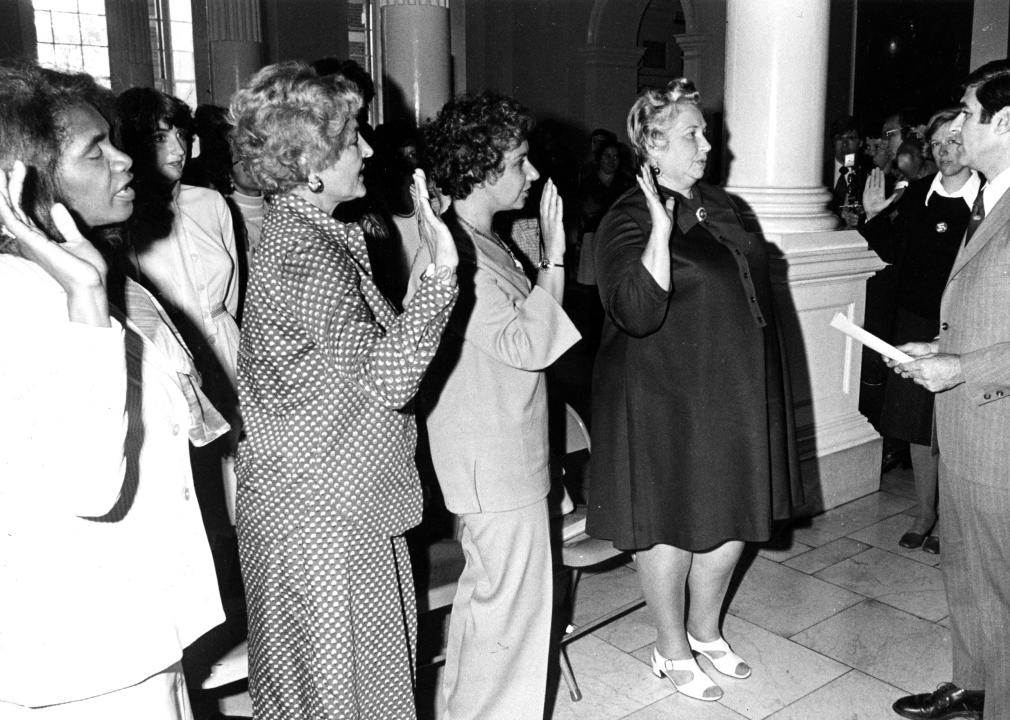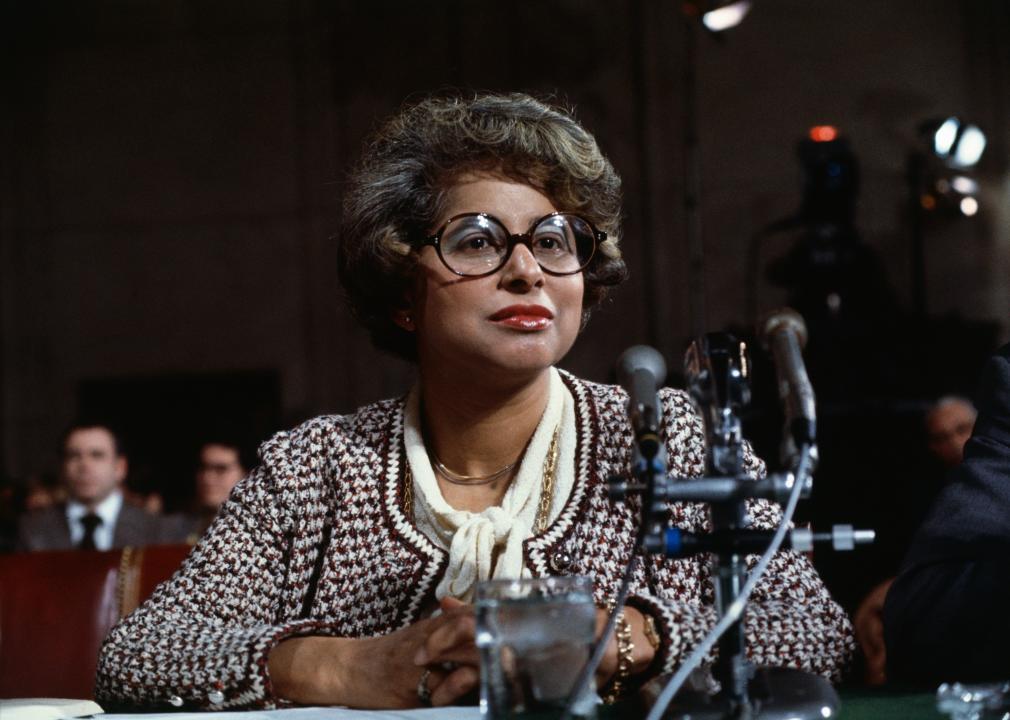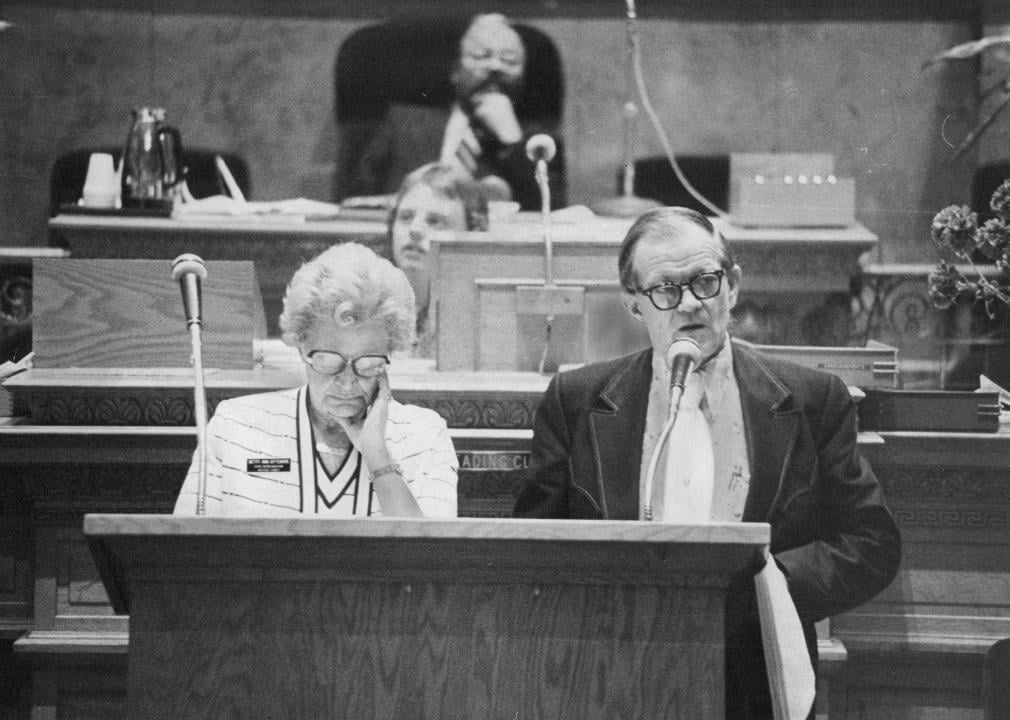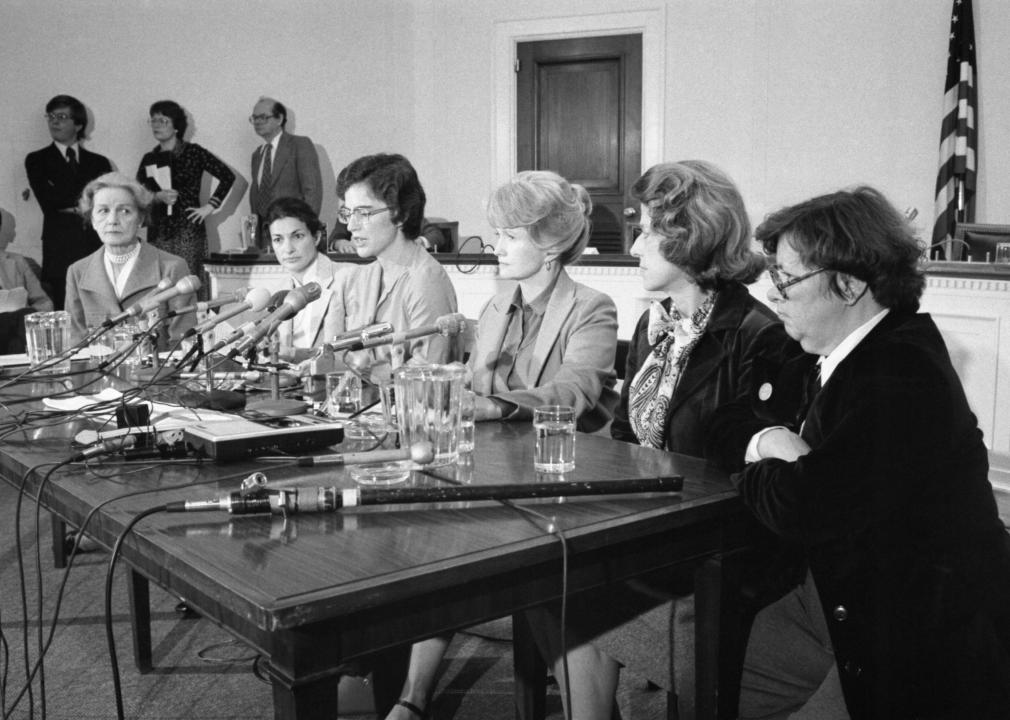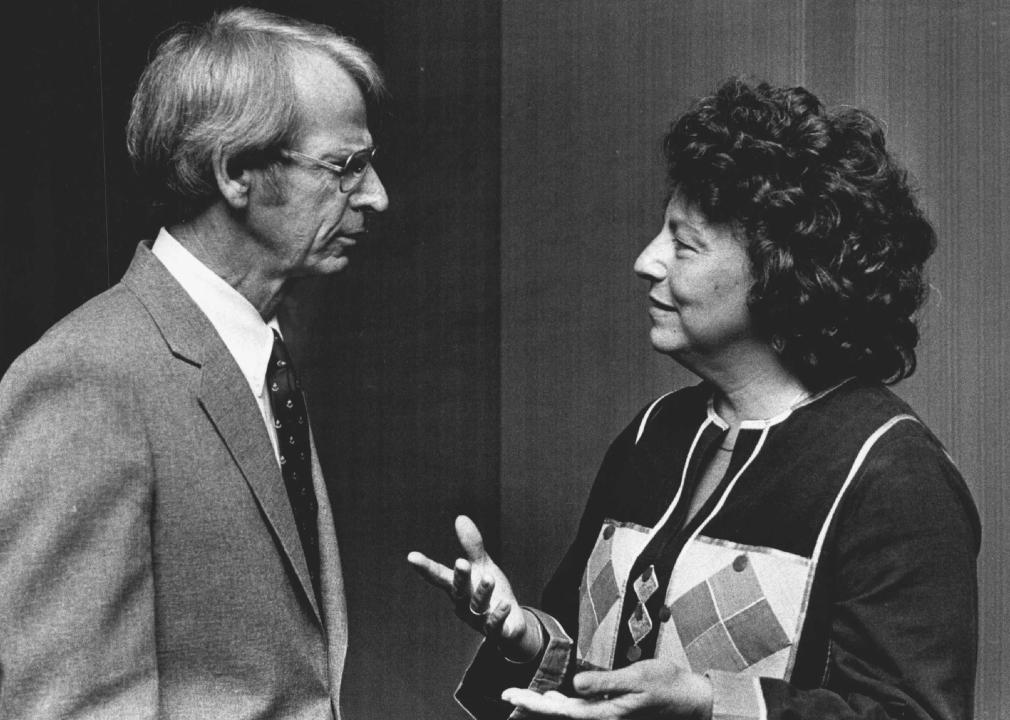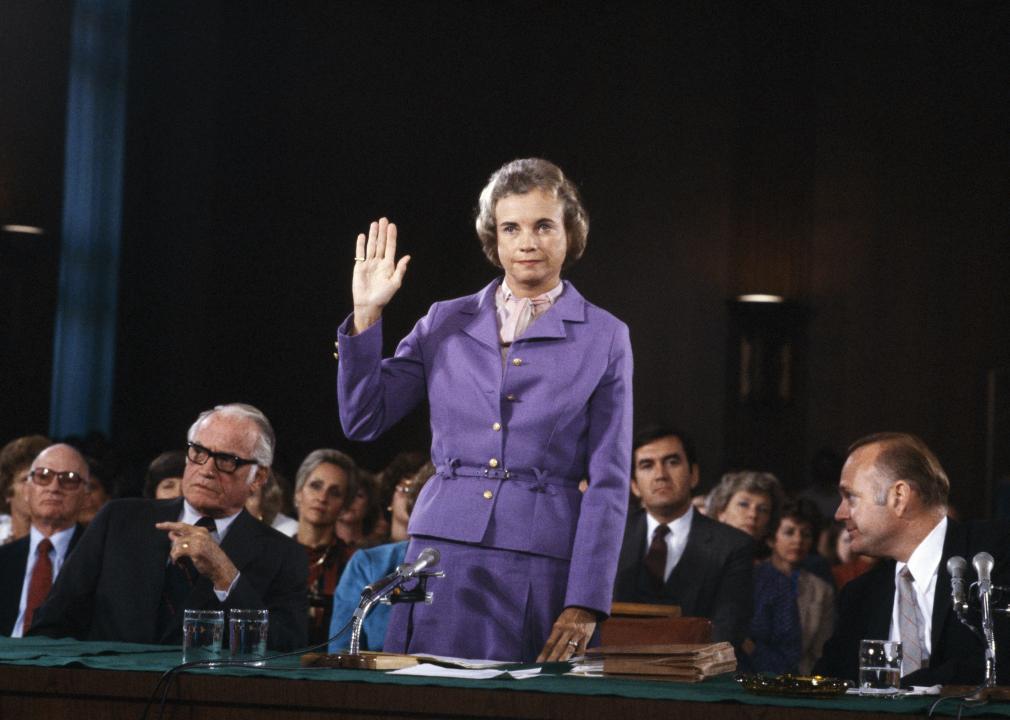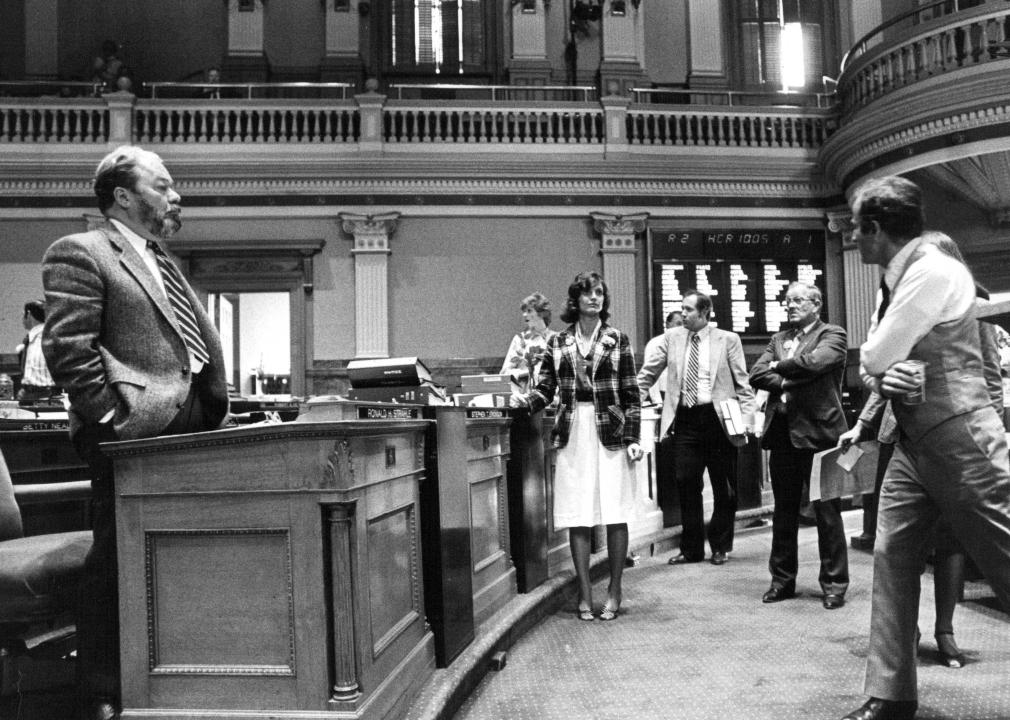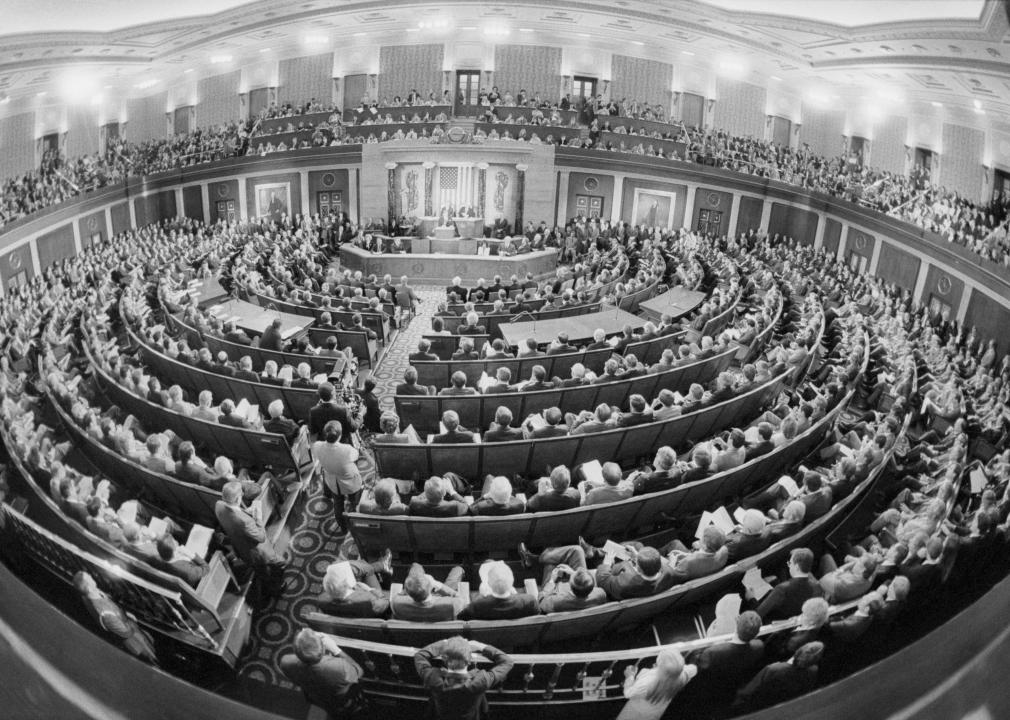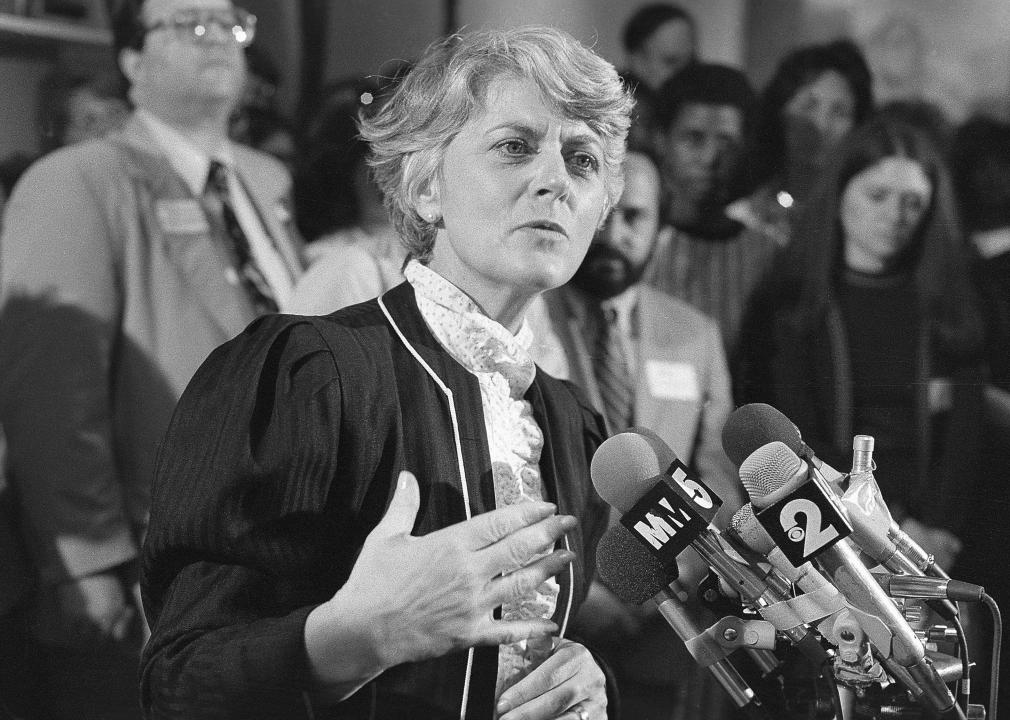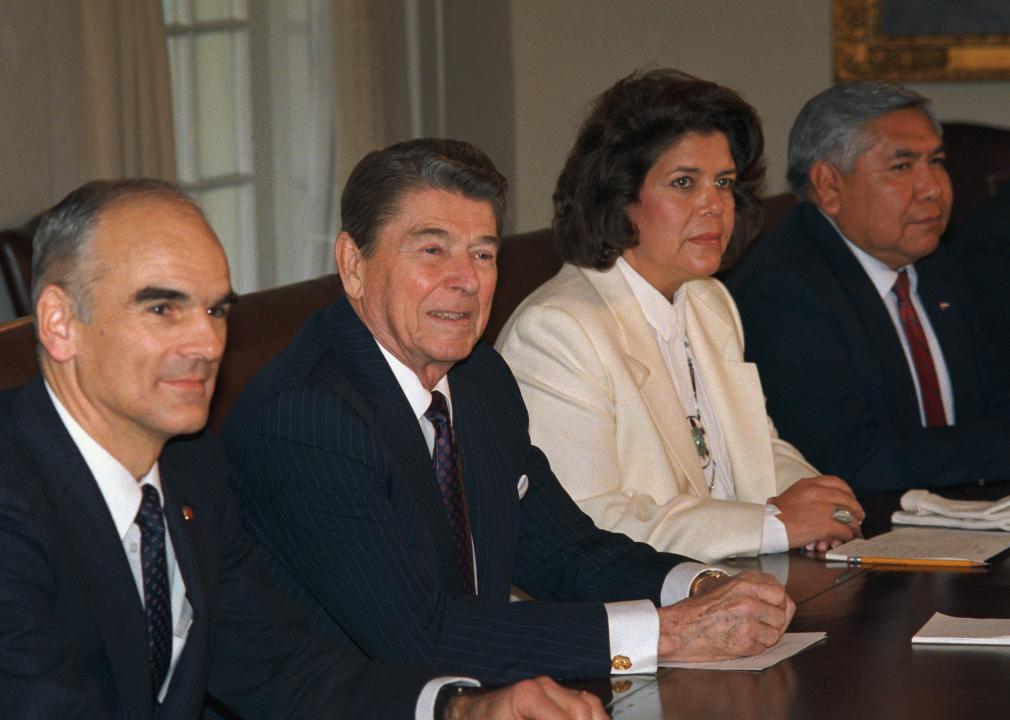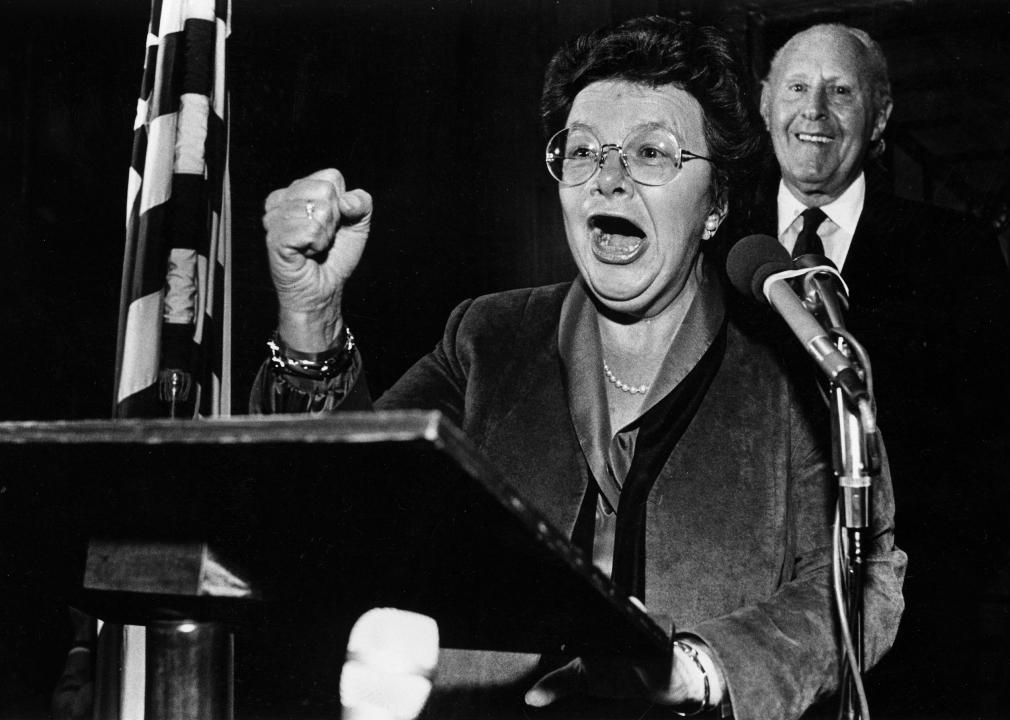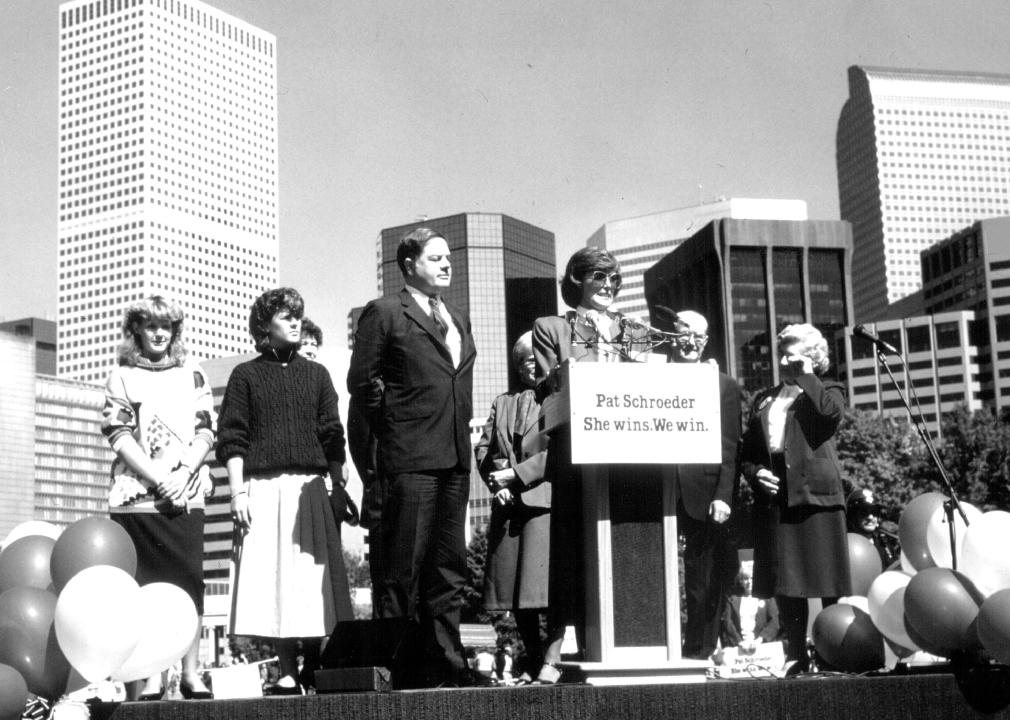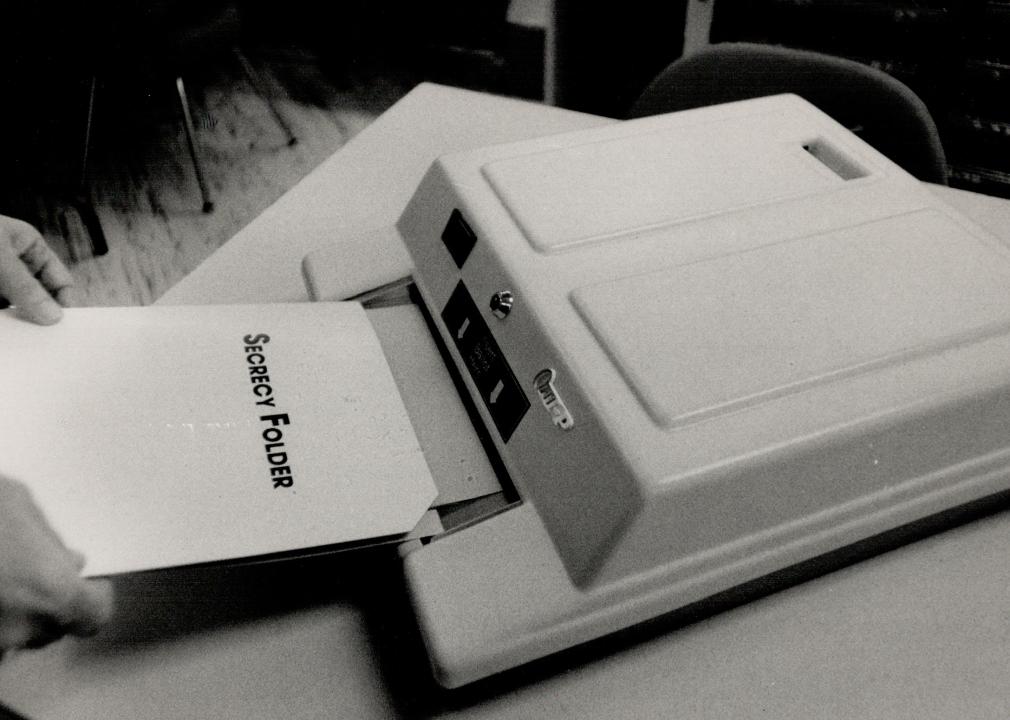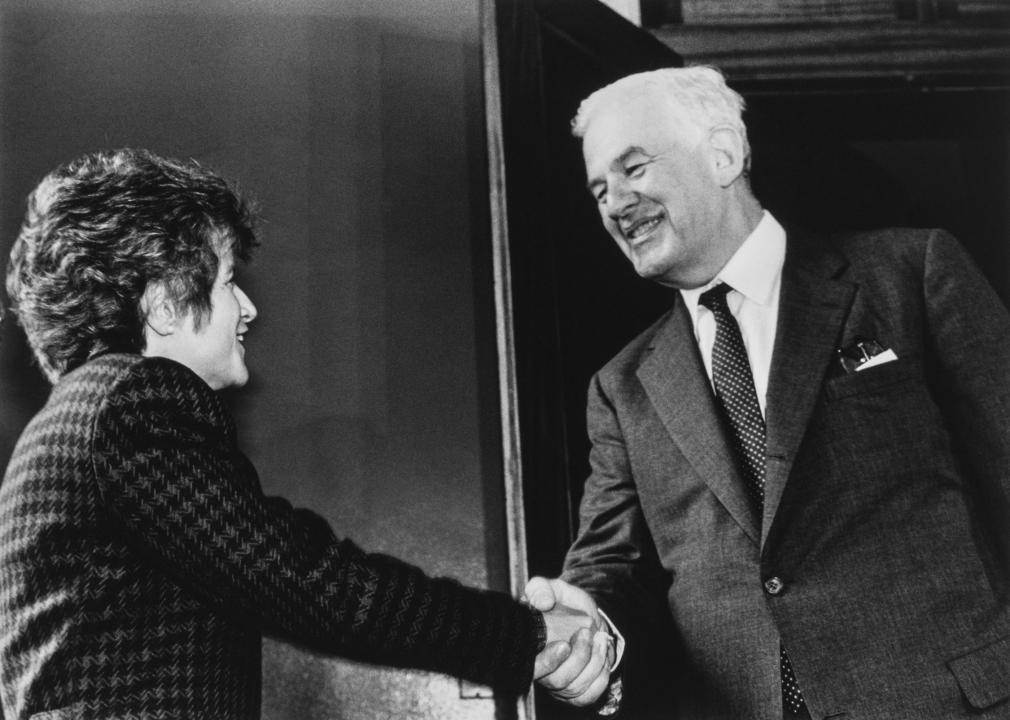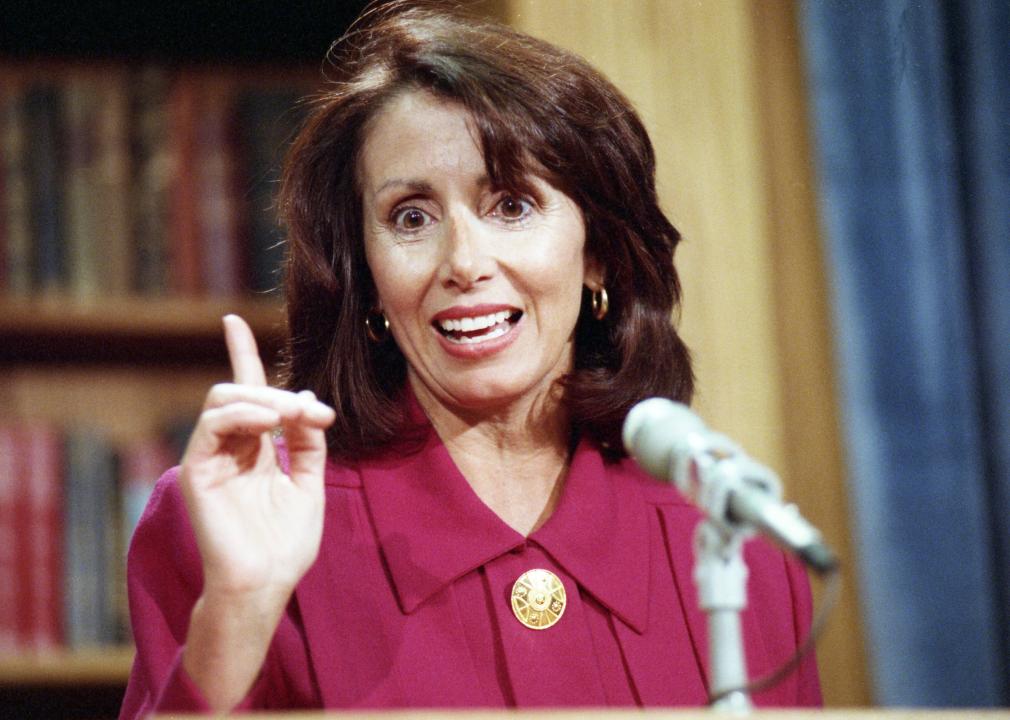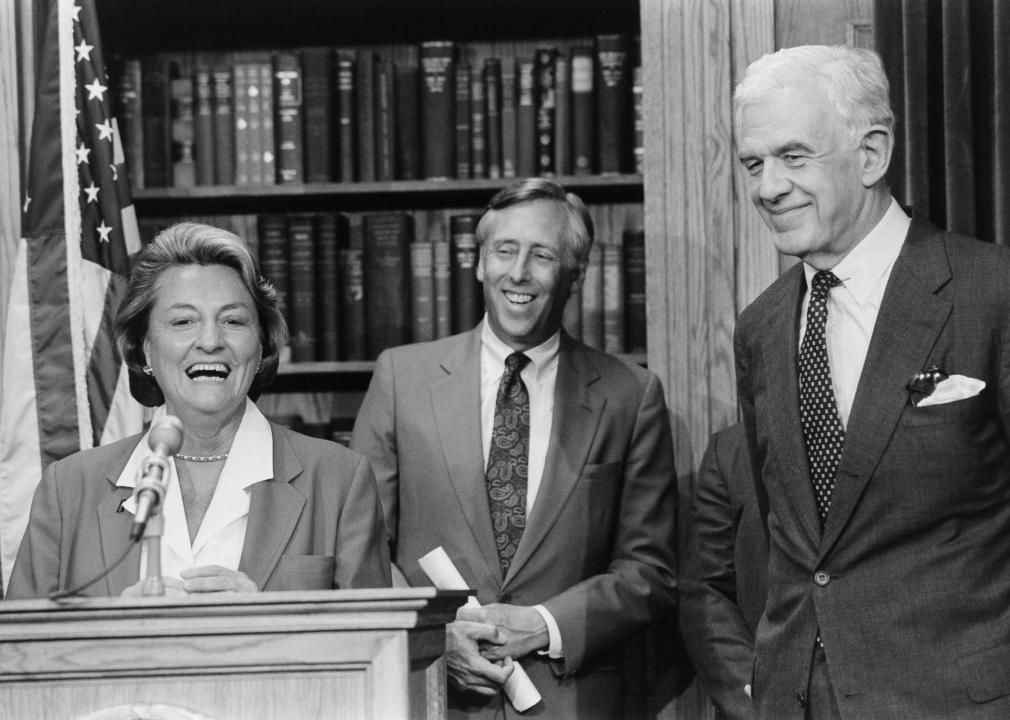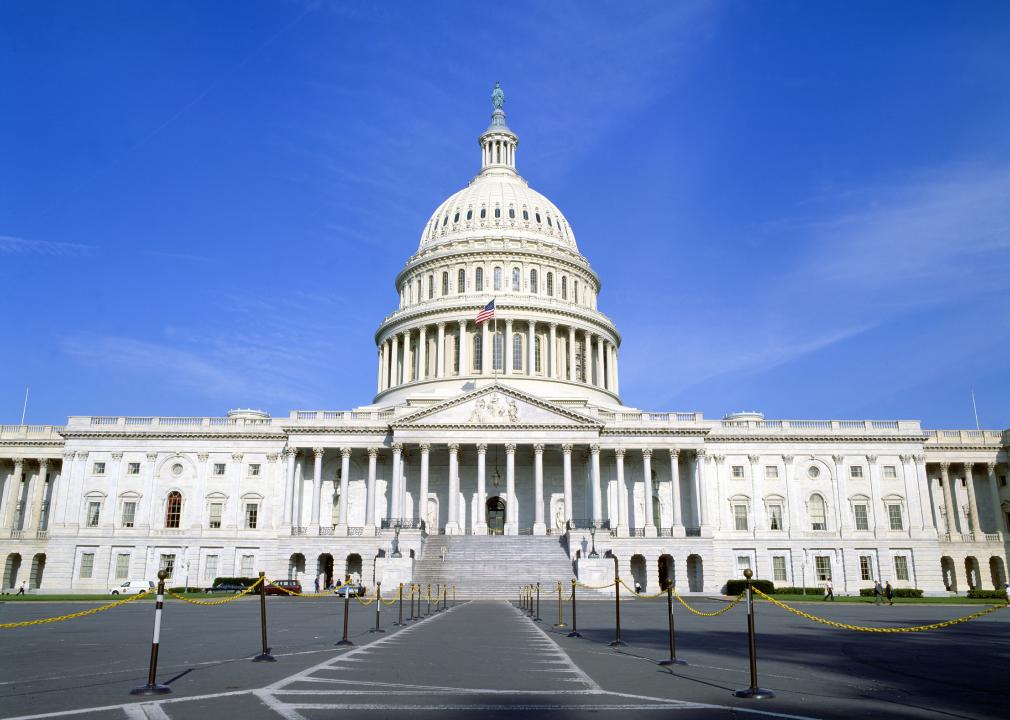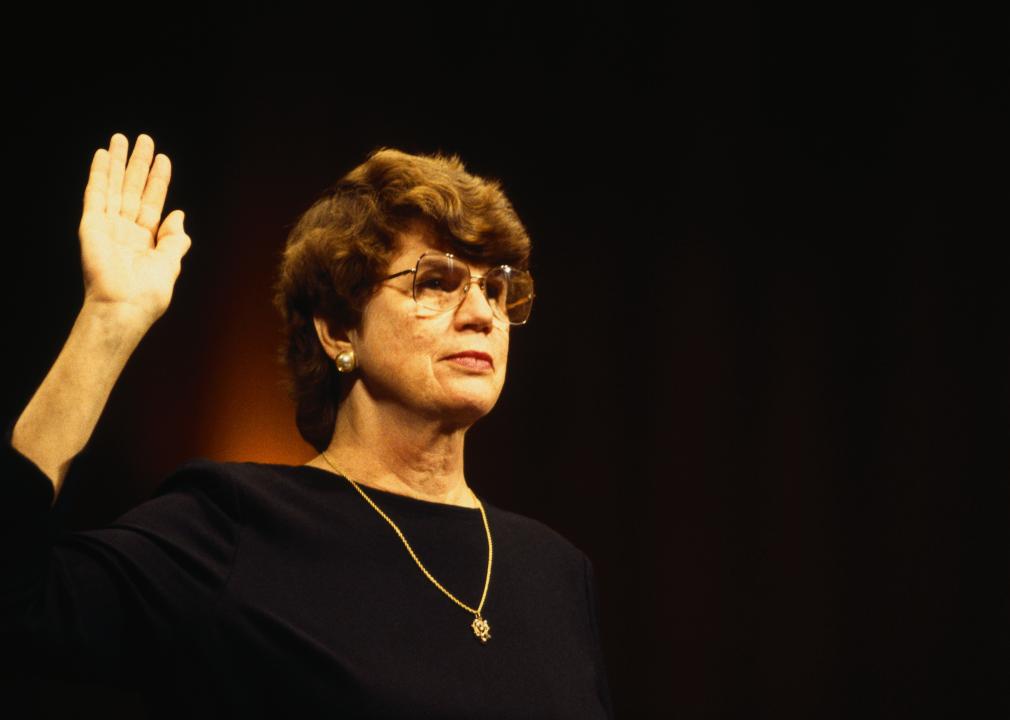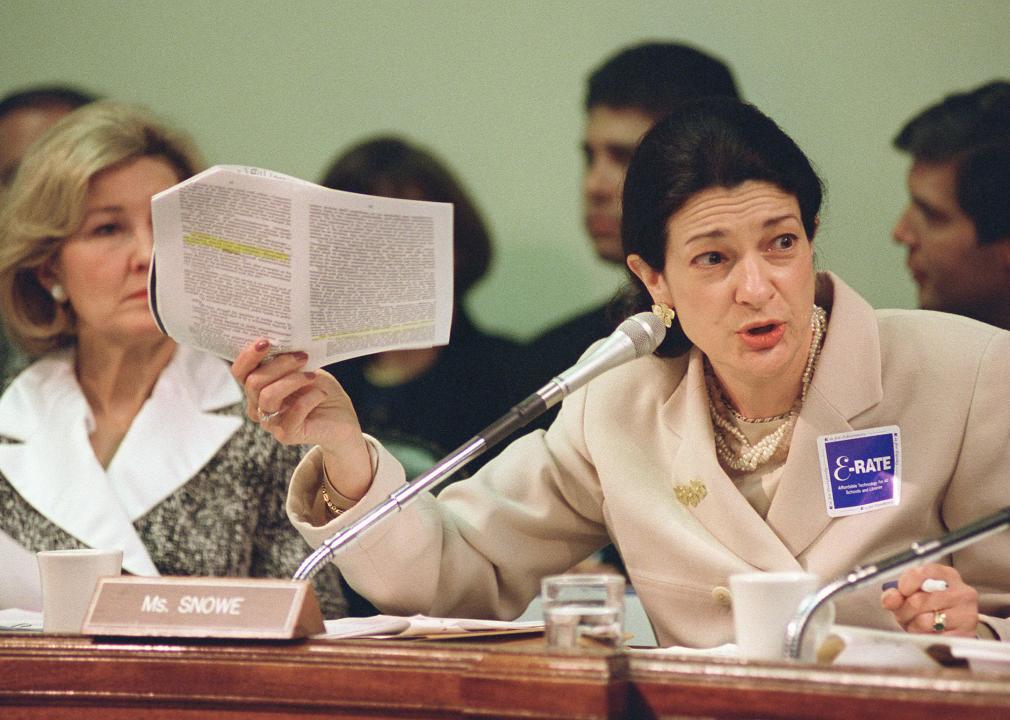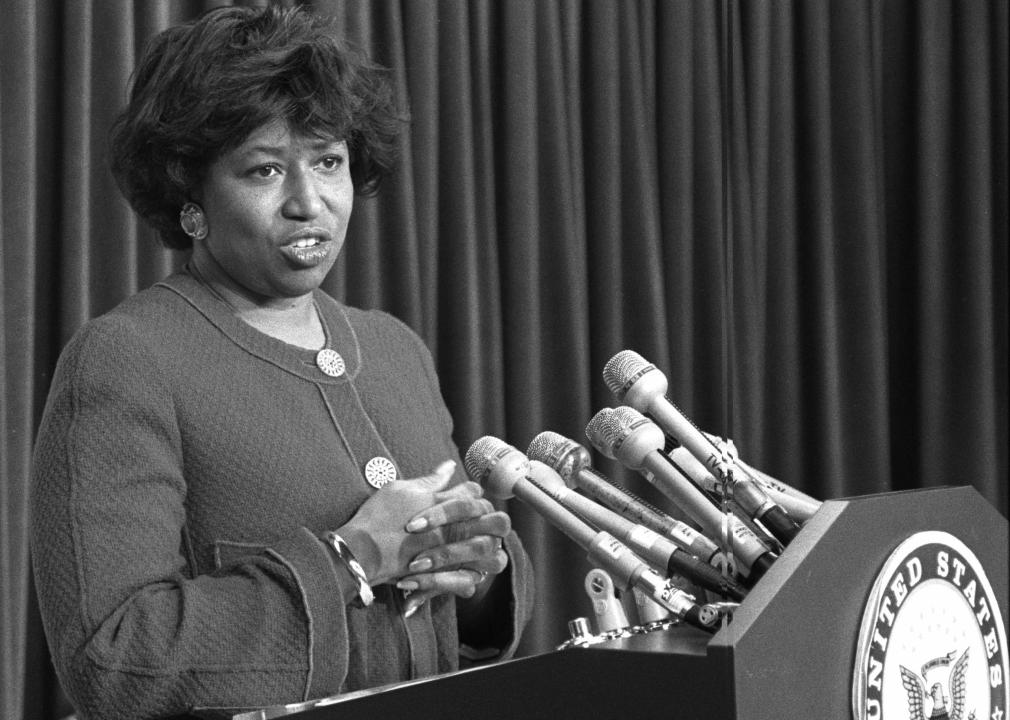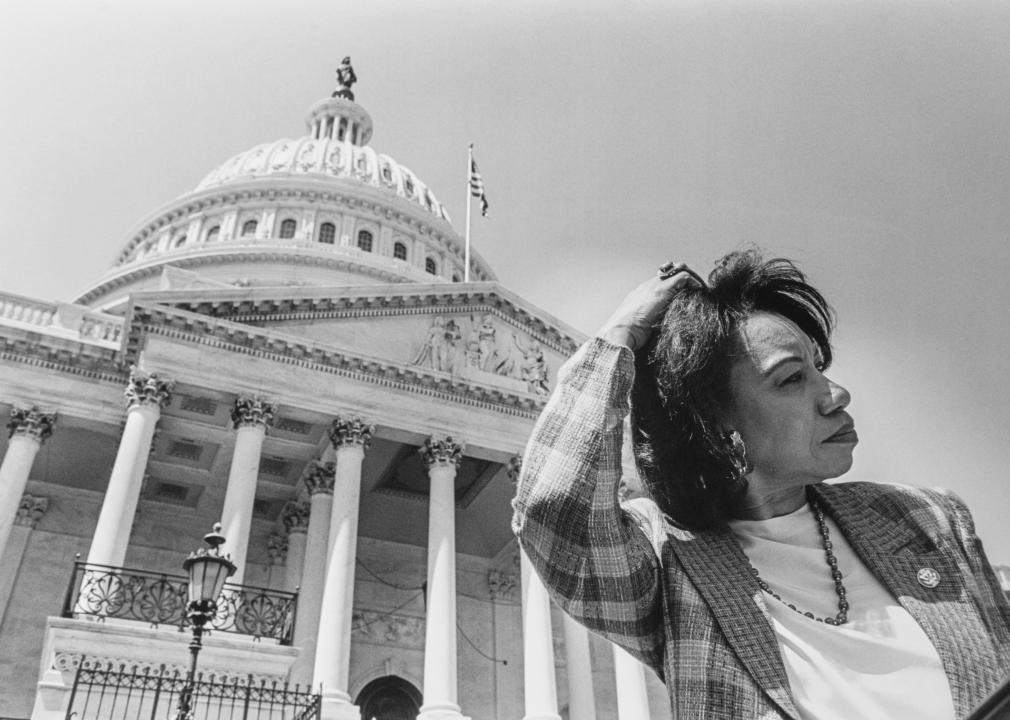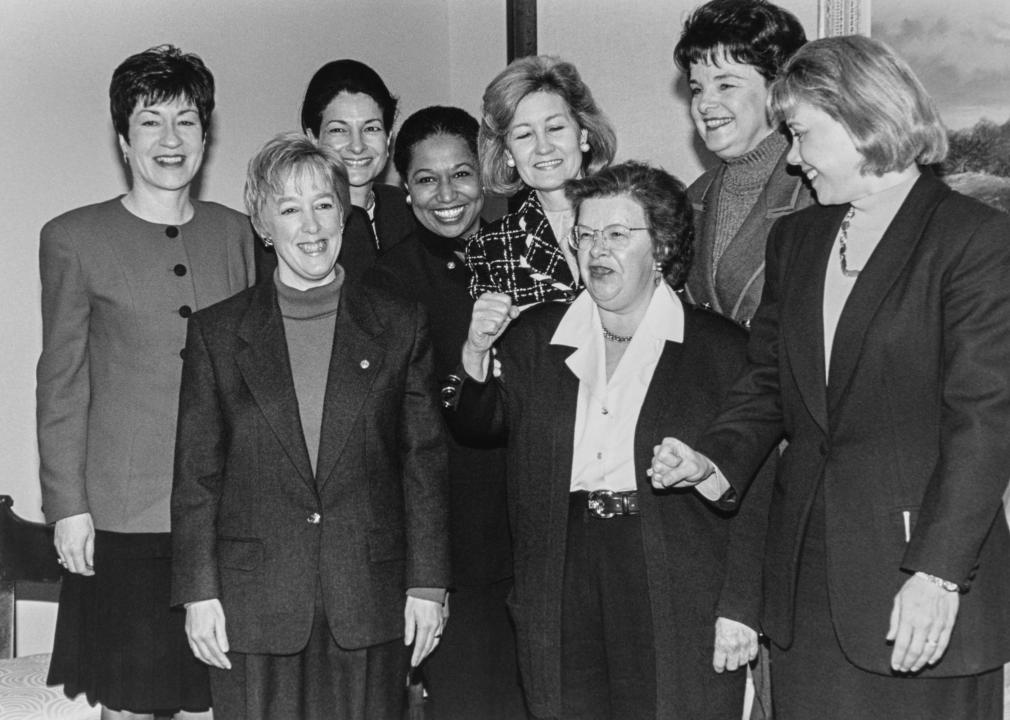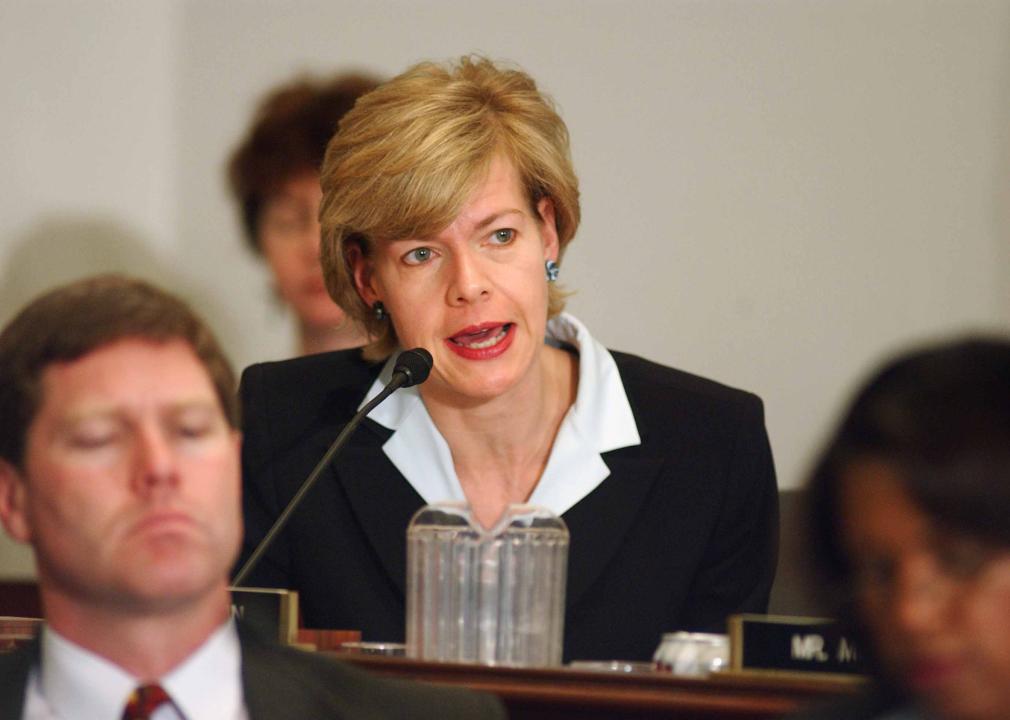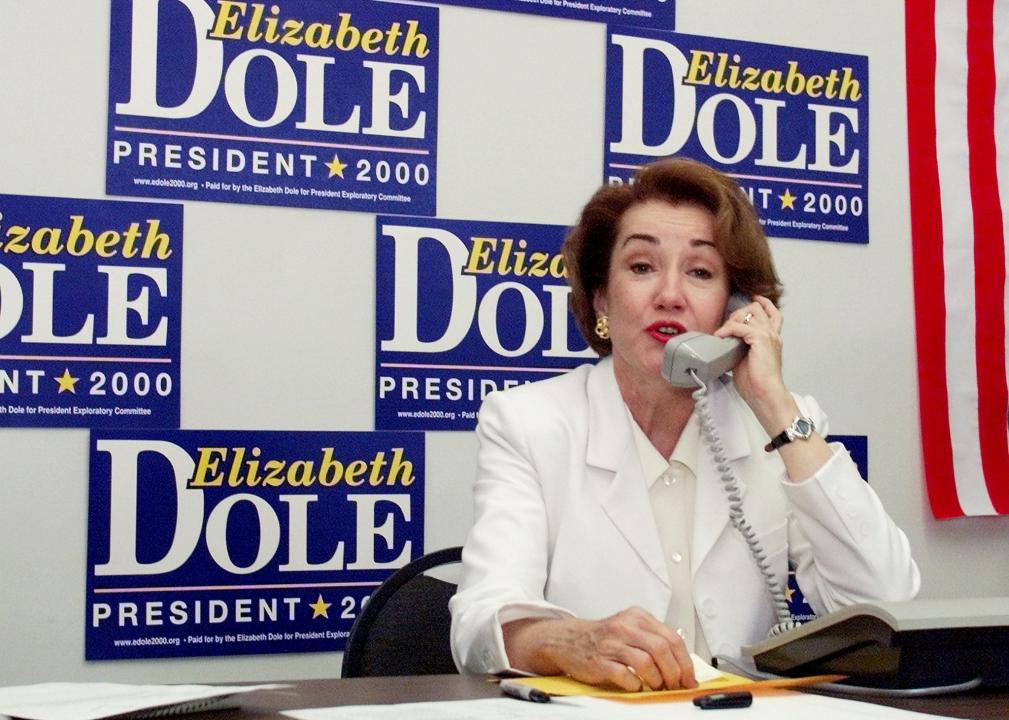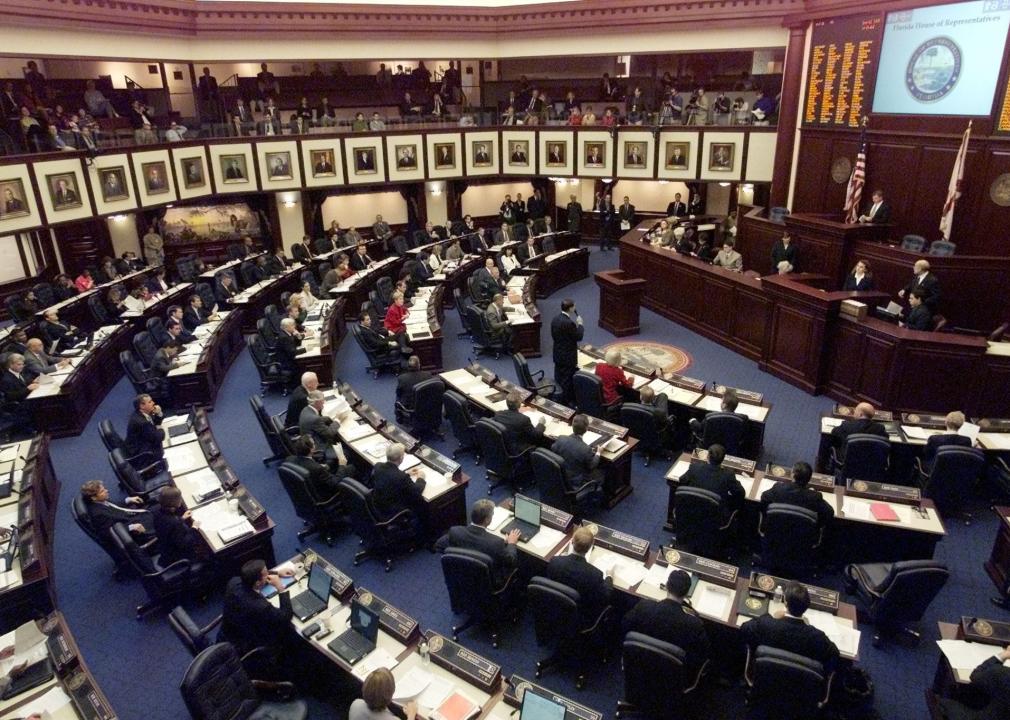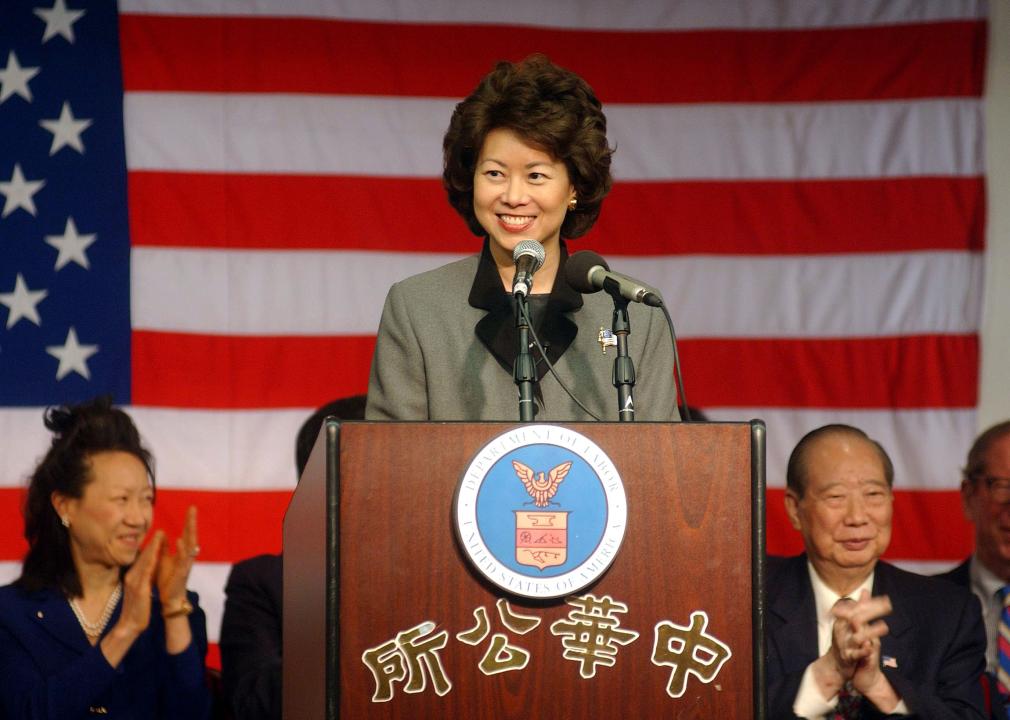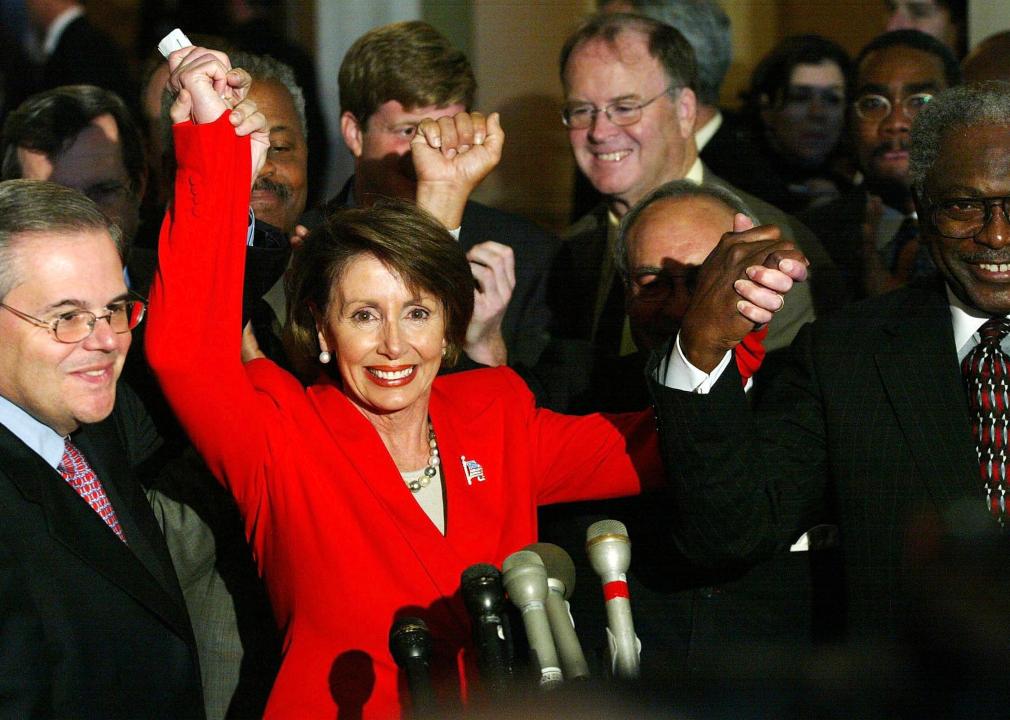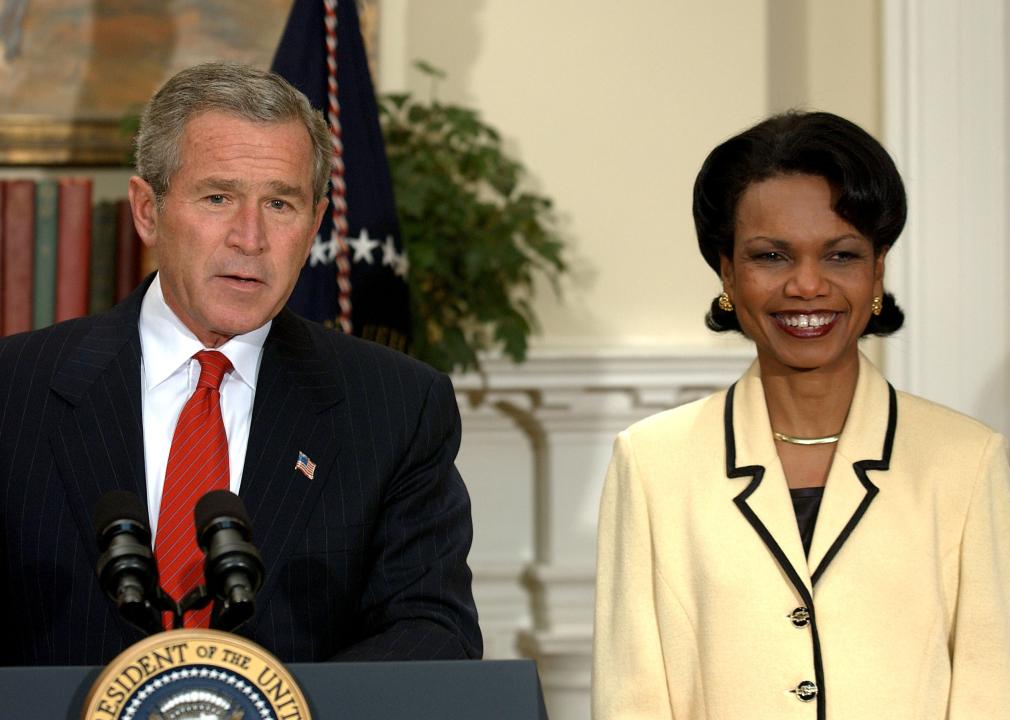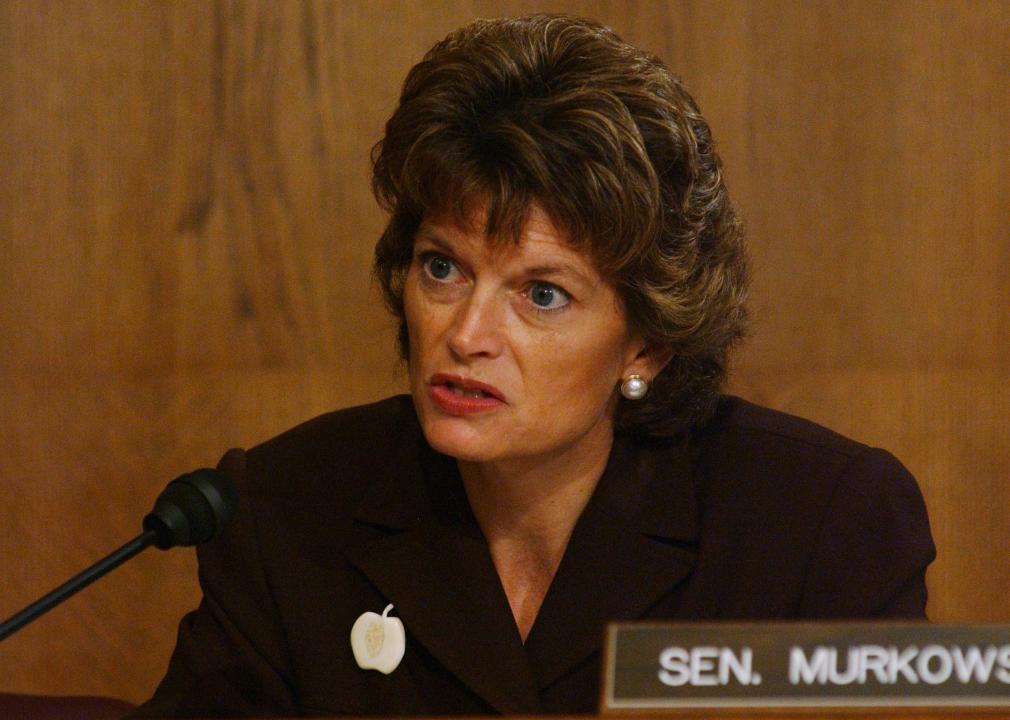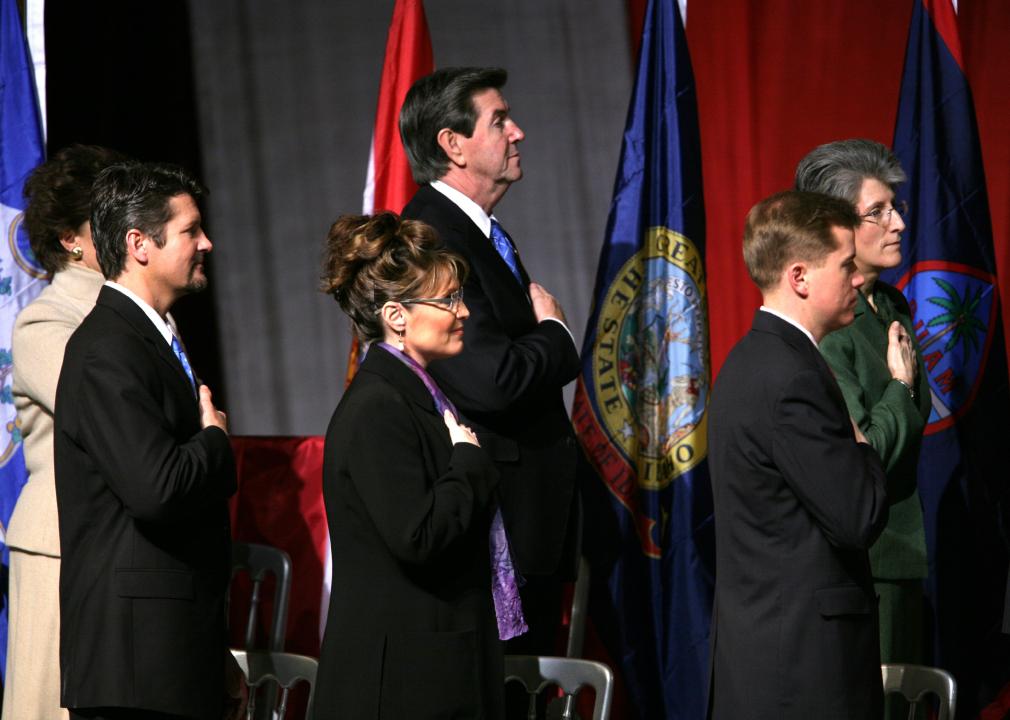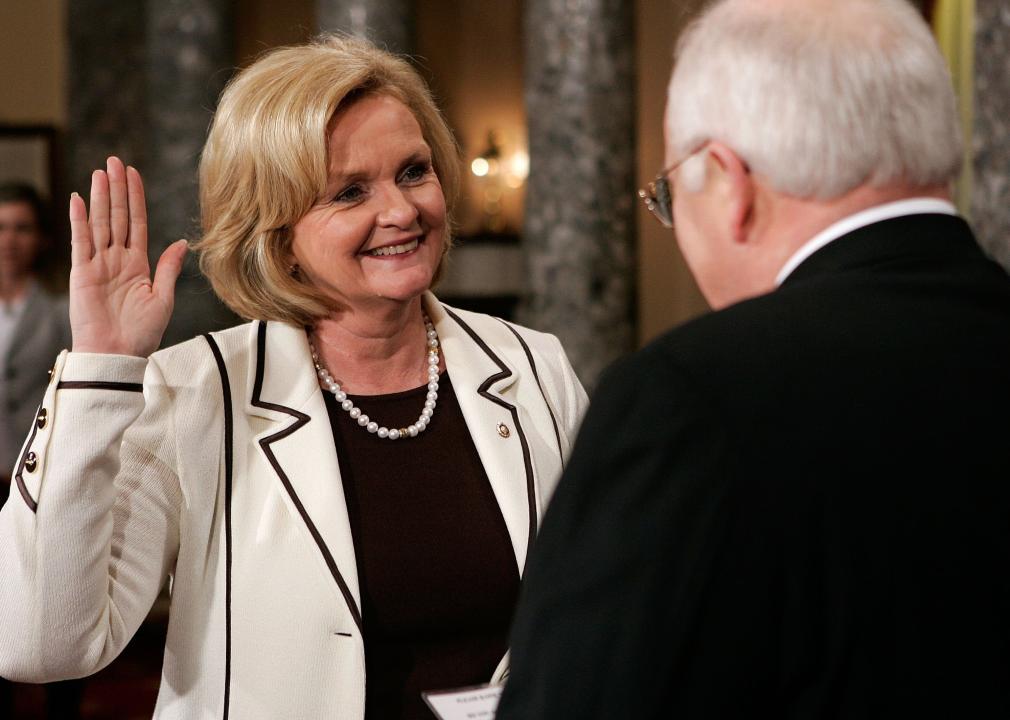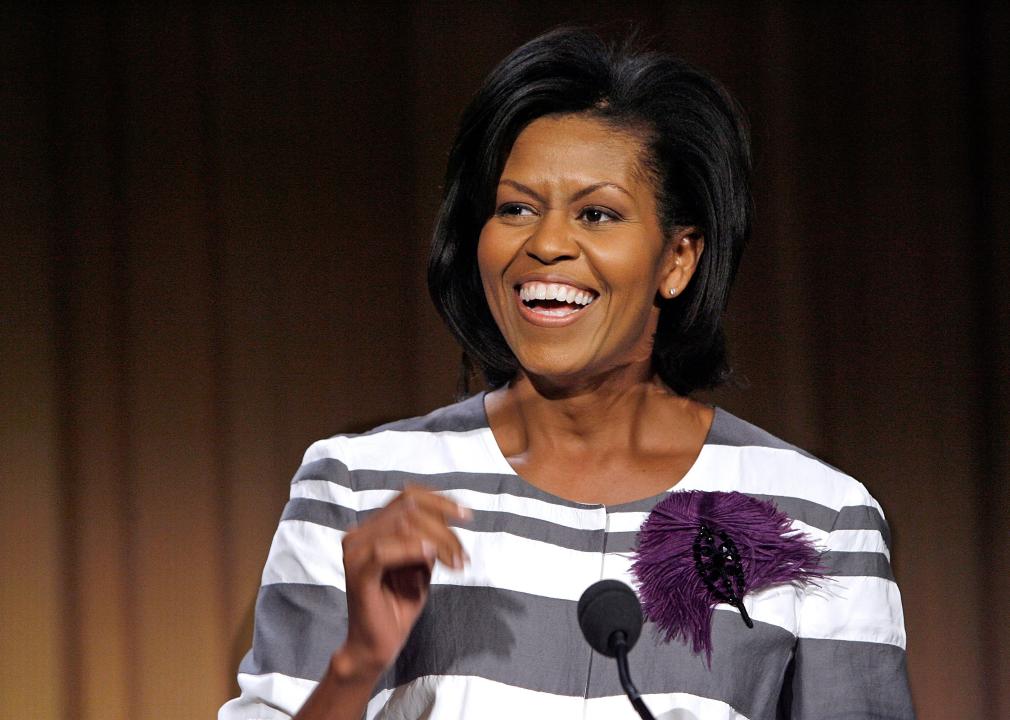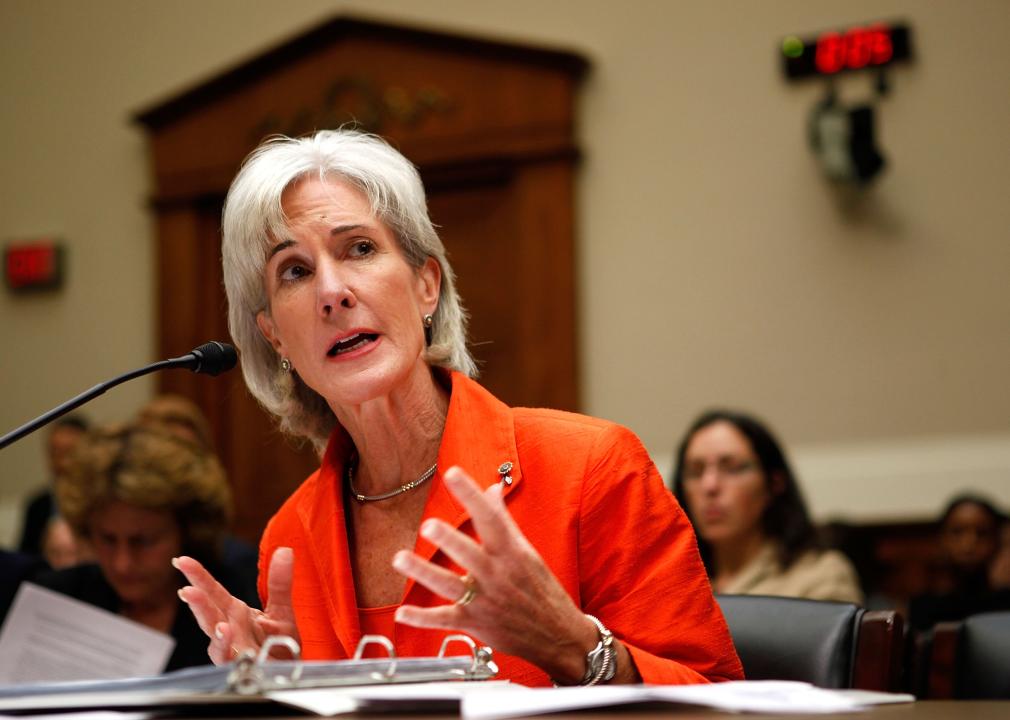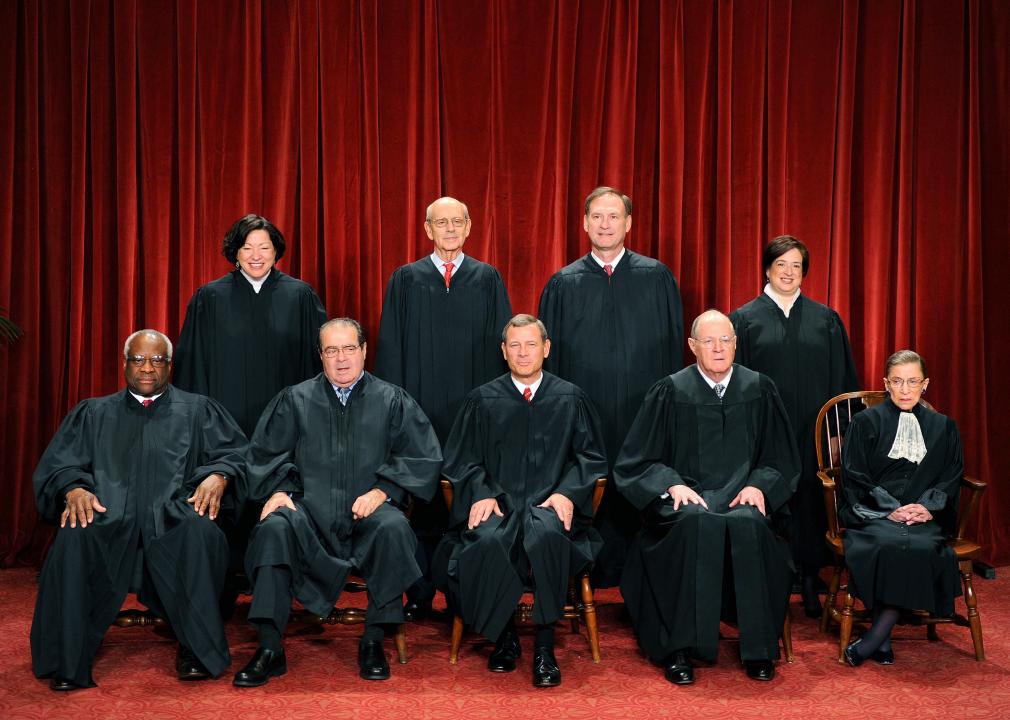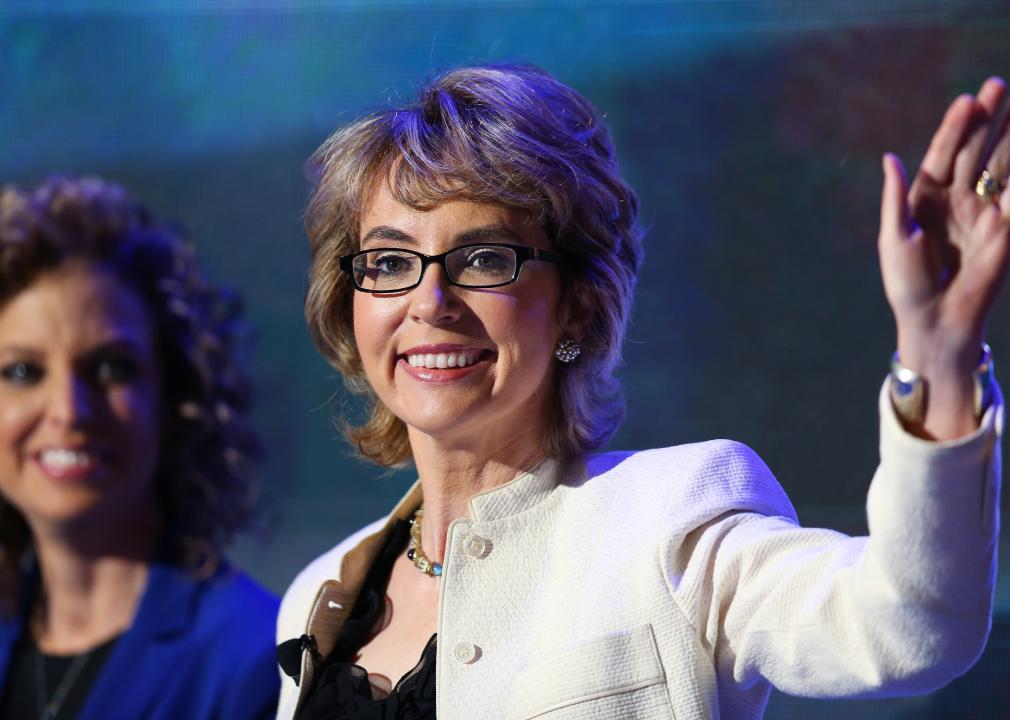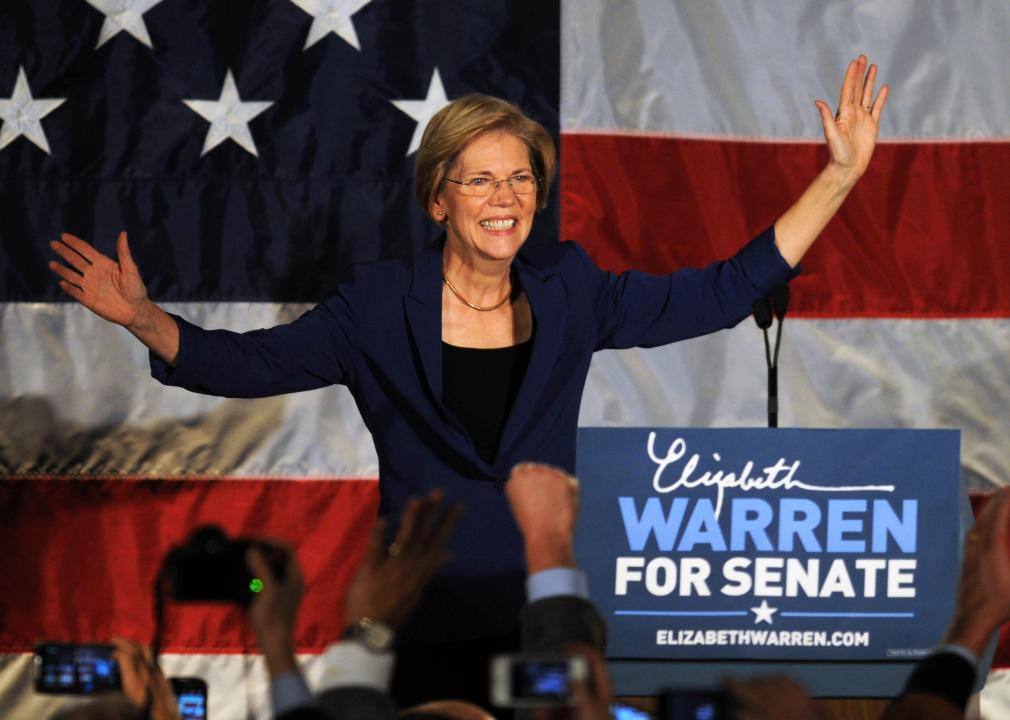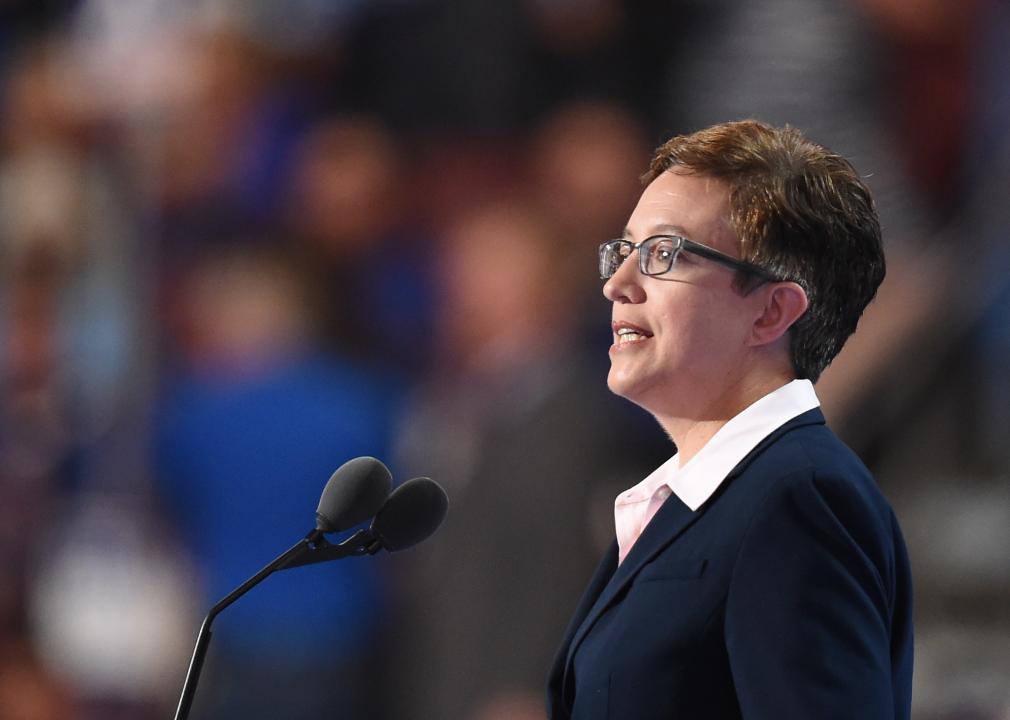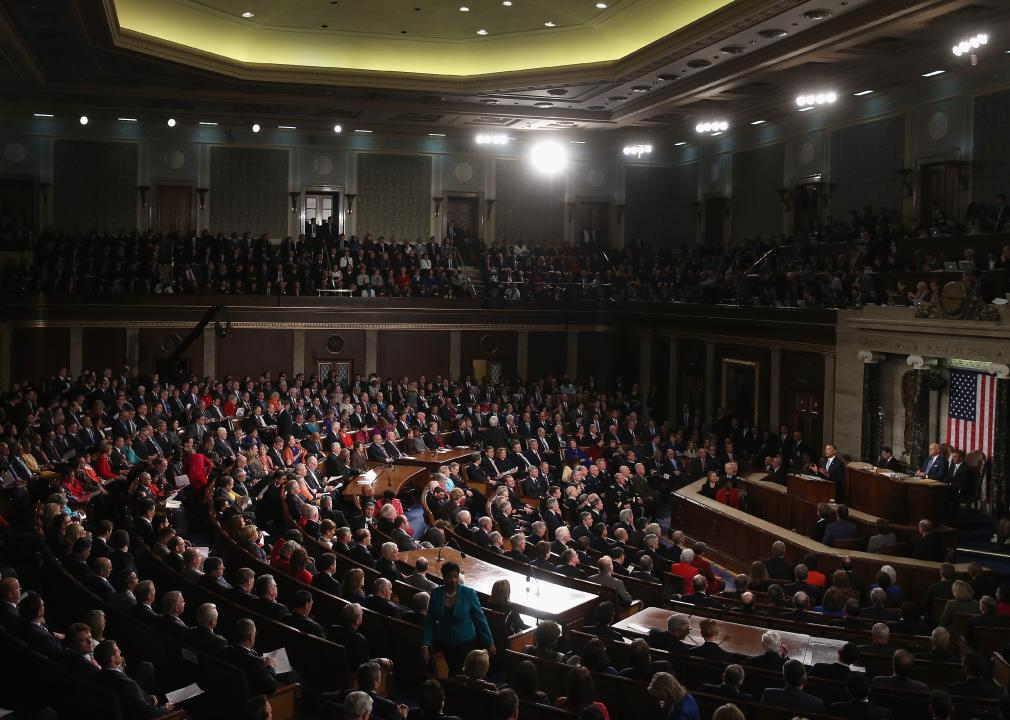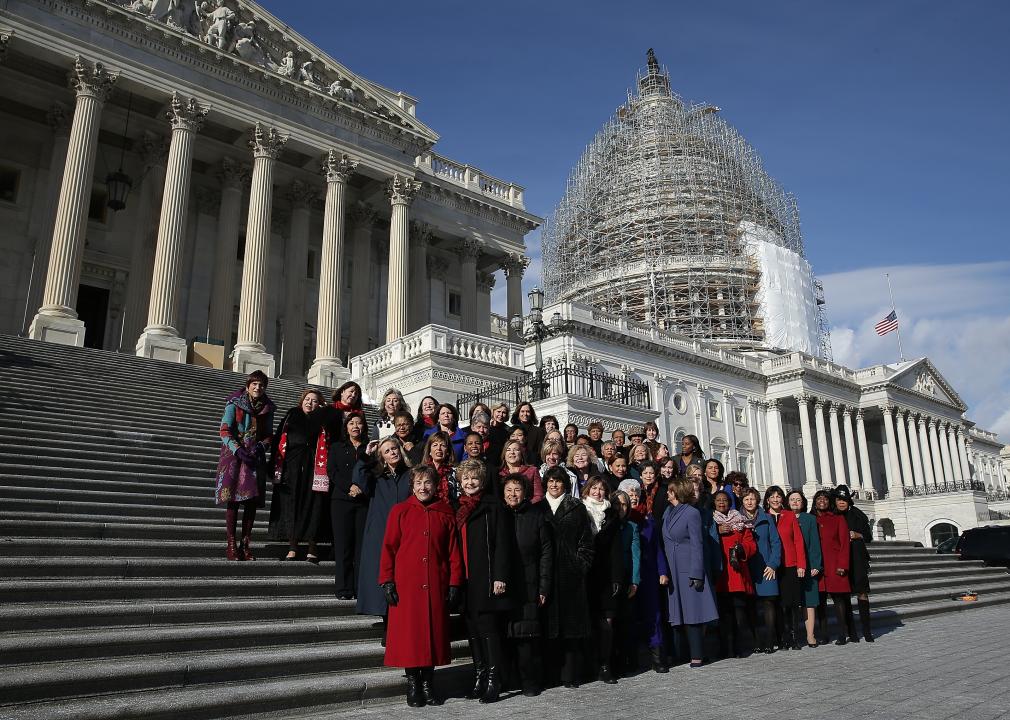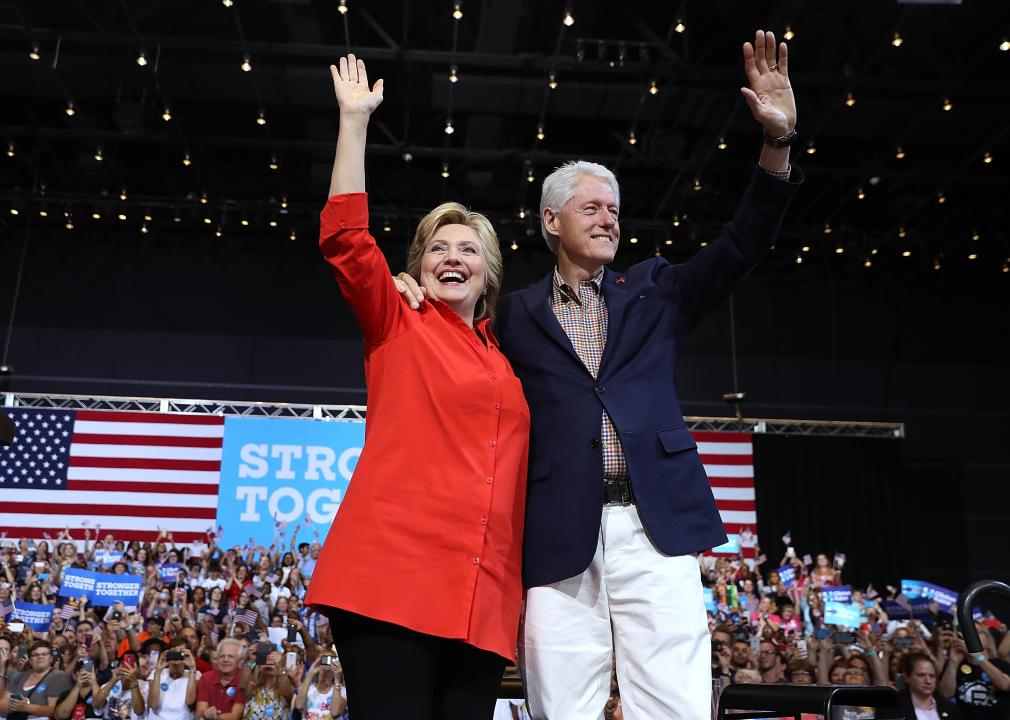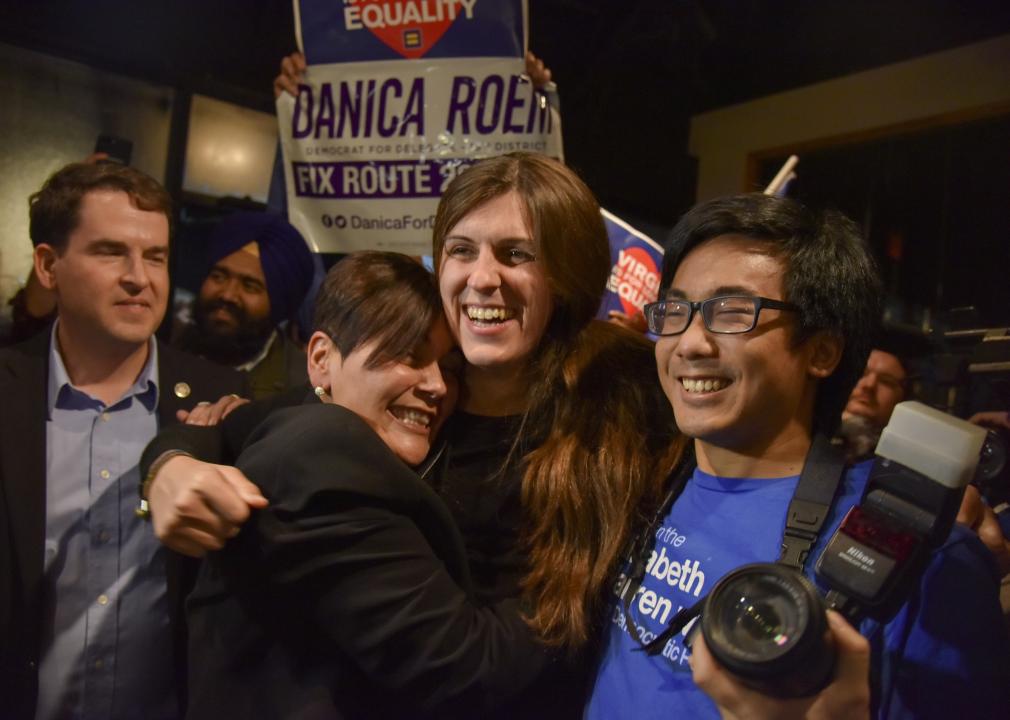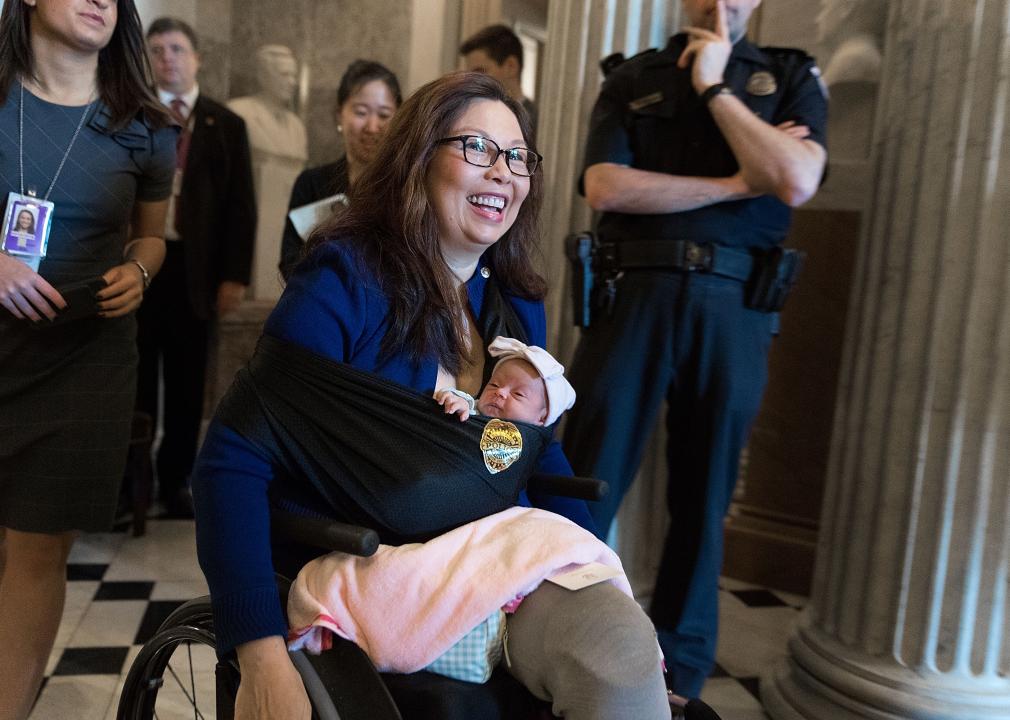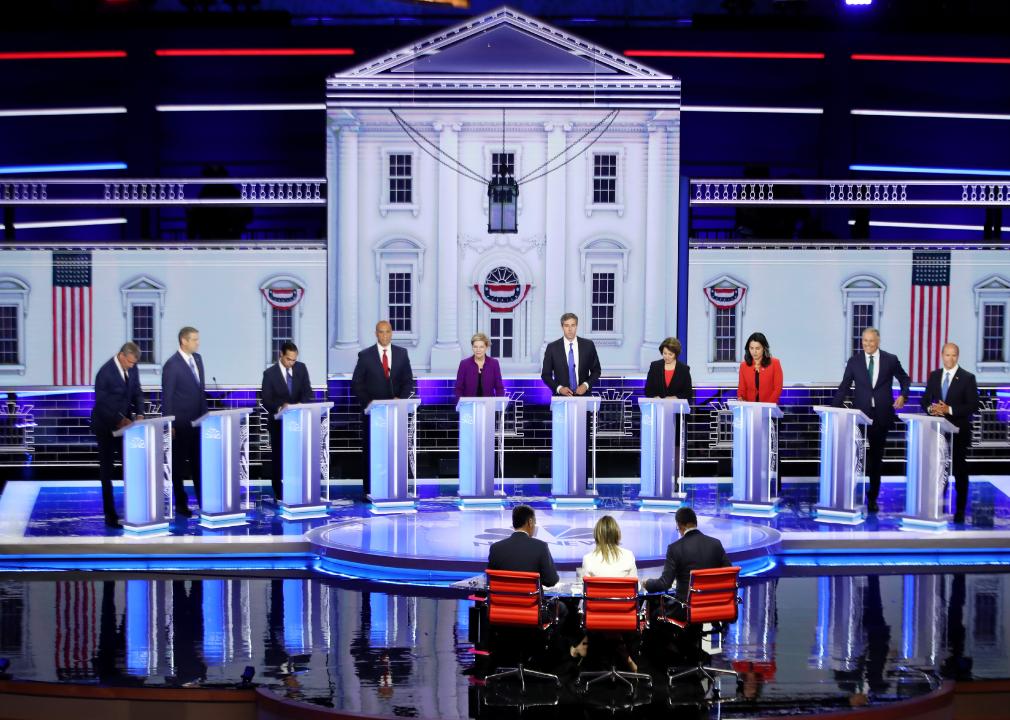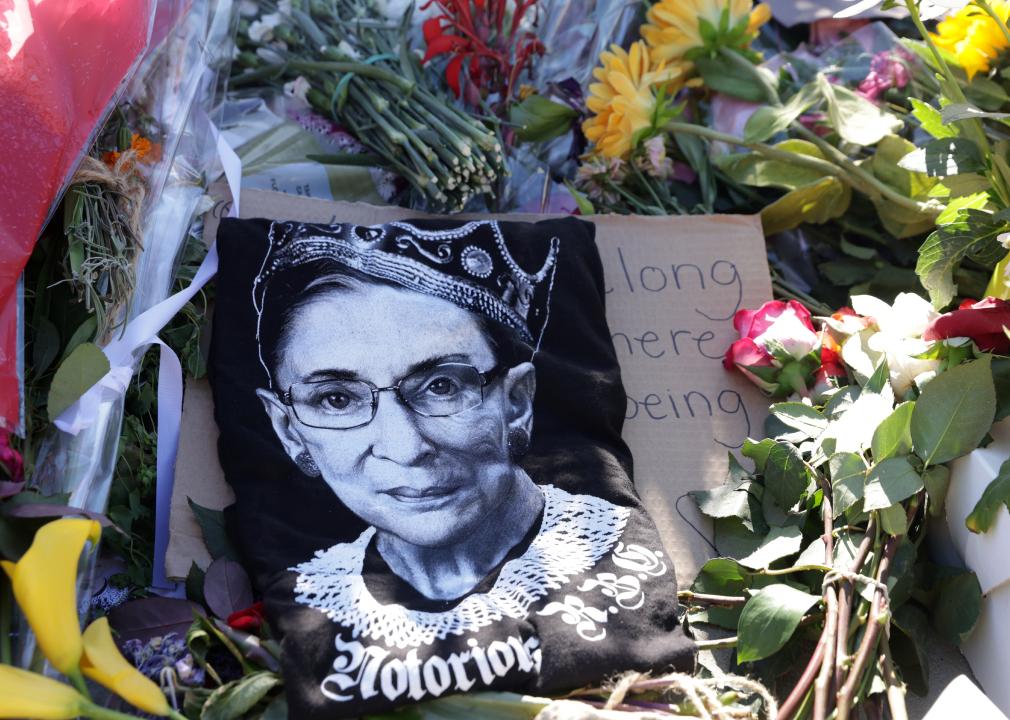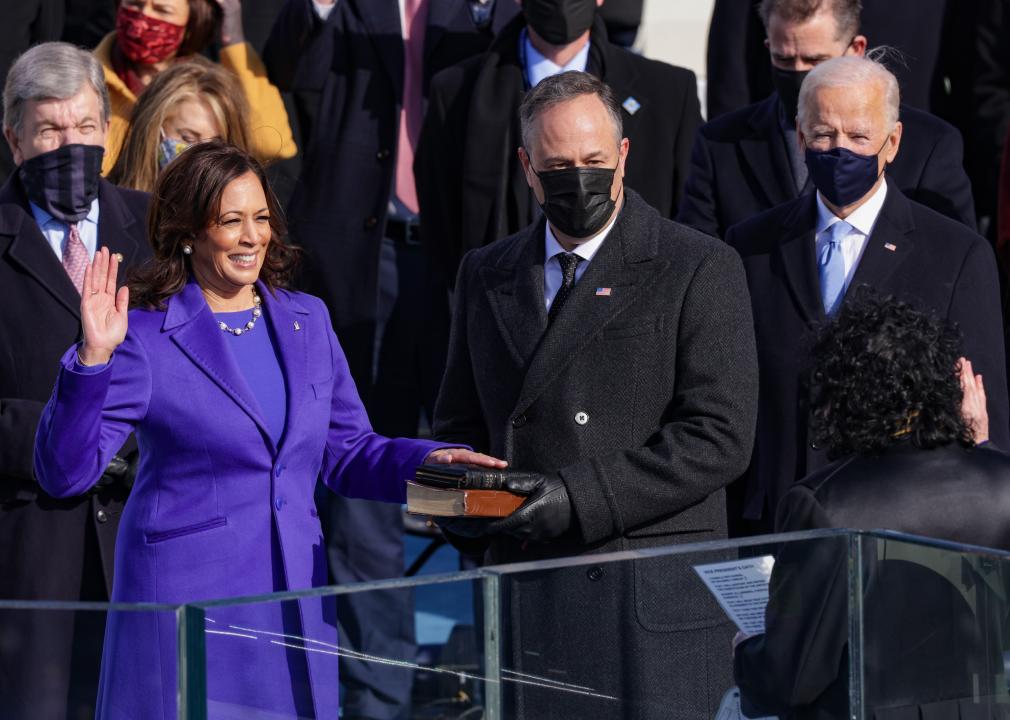Women in public office the year you were born
PhotoQuest // Getty Images
Women in public office the year you were born
A new chapter in American history unfolded on Jan. 20, 2021, when Kamala Harris became the first woman to be sworn in as vice president.
Harris’ role in the position is certainly monumental, but her nomination, while significant, was not a first. In 1984, Geraldine A. Ferraro, a congresswoman from Queens, strode on stage alongside Walter F. Mondale as the vice-presidential nominee, telling attendees at the Democratic National Convention, “If we can do this, we can do anything.” While the duo lost to Reagan, the New York Times summarized the significance of the campaign perfectly: “64 years after women won the right to vote, a woman had removed the ‘men only’ sign from the White House door.”
Since 1776, there have been thousands of women who have held office in all levels of government, from local to state to federal. To illustrate the significant role women have played in the shaping of American policy and politics, Stacker used data from Rutgers University’s Center for American Women and Politics to determine the number of women in U.S. public office every year since 1932. The forthcoming list also includes each year’s political party breakdown for the women and the level of government they were in.
You may also like: Best-run cities in America
![]()
Interim Archives // Getty Images
1932
– Women in office: 193
– Political party: 77 Democratic, 109 Republican, 5 nonpartisan, 2 other party
– Level of government: 8 federal executive or Congress, 171 state legislature, 14 statewide executive, 0 D.C. or other territory legislature
Hattie Wyatt Caraway in 1932 became the first woman to be elected to a full term in the United States Senate. Her husband, Thaddeus Caraway, had initially won the Arkansas seat but died while holding the office in 1931. Thanks to a now-defunct practice called the widow’s mandate, Hattie took over the job for the rest of that year, then won reelection on her own merits in 1932 with 92% of the vote.
[Pictured: Hattie Wyatt Caraway at her desk in Washington D.C., 1936.]
Bettmann // Getty Images
1933
– Women in office: 187
– Political party: 99 Democratic, 81 Republican, 4 nonpartisan, 3 other party
– Level of government: 12 federal executive or Congress, 161 state legislature, 14 statewide executive, 0 D.C. or other territory legislature
From her political beginnings as an executive secretary for the New York City Committee on Safety to her biggest role as Franklin D. Roosevelt’s Secretary of Labor, Frances Perkins was one of the country’s most vocal and influential female politicians in the ’30s. Her federal appointment, which she held for 12 years, made her the first woman to serve in a presidential cabinet. During her time under Roosevelt, Perkins tackled many of the problems brought on by the Great Depression, and, most notably, drafted the legislation that led to the Social Security Act.
[Pictured: Frances Perkins photographed at her office in the State Building, New York City in 1933.]
Universal History Archive // Getty Images
1934
– Women in office: 182
– Political party: 98 Democratic, 77 Republican, 4 nonpartisan, 3 other party
– Level of government: 8 federal executive or Congress, 160 state legislature, 14 statewide executive, 0 D.C. or other territory legislature
Perkins was joined by another woman, Josephine Roche, in 1934, when FDR appointed the latter as the Assistant Secretary of the Treasury. Roche only remained in the role for a short length of time, before leaving of her own accord to return to the helm of her business, the Rocky Mountain Fuel Company, which had begun to crumble in her absence.
[Pictured: President Franklin Roosevelt Addressing 74th Congress, Washington D.C.]
Smith Collection/Gado // Getty Images
1935
– Women in office: 188
– Political party: 111 Democratic, 73 Republican, 3 nonpartisan, 1 other party
– Level of government: 7 federal executive or Congress, 170 state legislature, 11 statewide executive, 0 D.C. or other territory legislature
Florence Prag Kahn, the first Jewish American woman to hold a seat in Congress, also held firmly to the belief that sex shouldn’t determine an individual’s ability to participate in politics in the same way it made no difference in their ability to obtain citizenship. Florence arrived in the House of Representatives after the death of her husband, Julius Kahn, in 1924, but ran for, and won, elections on her own merit many times in the following years. In 1935, she began her fifth and final term, before retiring to her childhood home in San Francisco.
Universal History Archive // Getty Images
1936
– Women in office: 188
– Political party: 111 Democratic, 73 Republican, 3 nonpartisan, 1 other party
– Level of government: 8 federal executive or Congress, 170 state legislature, 10 statewide executive, 0 D.C. or other territory legislature
In the ’20s and ’30s, many women first held political office not through their own merits, but through a phenomenon that became known as the widow’s mandate, in which women would succeed their deceased husbands for the remainder of the man’s elected term. These women—like populist Rose McConnell Long, who became a Louisiana senator in 1936—were often chosen for their familiar name as well as for the belief that they’d hold the same ideas and be loyal to the political agendas of their spouses.
[Pictured: Rose McConnell Long (right), February 1936.]
You may also like: Youngest heads of state in the world right now
H. Armstrong Roberts/ClassicStock // Getty Images
1937
– Women in office: 195
– Political party: 110 Democratic, 82 Republican, 3 nonpartisan, 0 other party
– Level of government: 7 federal executive or Congress, 177 state legislature, 11 statewide executive, 0 D.C. or other territory legislature
In 1937, Dixie Bibb Graves became the first female senator in Alabama when her husband, Governor Bibb Graves, appointed her to fill a seat left empty by Hugo Lafayette Black, a new Supreme Court justice. Although her time in the Senate was relatively uneventful, the Democrat is remembered for her participation in a filibuster against the Wagner-Van Nuys Anti-Lynching Bill.
Bettmann // Getty Images
1938
– Women in office: 197
– Political party: 112 Democratic, 82 Republican, 3 nonpartisan, 0 other party
– Level of government: 9 federal executive or Congress, 177 state legislature, 11 statewide executive, 0 D.C. or other territory legislature
A former public school teacher, Crystal Bird Fauset became the first African American woman to serve as a state legislator in 1938. The Pennsylvania resident represented a district that was 66% white but fought tirelessly for the rights of minorities, introducing nine bills and three amendments that directly impacted their living and working conditions. In the 1940s, Fauset became a member of President Roosevelt’s “Black Cabinet,” before turning her attention to global politics in the ’50s.
[Pictured: Attendees at a Women’s Congress Event.]
Harris & Ewing // Wikimedia Commons
1939
– Women in office: 201
– Political party: 92 Democratic, 104 Republican, 4 nonpartisan, 1 other party
– Level of government: 6 federal executive or Congress, 181 state legislature, 14 statewide executive, 0 D.C. or other territory legislature
Gladys Pyle, the daughter of a suffragist, became the first Republican woman to hold a seat in the U.S. Senate in 1939. Pyle won her seat during a special election, which concluded after Congress had adjourned, meaning she was never actually sworn in. Still, she made the journey to Washington D.C., where she addressed individual constituent needs, pushed for WPA programs, and used her powers to persuade Norwegian officials to add a South Dakota stop to their upcoming North American tour, during the handful of weeks she held the office.
[Pictured: Pyle on November 28, 1938, during her brief Senate term.]
Frederic Lewis // Getty Images
1940
– Women in office: 212
– Political party: 97 Democratic, 110 Republican, 4 nonpartisan, 1 other party
– Level of government: 9 federal executive or Congress, 188 state legislature, 15 statewide executive, 0 D.C. or other territory legislature
Perhaps one of the wealthiest women to ever hold political office, Frances Payne Bolton was, at one point, the richest woman in America. The Ohio republican assumed her husband’s position in Congress after his death in 1940 and held on to the seat through 1969. During her years of service, Bolton helped to shape America’s foreign policy, increased spending and focus on public health issues, and was a fervent supporter of all of her female colleagues and their initiatives, regardless of party affiliation.
[Pictured: Supporters gathered outside the Philadelphia Convention Hall to attend the 1940 Republican National Convention.]
New York Times Co. // Getty Images
1941
– Women in office: 205
– Political party: 103 Democratic, 100 Republican, 2 nonpartisan, 0 other party
– Level of government: 9 federal executive or Congress, 181 state legislature, 15 statewide executive, 0 D.C. or other territory legislature
A look back at women in American politics would not be complete without a mention of Jeannette Rankin. In 1916, Rankin was the first woman ever elected to the United States Congress, representing the state of Montana. In 1940, she won a second term. Then, in 1941, Rankin, a life-long pacifist, made headlines for a third time when she became the only member of Congress to vote against declaring war with Japan after the bombing of Pearl Harbor.
[Pictured: Jeannette Rankin as she testifies before the House Naval Affairs Committee.]
You may also like: Youngest and oldest presidents in U.S. history
Bettmann // Getty Images
1942
– Women in office: 210
– Political party: 106 Democratic, 102 Republican, 2 nonpartisan, 0 other party
– Level of government: 10 federal executive or Congress, 185 state legislature, 15 statewide executive, 0 D.C. or other territory legislature
With the advent of World War II, women’s roles in society began to change drastically. Many women were doing things like working outside the home and serving as their household’s primary breadwinners for the first time ever. We also begin to see a dramatic jump in the number of women in government. Still, many of these women, like Veronica Boland, were having a hard time obtaining office in their own right, without the benefit of a husband who held office before them.
Universal History Archive // Getty Images
1943
– Women in office: 262
– Political party: 110 Democratic, 148 Republican, 2 nonpartisan, 2 other party
– Level of government: 8 federal executive or Congress, 239 state legislature, 15 statewide executive, 0 D.C. or other territory legislature
In October 1943 Senator Hattie Caraway became the first woman to act as the body’s presiding officer. The position was not formally assigned to Caraway, but in the absence of the vice president and the president of the Senate, the duties fell to her. This was not the first time Caraway had broken gender barriers in politics, and she told reporters there was really “nothing to it” as “the Senate is the best-behaved crowd of men you ever saw.”
[Pictured: Hattie Caraway at her desk.]
Robert Abbott Sengstacke // Getty Images
1944
– Women in office: 259
– Political party: 108 Democratic, 147 Republican, 2 nonpartisan, 2 other party
– Level of government: 9 federal executive or Congress, 234 state legislature, 16 statewide executive, 0 D.C. or other territory legislature
Mary McLeod Bethune, the daughter of former enslaved people, was the highest-ranking Black woman in government from 1936 to 1944, after President Roosevelt named her the Director of Negro Affairs of the National Youth Administration. The leader of Roosevelt’s unofficial “Black Cabinet,” Bethune was a civil rights activist, a reporter for Black newspapers like the “Chicago Defender,” and the only Black woman at the founding conference of the United Nations. In 1974 she was honored with a commemorative statue in Washington D.C.
[Pictured: Mary McLeod Bethune at a desk, possibly in the Chicago Defender offices.]
Constantin Joffe // Getty Images
1945
– Women in office: 303
– Political party: 124 Democratic, 178 Republican, 1 nonpartisan, 0 other party
– Level of government: 9 federal executive or Congress, 278 state legislature, 16 statewide executive, 0 D.C. or other territory legislature
A fierce advocate for women’s rights from her time as the first female assistant district attorney in New York’s Erie County through her time as a single-term congresswoman, Winifred Stanley tirelessly pushed for the ratification of the Equal Rights Amendment and a wage-related addition to the National Labor Relations Act. A vocal critic of the New Deal, Stanley was more concerned about the “prose” of post-World War II life than she was the “poetry of victory.” As such, she worked to secure jobs and health care for veterans, assist the middle class in recovering financially, and ensure a lasting peace by backing the creation of the United Nations.
[Pictured: Congresswoman Winifred Stanley for Vogue.]
Fotosearch // Getty Images
1946
– Women in office: 308
– Political party: 128 Democratic, 178 Republican, 2 nonpartisan, 0 other party
– Level of government: 11 federal executive or Congress, 281 state legislature, 16 statewide executive, 0 D.C. or other territory legislature
President Truman appointed former first lady Eleanor Roosevelt, who he called “the First Lady of the World,” as a delegate to the United Nations in 1946, ensconcing her as the chairman of the Human Rights Commission. It was under her direction that the Universal Declaration of Human Rights, which has become her biggest legacy, was completed. An incredibly active player in her husband’s presidency, Roosevelt was also responsible for designing the activist role that modern-day first ladies play in the country.
[Pictured: Eleanor Roosevelt holds up a copy of ‘THE UNIVERSAL DECLARATION OF HUMAN RIGHTS.]
You may also like: Most and least popular governors in America
Library of Congress // Getty Images
1947
– Women in office: 277
– Political party: 82 Democratic, 194 Republican, 1 nonpartisan, 0 other party
– Level of government: 7 federal executive or Congress, 254 state legislature, 16 statewide executive, 0 D.C. or other territory legislature
The phrase “equal pay for equal work” was coined by Katharine St. George, a New York congresswoman, during her nine terms in office. A cousin of Franklin D. Roosevelt, St. George believed in fiscal conservatism, limiting the size of government, and equal treatment of women within society, which, by her account, begins with economic strength. Still, St. George was decidedly not a feminist, and refused to back the more liberal bills and initiatives proposed by her democratic colleagues.
[Pictured: Members of Labor Advisory Committee of the Women’s Bureau, U.S. Department of Labor, attending a conference.]
PhotoQuest // Getty Images
1948
– Women in office: 280
– Political party: 84 Democratic, 195 Republican, 1 nonpartisan, 0 other party
– Level of government: 8 federal executive or Congress, 256 state legislature, 16 statewide executive, 0 D.C. or other territory legislature
As the victor of a hotly contested 1948 Senate race in Maine, Margaret Chase Smith became the first woman to hold a seat in both the chambers of the House of Representatives. A tough and assertive lawmaker, Smith was well-known for her vocal opposition of McCarthyism in the ’40s and ’50s, even publicly defending the right of all Americans to “criticize … hold unpopular beliefs … and protest” in a speech she gave on the Senate floor. In the late ’60s, Smith, a Republican, made history again when she became the first woman to actively seek a presidential nomination from a major party.
[Pictured: Senator Margaret Chase Smith in her office.]
CQ Archive // Getty Images
1949
– Women in office: 291
– Political party: 126 Democratic, 163 Republican, 1 nonpartisan, 1 other party
– Level of government: 10 federal executive or Congress, 265 state legislature, 16 statewide executive, 0 D.C. or other territory legislature
Burnita Shelton Matthews was a proud suffragist and feminist with a passion for law. In 1949, she made history when President Truman appointed her to the United States District Court in the District of Columbia, making her the first female judge to preside over a federal trial court. Throughout her career, Matthews hired exclusively female law clerks whom she often advised to forgo motherhood in order to pursue a meaningful career.
PhotoQuest // Getty Images
1950
– Women in office: 294
– Political party: 128 Democratic, 164 Republican, 1 nonpartisan, 1 other party
– Level of government: 10 federal executive or Congress, 268 state legislature, 16 statewide executive, 0 D.C. or other territory legislature
The first Democratic woman to represent Brooklyn in Congress, Edna Kelly spent 10 terms in the House between 1949 and 1969. She’s primarily remembered for contributions to international affairs in Europe and the Middle East, as well as her hard anti-communist positions. Kelly held a seat on the Foreign Affairs Committee for her entire career and her voice there helped America be “strong and … prepared and … willing to stand up and be counted when the chips were down in vital areas of the world,” according to one former colleague.
[Pictured: US Representative Edna F Kelly and John F Shelley are administered the oath of office as the 81st Congress convene.]
AFP // Getty Images
1951
– Women in office: 308
– Political party: 111 Democratic, 193 Republican, 3 nonpartisan, 1 other party
– Level of government: 11 federal executive or Congress, 282 state legislature, 15 statewide executive, 0 D.C. or other territory legislature
Vera Buchanan’s brief tenure in Congress was bookended by tragedy. Elected in 1951, she took over her late husband’s seat representing the state of Pennsylvania. Two terms later, the congresswoman, who had spent her time in the role focusing on safe, affordable housing for lower and middle-income families, died of terminal lung cancer. She became the first woman to die while holding office at this level.
[Pictured: 1951 Session of Congress in the House Chamber at the U.S. Capitol.]
You may also like: How America has changed since the first Census in 1790
Bettmann // Getty Images
1952
– Women in office: 313
– Political party: 110 Democratic, 199 Republican, 3 nonpartisan, 1 other party
– Level of government: 11 federal executive or Congress, 284 state legislature, 18 statewide executive, 0 D.C. or other territory legislature
Although Kamala Harris will be remembered as the first woman of color to be elected vice president, she wasn’t the first woman of color to be nominated for the office. Almost 70 years ago Charlotta Spears Bass, a civil rights activist, politician, and editor of the African American newspaper “The California Eagle,” was nominated by the Progressive Party to run alongside Vincent Hallinan. Although the duo campaigned on a platform that highlighted civil rights, equality, jobs, and peace, they won only 0.2% of the popular vote.
[Pictured: Charlotta A. Bass is shown as she speaks to a news conference in 1952.]
Bettmann // Getty Images
1953
– Women in office: 372
– Political party: 120 Democratic, 248 Republican, 3 nonpartisan, 1 other party
– Level of government: 12 federal executive or Congress, 344 state legislature, 16 statewide executive, 0 D.C. or other territory legislature
The first female governor in the country and the first woman to act as the Director of the Mint, Nellie Tayloe Ross began her political career in 1925. Almost 30 years later, in 1953, the trailblazer retired from public life and service, having spent almost 20 years in charge of the country’s money supply. The Roosevelt dime and the Jefferson nickel were both printed for the first time during Ross’ tenure.
[Pictured: Meeting of U.S. Delegation to U.N. featuring Frances P. Bolton.]
PhotoQuest // Getty Images
1954
– Women in office: 377
– Political party: 121 Democratic, 251 Republican, 4 nonpartisan, 1 other party
– Level of government: 15 federal executive or Congress, 346 state legislature, 16 statewide executive, 0 D.C. or other territory legislature
A true trailblazer for women in politics, Consuelo Northrop Bailey was elected lieutenant governor of Vermont—the first woman in the country to hold such a role—in 1954. This accomplishment came on the heels of a successful law career (she is also recognized as the first woman to argue a case in front of the U.S. Supreme Court) and a stint as Vermont’s first female speaker of the house. Over the course of her impressive career, Northrop Bailey ran for public office a total of 24 times, winning every election she took part in, and ran a successful law firm, Bailey & Bailey, with her husband H. Albon Bailey.
[Pictured: Nellie Tayloe Ross as she holds an oversized coin in her office.]
PhotoQuest // Getty Images
1955
– Women in office: 377
– Political party: 149 Democratic, 223 Republican, 4 nonpartisan, 1 other party
– Level of government: 17 federal executive or Congress, 341 state legislature, 19 statewide executive, 0 D.C. or other territory legislature
Nicknamed “the mother of the ERA (Equal Rights Amendment),” Martha W. Griffiths is solely responsible for ensuring that sexual discrimination against women was added to the civil rights bill and pivotal in bringing that bill to a vote in Congress. Griffiths began her career in the House in 1955, representing the state of Michigan, but much of her fight against racial and sexist discrimination took place in the late ’60s and early ’70s. When she died in 2003, The Lansing Journal remembered her as “one of America’s leading crusaders for women’s rights,” saying “it is no stretch to say that she, as much as any person of her day, helped level the gender playing field”
[Pictured: Seventeen female members of the US Congress shown on the steps of the House of Representatives side of the Capitol, Washington D.C., January 17, 1955.]
Bettmann // Getty Images
1956
– Women in office: 372
– Political party: 144 Democratic, 223 Republican, 4 nonpartisan, 1 other party
– Level of government: 17 federal executive or Congress, 334 state legislature, 21 statewide executive, 0 D.C. or other territory legislature
Few congressmen or women have done as much to influence public education in the United States as Edith Green, who took office in 1955. The daughter of two teachers and an educator herself, Green introduced the Higher Education Act of 1965, the National Defense Education Act, the Higher Education Facilities Act, and Title IX (part of the Education Amendments of 1972). These bills, as well as her seat on the Committee on Education and Labor, earned Green nicknames like “Mrs. Education” and “the mother of higher education,” titles she claimed proudly when she returned to education after leaving Congress in 1975.
[Pictured: Four new Democratic Congresswomen who took office in the 84th Congress.]
You may also like: Major newspaper headlines from the year you were born
Bettmann // Getty Images
1957
– Women in office: 393
– Political party: 151 Democratic, 240 Republican, 2 nonpartisan, 0 other party
– Level of government: 16 federal executive or Congress, 358 state legislature, 19 statewide executive, 0 D.C. or other territory legislature
In contrast to the politicians of today, Florence Dwyer, a Republican congresswoman from New Jersey, was far less concerned about voting along party lines and far more concerned about voting in ways that would benefit the district she represented. This disregard for blind allegiance is something many people would argue is lacking in modern-day politics. It’s also something that made Dwyer popular with her constituents, especially in 1957 as she was nearing the end of her first term in office.
[Pictured: General view on the House Chamber.]
Keystone-France // Getty Images
1958
– Women in office: 398
– Political party: 158 Democratic, 238 Republican, 2 nonpartisan, 0 other party
– Level of government: 16 federal executive or Congress, 363 state legislature, 19 statewide executive, 0 D.C. or other territory legislature
On Mother’s Day 1958, Coya Knutson, the first congresswoman elected from the state of Minnesota, was the target of an incredibly sexist political attack: a letter published in The New York Times, supposedly written by her husband, titled “Coya Come Home.” First published in a regional newspaper, the letter, which asked the congresswoman to abandon her plans of reelection in order to care for her family, spread quickly, ending up in papers around the nation. It later came out that the letter was written by members of Knutson’s own party who were angry with her voting record, and only signed by her alcoholic husband, whom Knutson was separated from at the time. Regardless of its origins, the missive completely destroyed her career.
Boston Globe // Getty Images
1959
– Women in office: 408
– Political party: 205 Democratic, 201 Republican, 2 nonpartisan, 0 other party
– Level of government: 17 federal executive or Congress, 375 state legislature, 16 statewide executive, 0 D.C. or other territory legislature
After the widow’s mandate helped Edith Nourse Rogers land her first term in Congress back in 1925, she won 17 additional elections on her own. The Massachusetts representative used her time in Congress to advocate for military families and veterans, writing the legislation that would become the G.I. Bill of Rights and creating the Women’s Army Corps. In 1959, Rogers started her last term in Congress: She died of pneumonia just three days before the primaries for the following term were set to begin.
[Pictured: Vice-President Richard M. Nixon meets with congresswoman Edith Nourse Rogers and others.]
Smith Collection/Gado // Getty Images
1960
– Women in office: 417
– Political party: 208 Democratic, 207 Republican, 2 nonpartisan, 0 other party
– Level of government: 19 federal executive or Congress, 380 state legislature, 18 statewide executive, 0 D.C. or other territory legislature
Before entering Congress in 1960, Catherine Dean May recalled “wondering what women had been screaming about … because we had had equal rights in the state of Washington for years,” noting she quickly learned after accepting the position. This wake-up call left her with a “tremendous feeling of responsibility towards all women,” which she acted on by fighting for equal pay, supporting Title VII of the 1964 Civil Rights Act, and backing the Equal Rights Act, which was stuck in limbo for years.
[Pictured: Female members of the United States Congress.]
Bettmann // Getty Images
1961
– Women in office: 396
– Political party: 180 Democratic, 212 Republican, 3 nonpartisan, 1 other party
– Level of government: 19 federal executive or Congress, 355 state legislature, 22 statewide executive, 0 D.C. or other territory legislature
Many women have ended up in politics without ever intending to. Louise Reece is one of them. Reece spent much of her adult life acting as a support to her husband, a congressman from Tennessee: running his reelection campaigns, making contacts on his behalf, and helping him get a handle on key legislations. When Mr. Reece died of cancer in 1961, Louise announced her intention to take over his seat for the remainder of his term, winning handily and spending two successful, if uneventful, years lobbying for her constituents.
You may also like: Most and least popular senators in America
Afro Newspaper/Gado // Getty Images
1962
– Women in office: 405
– Political party: 190 Democratic, 211 Republican, 3 nonpartisan, 1 other party
– Level of government: 20 federal executive or Congress, 362 state legislature, 23 statewide executive, 0 D.C. or other territory legislature
Fannie Lou Hamer, a Black plantation worker from Mississippi, may have never held political office herself, but her activism made it possible for many of the other women on this list to do so. In 1962, Hamer was involved with registering Black voters, which led to her starting her own political party, the Mississippi Freedom Democratic Party, in 1964. Her biggest contribution to modern-day politics, however, was her call for mandatory integrated state delegations, something that became a reality in 1968.
[Pictured: Fannie Lou Harmer with three men, June 16, 1964.]
Bettmann // Getty Images
1963
– Women in office: 407
– Political party: 181 Democratic, 221 Republican, 4 nonpartisan, 1 other party
– Level of government: 13 federal executive or Congress, 372 state legislature, 22 statewide executive, 0 D.C. or other territory legislature
One-half of the first married couple to serve in a state legislature, Maurine Neuberger entered the Oregon House in 1950. By 1963, Neuberger’s husband had passed away and she had moved on to the U.S. Senate, becoming the first, and only, woman to represent the Northwestern state to date. During her time in the federal body, Neuberger advocated for consumers, campaigning to regulate the tobacco industry, and fought tirelessly for equal pay for equal work, before retiring in 1967.
[Pictured: Kathryn Granahan is sworn in as new Treasurer of the U.S. during a White House ceremony.]
Bettmann // Getty Images
1964
– Women in office: 412
– Political party: 185 Democratic, 221 Republican, 5 nonpartisan, 1 other party
– Level of government: 14 federal executive or Congress, 377 state legislature, 21 statewide executive, 0 D.C. or other territory legislature
The first Asian American woman elected to the United State’s House of Representatives was Patsy Takemoto Mink, a Japanese American congresswoman who represented the state of Hawaii. Being of Japanese descent and one-half of an interracial marriage, Mink faced plenty of discrimination in her personal life and political career, something she actively fought against as a lawmaker. Throughout her decades of service, she championed the rights of minorities, women, and immigrants, through things like the Title IX Law, the Early Childhood Education Act, and the Women’s Education Act, all of which she had a hand in writing.
[Pictured: Representative Patsy Takemoto Mink puts homemade nameplate on the door of her new office.]
Denver Post // Getty Images
1965
– Women in office: 438
– Political party: 228 Democratic, 205 Republican, 5 nonpartisan, 0 other party
– Level of government: 12 federal executive or Congress, 406 state legislature, 20 statewide executive, 0 D.C. or other territory legislature
Law and politics ran in the veins of Lorna E. Lockwood, the grandniece of Abraham Lincoln and the first woman to act as a chief justice in a state’s Supreme Court. Arizona’s first female law school graduate, Lockwood opened her own law firm in Phoenix with another female lawyer after both were refused work in existing firms on the basis of their gender. She then went on to become the first woman to serve as a judge in the Grand Canyon state, earn two nominations from Arizona senators for a seat on the United State’s Supreme Court (she was once passed over in favor of Thurgood Marshall), and eventually helm Arizona’s Supreme Court beginning in 1965.
Bettmann // Getty Images
1966
– Women in office: 435
– Political party: 225 Democratic, 204 Republican, 6 nonpartisan, 0 other party
– Level of government: 13 federal executive or Congress, 401 state legislature, 21 statewide executive, 0 D.C. or other territory legislature
One of the unsung heroes of political history is Constance Baker Motley, the first African American female federal judge. The daughter of West Indian immigrants, Motley was a clerk for Thurgood Marshall before she began arguing her own cases, occasionally defending other major civil rights players like Martin Luther King Jr. and James Meredith. Before being appointed by President Johnson as a federal judge in New York’s Southern District in 1966, Motley entered the political world, becoming the first Black woman in New York’s state senate and Manhattan’s first female borough president.
[Pictured: Constance Baker Motley, at press conference at her office in New York City.]
You may also like: 25 terms you should know to understand the gun control debate
Denver Post // Getty Images
1967
– Women in office: 375
– Political party: 192 Democratic, 177 Republican, 6 nonpartisan, 0 other party
– Level of government: 12 federal executive or Congress, 340 state legislature, 23 statewide executive, 0 D.C. or other territory legislature
While Black women had been making their mark in politics in the north and west for years, things were slower to change in the more segregated South. Grace Towns Hamilton, who was first elected to the Georgia General Assembly in 1965, was one of the few women of color serving in any level of government in the region. Her 18 years in the role, which are most remembered for the new Atlanta City Charter which she designed, earned her the reputation of being “the most effective woman legislator the state has ever had.”
[Pictured: Virginia Blue, right, takes office as State Treasurer.]
Bettmann // Getty Images
1968
– Women in office: 380
– Political party: 195 Democratic, 179 Republican, 6 nonpartisan, 0 other party
– Level of government: 12 federal executive or Congress, 342 state legislature, 26 statewide executive, 0 D.C. or other territory legislature
Shirley Chisholm made history in 1968 when she became the first Black woman in the United States Congress, representing a democratic district in her native New York City. Nicknamed “fighting Shirley,” Chisholm was a leader in the federal government, serving on the House Rules Committee and championing causes like racial and gender equality, an end to the Vietnam War, and support for the poor. In 1972, she ran for the presidency, earning the votes of 152 delegates despite an underfinanced campaign and being banned from participating in any of the televised debates.
[Pictured: Harlem Congressman Adam Clayton Powell Jr. and Congresswoman Shirley Chisolm.]
Congressional Quarterly // Getty Images
1969
– Women in office: 370
– Political party: 181 Democratic, 184 Republican, 5 nonpartisan, 0 other party
– Level of government: 11 federal executive or Congress, 336 state legislature, 23 statewide executive, 0 D.C. or other territory legislature
Fashion history was made in 1969 when Charlotte Reid, a Republican from Illinois, became the first woman to wear pants on the House floor. She told The Washington Post that her male colleagues had nothing but compliments to give, but that she likely wouldn’t do it again as she was “really quite serious about [her] service in the Congress and [she] wouldn’t want to do anything that seemed facetious.” And while we love a good pantsuit moment, this would not be, unfortunately, the last time that what a woman wore to work in Congress or the Senate was deemed more newsworthy than what she did while in those chambers.
[Pictured: Congresswoman Charlotte Reid.]
CQ Archive // Getty Images
1970
– Women in office: 374
– Political party: 184 Democratic, 185 Republican, 5 nonpartisan, 0 other party
– Level of government: 11 federal executive or Congress, 337 state legislature, 26 statewide executive, 0 D.C. or other territory legislature
Many women who venture into politics are saddled with unfair characterizations, often finding themselves described in sexist terms as shrill, difficult to work with, or abrasive. Congresswoman Margaret Heckler, who ran for office in Massachusetts simply because she “felt very strongly that there should be more women in congress,” certainly had these things said about her. Still, she fought hard over the course of her eight terms for more representation in local and federal government, and was even one of the organizers of the Congressional Caucus for Women’s Issues.
[Pictured: Rep. Margaret Heckler and Rep. Robert C. Eckhardt racing in front of Capitol Hill.]
PhotoQuest // Getty Images
1971
– Women in office: 408
– Political party: 214 Democratic, 191 Republican, 3 nonpartisan, 0 other party
– Level of government: 13 federal executive or Congress, 370 state legislature, 25 statewide executive, 0 D.C. or other territory legislature
One of the most striking members of the House in the 1970s, Bella Abzug, an outspoken feminist, won a seat in Congress in 1972 on an anti-war and pro-feminist platform and the slogan “A woman’s place is in the house … the House of Representatives!” During her first few days in office, the New Yorker introduced bills that called for the end of the Vietnam War and an investigation into FBI Director J. Edgar Hoover. Throughout her three-term tenure, she earned the name “Battling Bella,” for the aggressive way she got things done, from the passing of the “sunshine laws,” which require government trials to be held in public, to her suggested amendment to the Civil Rights Act of 1964, which would have prohibited “discrimination on the basis of sexual or affectational preference.”
[Pictured: Bella Abzug raises her hand as she is sworn in.]
You may also like: Counties with the highest rate of food insecure children
Pictorial Parade // Getty Images
1972
– Women in office: 414
– Political party: 219 Democratic, 191 Republican, 3 nonpartisan, 1 other party
– Level of government: 14 federal executive or Congress, 376 state legislature, 24 statewide executive, 0 D.C. or other territory legislature
A woman’s tenure in office doesn’t have to be long in order to be monumental. Take Jean Westwood, for example. The Utah native and life-long democrat was the first woman to serve as chair of the Democratic National Committee, but only held the post for a matter of months before agreeing to step down. Still, her leadership set the precedent and paved the way for other women to follow in her footsteps.
[Pictured: Democratic National Committee meeting.]
Bettmann // Getty Images
1973
– Women in office: 513
– Political party: 276 Democratic, 232 Republican, 3 nonpartisan, 2 other party
– Level of government: 16 federal executive or Congress, 471 state legislature, 26 statewide executive, 0 D.C. or other territory legislature
A woman’s ability to be both an involved parent and a successful leader has long been questioned by society in spite of the fact that we rarely question a man’s ability to do the same thing. In 1973, Yvonne Brathwaite Burke prompted this conversation all over again when she became the first congresswoman to give birth and request maternity leave while in office. With her appointment to the Appropriations Committee and her election as the chair of the Congressional Black Caucus, she proved that raising children can hardly be described as an impediment to a political career.
[Pictured: Six of the 12 new female members of the United States House of Representatives, 1973.]
Bettmann // Getty Images
1974
– Women in office: 527
– Political party: 287 Democratic, 235 Republican, 3 nonpartisan, 2 other party
– Level of government: 16 federal executive or Congress, 484 state legislature, 27 statewide executive, 0 D.C. or other territory legislature
1974 was a big year for LGBTQ+ candidates: Elaine Noble and Kathy Kozachenko became the first openly queer politicians elected to office. Noble was elected to the Massachusetts House of Representatives, and Kozachenko earned herself a spot on the Ann Arbor City Council. Both women served multiple terms several years before Harvey Milk, who is commonly recognized as the first openly gay politician, won a seat on the San Fransisco Board of Supervisors, but aren’t given the recognition they deserve.
[Pictured: With a group of congresswomen and the first lady looking on, President Ford signs a proclamation.]
Bettmann // Getty Images
1975
– Women in office: 686
– Political party: 443 Democratic, 239 Republican, 2 nonpartisan, 2 other party
– Level of government: 19 federal executive or Congress, 634 state legislature, 33 statewide executive, 0 D.C. or other territory legislature
March Fong Eu, a Chinese American, broke gender and racial barriers in 1975 when she became California’s first female and Asian Secretary of State. Raised in San Francisco, Fong Eu was ambitious from the start, pursuing higher education even when her teachers and parents advised her against it. After obtaining office, the outspoken Fong Eu pushed for equal treatment for women within her state’s “boys club” government, and pioneered the expansion of the vote by mail system that is still in place today.
Boston Globe // Getty Images
1976
– Women in office: 697
– Political party: 444 Democratic, 248 Republican, 3 nonpartisan, 2 other party
– Level of government: 19 federal executive or Congress, 645 state legislature, 33 statewide executive, 0 D.C. or other territory legislature
Abortion has long been a hot-button political issue, with a wave of feminist activism in the ’60s and early ’70s fighting for the right for women to decide leading to its legalization by the Supreme Court. Ellen McCormack was a leading voice in the debate, even running for the presidency in 1976 on an anti-abortion platform. Her campaign was so successful that she became the first female candidate to receive federal campaign money and secret service protection. In the end, her run was cut short when she only obtained 22 delegate votes in the Democratic National Convention.
[Pictured: Massachusetts Governor Michael Dukakis swears in new members of the Commission on Status for Women.]
You may also like: What the world’s most polluted beaches look like today
Bettmann // Getty Images
1977
– Women in office: 786
– Political party: 490 Democratic, 290 Republican, 4 nonpartisan, 2 other party
– Level of government: 18 federal executive or Congress, 735 state legislature, 33 statewide executive, 0 D.C. or other territory legislature
Over the last several decades, Howard University has produced a number of notable alumni, including Vice President Kamala Harris and Patricia Roberts Harris. The latter Harris was the first Black woman to serve as a United States ambassador and the first Black woman to hold a position in a presidential cabinet. In 1977, when she was appointed to her first cabinet position, as Secretary of Urban Housing and Development, Harris spoke to her ability to represent the poor, saying, “I am one of them. You do not seem to understand who I am. I am a Black woman, daughter of a dining-car worker. I am a Black woman who could not buy a house eight years ago in parts of the District of Columbia. I didn’t start out as a member of a prestigious law firm, but as a woman who needed a scholarship to go to school. If you think that I have forgotten that, you are wrong.”
[Pictured: Patricia Roberts Harris appearing before the Senate Banking Committee.]
Denver Post // Getty Images
1978
– Women in office: 802
– Political party: 499 Democratic, 295 Republican, 6 nonpartisan, 2 other party
– Level of government: 21 federal executive or Congress, 748 state legislature, 33 statewide executive, 0 D.C. or other territory legislature
When Nancy Landon Kassebaum took office as a United States Senator representing the state of Kansas on December 23, 1978, she was the only woman in the chamber, surrounded by 99 male colleagues. Born into a prominent political family, Kassebaum held a seat on a number of committees throughout her tenure, most notably the Foreign Relations Committee, where she was often a vocal opponent to Presidents Reagan, Carter, and Bush. A moderate Republican on issues of budget and defense, she was independent on social issues, supporting a woman’s right to an abortion and health insurance coverage for all.
Bettmann // Getty Images
1979
– Women in office: 872
– Political party: 512 Democratic, 354 Republican, 5 nonpartisan, 1 other party
– Level of government: 17 federal executive or Congress, 817 state legislature, 38 statewide executive, 0 D.C. or other territory legislature
Another Howard University alum, Velvalea Phillips was the first woman to hold public office and preside over a court as a judge in the state of Wisconsin. A civil rights activist, she worked in both official and non-official capacities to change Wisconsin’s discriminatory housing laws, pushing for Fair Housing requirements that would require landlords to rent to people of color. In 1978, she was elected Secretary of State, a position she held until 1982 when she took a brief respite from political life.
[Pictured: A group of Congresswomen at a news conference.]
John Preito // Getty Images
1980
– Women in office: 878
– Political party: 510 Democratic, 362 Republican, 6 nonpartisan, 0 other party
– Level of government: 17 federal executive or Congress, 825 state legislature, 36 statewide executive, 0 D.C. or other territory legislature
As recently as the 1980s, Native Americans were viewed by the mostly white people in charge of government as a problem to be solved rather than as a group of citizens to be valued and represented. LaDonna Harris, a member of Comanche Nation, worked long and hard throughout the ’70s and ’80s to change this. She created a presentation for members of the federal government called “Indians 101,” established “Indian Desks” in various governmental agencies, founded the Americans for Indian Opportunity nonprofit. in 1980, became the first Native American woman to run for the vice president on the Citizen’s Party ticket.
David Hume Kennerly // Getty Images
1981
– Women in office: 1,000
– Political party: 559 Democratic, 433 Republican, 6 nonpartisan, 2 other party
– Level of government: 21 federal executive or Congress, 945 state legislature, 34 statewide executive, 0 D.C. or other territory legislature
For 191 years, the United States Supreme Court, the highest court in the country, had never had a female judge. That all changed in 1981 when President Ronald Reagan appointed Sandra Day O’Connor, a Stanford University graduate, to the post. O’Connor remained in the role until 2006, hearing hundreds of cases and playing a crucial role in as many verdicts, acting as a swing vote for the entirety of her career.
[Pictured: Sandra Day O’Connor being sworn in before the Senate Judiciary committee.]
You may also like: The only 7 countries that are on track to meet the Paris Agreement—and how they’re doing it
Duane Howell // Getty Images
1982
– Women in office: 1,022
– Political party: 579 Democratic, 435 Republican, 6 nonpartisan, 2 other party
– Level of government: 23 federal executive or Congress, 963 state legislature, 36 statewide executive, 0 D.C. or other territory legislature
As with other minorities, Arab Americans have historically been underrepresented in the upper levels of our nation’s government. Mary Rose Oakar, a Congresswoman from Ohio who served from 1970-1993, is one of the few Arab women to have ever held a seat in the House of Representatives. A liberal who actively worked to guarantee more rights for women, Oakar focused, in particular, on the economic parity between genders, seeking to obtain equal pay for women.
Bettmann // Getty Images
1983
– Women in office: 1,107
– Political party: 656 Democratic, 445 Republican, 6 nonpartisan, 0 other party
– Level of government: 24 federal executive or Congress, 1,048 state legislature, 35 statewide executive, 0 D.C. or other territory legislature
Vesta M. Roy is remembered as being the first woman to act as the president of a state senate, as well as the first Republican woman to serve as a governor. Roy became the governor of New Hampshire for a single week in 1983, after her predecessor, Hugh Gallen, died unexpectedly. Her tenure was intentionally short and didn’t require her to take an oath of office, so that she could retain her Senate position, which she held from 1982-1986.
[Pictured: Chamber of the U.S. House of Representatives.]
Bettmann // Getty Images
1984
– Women in office: 1,109
– Political party: 659 Democratic, 443 Republican, 6 nonpartisan, 1 other party
– Level of government: 24 federal executive or Congress, 1,047 state legislature, 38 statewide executive, 0 D.C. or other territory legislature
One of the wonderful things about our system of government in the United States is that our elected officials can come from all walks of life. Take, for example, Arlene Violet, a nun in a Sisters of Mercy convent who became the first female Attorney General in the country in 1984. Nicknamed “Attila the Nun,” the Republican was famous for her tough-on-crime attitude, targeting organized crime families in Rhode Island, like the Raymond Patriarca Mafia Family.
[Pictured: Congresswoman Geraldine Ferraro.]
Bettmann // Getty Images
1985
– Women in office: 1,205
– Political party: 665 Democratic, 532 Republican, 7 nonpartisan, 1 other party
– Level of government: 25 federal executive or Congress, 1,137 state legislature, 43 statewide executive, 0 D.C. or other territory legislature
Something we often fail to remember is that federal and state governing bodies aren’t the only sovereign governments at play in this country. Tribal nations and their governments, like the aforementioned Comanche Nation or the Cherokee Nation, are also recognized by the U.S. constitution. In 1985, Wilma Mankiller became the first female principal chief of the Cherokee Nation, one of the largest Native American tribes in the country, marking another important step for women in politics and leadership.
[Pictured: President Reagan with Wilma Mankiller, Principal Chief of the Cherokee nation.]
The Washington Post // Getty Images
1986
– Women in office: 1,216
– Political party: 671 Democratic, 538 Republican, 7 nonpartisan, 0 other party
– Level of government: 25 federal executive or Congress, 1,146 state legislature, 45 statewide executive, 0 D.C. or other territory legislature
We’ve talked about a handful of women who have made short careers of politics, but what about those who are in it for the long haul? Barbara Mikulski, a congresswoman turned senator from Maryland, currently holds the record for being the longest-serving woman in the United States Congress. Initially serving in the House of Representatives in 1977, Mikulski was elected as a Senator in 1986, and held that position until her retirement in 2017, for a total of 40 years of service.
[Pictured: Barbara Mikulski greets people at her reception following her swearing-in.]
You may also like: 25 terms you should know to understand the climate change conversation
Damian Strohmeyer // Getty Images
1987
– Women in office: 1,278
– Political party: 750 Democratic, 519 Republican, 9 nonpartisan, 0 other party
– Level of government: 26 federal executive or Congress, 1,205 state legislature, 47 statewide executive, 0 D.C. or other territory legislature
One line of questioning that almost every woman in politics has faced at some point in their career is how they balance being a mother or having a family with this type of all-consuming work. Few women, however, have responded with answers as blunts as Colorado congresswoman Patricia Schroder’s, who famously told a reporter, “I have a brain and a uterus and I use both.” Schroder made family and equality issues the focus of her time in Congress, pushing to expand social security benefits and working on issues including gender equality in the workplace, abortion rights, women-focused healthcare, and the Equal Rights Amendment.
Jeff Goode // Getty Images
1988
– Women in office: 1,289
– Political party: 754 Democratic, 524 Republican, 11 nonpartisan, 0 other party
– Level of government: 25 federal executive or Congress, 1,220 state legislature, 44 statewide executive, 0 D.C. or other territory legislature
The fight to see a woman in one of the country’s top offices has been a long one. Lenora Branch Fulani, who ran for president decades ago, is one of the many women who paved the way for our current VP, Kamala Harris. In 1988, Fulani became the first Black woman to earn a spot on the ballot in all 50 states. She also received more votes in the general election than any other woman had up to that point, a record she’d hold until Jill Stein ran in 2012.
CQ Archive // Getty Images
1989
– Women in office: 1,384
– Political party: 823 Democratic, 550 Republican, 11 nonpartisan, 0 other party
– Level of government: 29 federal executive or Congress, 1,309 state legislature, 46 statewide executive, 0 D.C. or other territory legislature
A staunch Republican representing South Florida, Ilena Ros-Lehtinen was the first Cuban-American and first Latina to win a seat in Congress. A long-time member of the Foreign Affairs Committee, Ros-Lehtinen spent her 20 years in the House pushing back on restrictive immigration policies, even going so far as to publicly criticize the anti-immigration positions held by her party’s leadership. The congresswoman also used her position to advocate for LGBTQ+ rights, equal marriage for all, and tougher penalties for domestic abusers.
[Pictured: Speaker Tom Foley, congratulating Rep. Ileana Ros-Lehtinen, after her swearing-in ceremony.]
Bettmann // Getty Images
1990
– Women in office: 1,392
– Political party: 825 Democratic, 555 Republican, 12 nonpartisan, 0 other party
– Level of government: 31 federal executive or Congress, 1,313 state legislature, 48 statewide executive, 0 D.C. or other territory legislature
In 1990, Patricia Saiki, the first Republican to represent the state of Hawaii in the United States Congress, was winding down her final year of service. Saiki, a former public school teacher, got her start in state politics before serving at the federal level, and her influence in the islands helped Ronald Reagan win the state in 1984 (making him only the second Republican presidential candidate to do so). Saiki was also a driving force behind the measure that provided financial compensation to Japanese Americans (including her own extended family members) who had been forced into camps during World War II.
[Pictired: Representative Nancy Pelosi, speaks during a news conference.]
CQ Archive // Getty Images
1991
– Women in office: 1,504
– Political party: 913 Democratic, 578 Republican, 12 nonpartisan, 1 other party
– Level of government: 31 federal executive or Congress, 1,412 state legislature, 61 statewide executive, 0 D.C. or other territory legislature
Born into a prominent political family, Barbara Kennelly was one of the highest-ranking women in the Democratic party during the 1990s. Holding a seat on the Ways and Means Committee, Kennelly used her power to address issues in areas like tax reform, welfare reform, and child support. Always vocal about the importance of women’s voices being a part of the process, Kennelly once told a reporter, “Women bring a whole other approach to legislation. There are many, many, many ways women and men are the same and in many, many, many ways we’re very different.”
You may also like: 100 years of military history
Joe Sohm/Visions of America // Getty Images
1992
– Women in office: 1,524
– Political party: 930 Democratic, 582 Republican, 11 nonpartisan, 1 other party
– Level of government: 34 federal executive or Congress, 1,429 state legislature, 61 statewide executive, 0 D.C. or other territory legislature
Boston resident Althea Garrison is believed to have become the first trans individual to hold public office in the United States when she won a Massachusetts State House seat in 1992. Garrison only served for one term before being ousted but has run for various elected positions dozens of times in the years since. Typically identifying herself as a conservative (although she has run as both an independent and a democrat), Garrison has had a fraught relationship with the LGBTQ+ community and tends to be fairly private when it comes to her personal life, but still deserves accolades for the way she paved the way for other trans politicians.
Wally McNamee // Getty Images
1993
– Women in office: 1,715
– Political party: 1,049 Democratic, 651 Republican, 13 nonpartisan, 2 other party
– Level of government: 55 federal executive or Congress, 1,584 state legislature, 76 statewide executive, 0 D.C. or other territory legislature
When Bill Clinton entered the oval office in 1993,, he brought with him the first female United States Attorney General, Janet Reno. One of the longest-serving attorney generals in our nation’s history, Reno often clashed with the president, but was serious about her commitment to “doing the right thing” according to “the laws and the facts” of each case she was handed. The most significant events to take place during her tenure were the Waco siege, the Elian Gonzalez custody battle, and her allowance of the inquiry that uncovered the president’s affair.
[Pictured: Janet Reno raises her arm to take an oath during congressional hearings for her nomination as Attorney General of the United States.]
Scott J. Ferrell // Getty Images
1994
– Women in office: 1,710
– Political party: 1,050 Democratic, 645 Republican, 13 nonpartisan, 2 other party
– Level of government: 55 federal executive or Congress, 1,580 state legislature, 75 statewide executive, 0 D.C. or other territory legislature
Olympia Snow, a Greek American from Maine, is the only Republican woman to have held office as a state congresswoman and senator as well as a U.S. congresswoman and senator. While she was always elected on a Republican ticket, in reality, Snow was an independent, and often acted as a go-between for politicians on both sides of the aisle. She was influential in the passing of a number of measures that pertained to women’s health issues and reproductive rights, and was one of three Republicans to vote “yes” on Obama’s 2009 stimulus package.
[Pictured: Sen. Olympia Snowe makes her opening statement during a hearing.]
Michael Jenkins // Getty Images
1995
– Women in office: 1,712
– Political party: 945 Democratic, 749 Republican, 15 nonpartisan, 3 other party
– Level of government: 56 federal executive or Congress, 1,571 state legislature, 85 statewide executive, 0 D.C. or other territory legislature
Born in 1947 and raised during the Civil Rights era, Carol Moseley-Braun was well aware of the history she was making when she was elected as the first Black woman to serve in the United States Senate. Early in her tenure, which began in 1993, she said, “I cannot escape the fact that I come to the Senate as a symbol of hope and change, nor would I want to, because my presence in and of itself will change the U.S. Senate,” and change it she certainly did. By the time she left office in 1999, Mosley-Braun had held a seat on the powerful Finance Committee, helped pass the Improving America’s Schools Act, fought for the preservation of Underground Railroad sites, and called out Senator Packwood for his sexual misconduct.
[Pictured: Carol Moseley Braun during a news conference.]
CQ Archive // Getty Images
1996
– Women in office: 1,733
– Political party: 951 Democratic, 764 Republican, 15 nonpartisan, 3 other party
– Level of government: 59 federal executive or Congress, 1,593 state legislature, 81 statewide executive, 0 D.C. or other territory legislature
Remembered by Nancy Pelosi as “a trailblazer, [who was] always advocating for the full participation of all Americans in the success and prosperity of our country,” Juanita Millender-McDonald, a congresswoman from California, was sworn into office in April 1996. She would remain in the post until her death in 2007, becoming the first Black woman to chair the House Administration Committee along the way. While Millender-McDonald preferred to stay clear of the limelight, her work in women’s issues, education, combating drug use, and promoting awareness of health issues like AIDS and cervical cancer made a lasting impact.
[Pictured: Juanita Millender-McDonald on the east front of the Capitol on April 22, 1996.]
You may also like: Can you answer these real ‘Jeopardy!’ questions about politics?
CQ Archive // Getty Images
1997
– Women in office: 1,698
– Political party: 991 Democratic, 689 Republican, 17 nonpartisan, 1 other party
– Level of government: 62 federal executive or Congress, 1,554 state legislature, 82 statewide executive, 0 D.C. or other territory legislature
A Czechoslovakian immigrant, Madeleine Albright became the first female Secretary of State in January 1997. At that point, Albright also became the highest-ranking woman serving in government in the history of the United States, although her foreign-born status disqualified her from being a presidential successor. During her time in office, Albright had a major impact on American foreign policy in the Soviet bloc nations as well as the Middle East. She worked tirelessly for the non-proliferation of Soviet nuclear weapons, and advocated for the use of military force to create democratized societies in developing nations.
[Pictured: All but one of the female senators in 1997.]
Scott J. Ferrell // Getty Images
1998
– Women in office: 1,709
– Political party: 993 Democratic, 698 Republican, 17 nonpartisan, 1 other party
– Level of government: 65 federal executive or Congress, 1,563 state legislature, 81 statewide executive, 0 D.C. or other territory legislature
Openly queer members of the LGBTQ+ community have been few and far between in all levels of government. Tammy Baldwin, a current senator from Wisconsin, was one of the first LGBTQ+ women to challenge the role of an existing congressman and win, arriving in the House of Representatives in 1998. Over the course of her career, the progressive Democrat has used her power to progress causes like healthcare for all, LGBTQ+ rights, gun control, Wall Street regulations, and an end to military force overseas.
[Pictured: Rep. Tammy Baldwin during a House Budget markup of the budget resolution.]
DON EMMERT // Getty Images
1999
– Women in office: 1,769
– Political party: 1,055 Democratic, 695 Republican, 14 nonpartisan, 5 other party
– Level of government: 67 federal executive or Congress, 1,613 state legislature, 89 statewide executive, 0 D.C. or other territory legislature
Traditionally speaking, Democrats have been more open to the idea of nominating a woman for the office of president or vice president (case in point, Hillary Clinton and Kamala Harris). However, there have been a number of Republican women over the years who have sought these roles, including Elizabeth Dole, who briefly campaigned for the Republican nomination for president in 1999. Having held a number of presidential cabinet positions for Presidents Ronald Reagan and George H.W. Bush, Dole was certainly qualified for the top office, but withdrew from the race after just a few months. Several years later, she would become a senator representing North Carolina.
[Pictured: Ppresidential candidate Elizabeth Dole makes calls from her Iowa campaign headquarters 13 August, 1999.]
TIM SLOAN // Getty Images
2000
– Women in office: 1,783
– Political party: 1,068 Democratic, 696 Republican, 14 nonpartisan, 5 other party
– Level of government: 67 federal executive or Congress, 1,625 state legislature, 91 statewide executive, 0 D.C. or other territory legislature
The United States’ territory of Puerto Rico elected its first female governor, Sila M. Calderon, in 2000. Under her leadership, the territory invested $1 billion in housing and infrastructure projects that served more than 1 million citizens living below the poverty level. Calderon’s administration also focused on job creation, drug control, public education investments, and an increase in tourism, all of which were widely popular moves with constituents.
Darren McCollester // Getty Images
2001
– Women in office: 1,768
– Political party: 1,063 Democratic, 686 Republican, 13 nonpartisan, 6 other party
– Level of government: 75 federal executive or Congress, 1,602 state legislature, 90 statewide executive, 1 D.C. or other territory legislature
Following in the footsteps of Francis Perkins, Elaine Chao became the first Asian American Secretary of Labor under George W. Bush. A Harvard Business School grad, Chao has worked in both the public and private sectors, which afforded her a unique perspective on the issues (like overtime protection) faced by the modern workforce. The longest-serving secretary of labor after Perkins, Chao also served as the secretary of transportation during the Trump administration.
[Pictured: Secretary of Labor Elaine L. Chao speaks to the Chinatown Consolidated Benevolent Association December 1, 2001.]
You may also like: Cities before conflict: what it was like to visit Juarez, Tehran, and 13 other afflicted places
Alex Wong // Getty Images
2002
– Women in office: 1,754
– Political party: 1,059 Democratic, 676 Republican, 13 nonpartisan, 6 other party
– Level of government: 76 federal executive or Congress, 1,588 state legislature, 89 statewide executive, 1 D.C. or other territory legislature
To date, California representative Nancy Pelosi is the only woman to have ever served as speaker of the house, a position she held from 2007-2011 and again from 2019 to the present day. Back in 2002, some 15 years into her service in Congress, she made history as the first woman to lead the Democratic party as the house leader. Today, Pelosi has become a household name, partly thanks to President Trump’s two impeachment trials, both of which occurred under her leadership.
[Pictured: Nancy Pelosi celebrates being named the new House minority leader.]
Ted Soqui // Getty Images
2003
– Women in office: 1,834
– Political party: 1,098 Democratic, 717 Republican, 12 nonpartisan, 7 other party
– Level of government: 76 federal executive or Congress, 1,674 state legislature, 83 statewide executive, 1 D.C. or other territory legislature
Prior to becoming the country’s first woman to serve as the secretary of homeland security, Janet Napolitano began her incumbency as the governor of Arizona in 2003. A hugely effective leader, Napolitano spent two terms in that office before departing to become a member of President Obama’s cabinet. During her time as the head of Homeland Security, which began in 2009, she spearheaded the creation of the Deferred Action for Childhood Arrivals initiative, which has allowed many immigrants the opportunity to stay in the country and pursue their own American dream.
[Pictured: New Mexico Governor Bill Richardson greets Arizona Governor Janet Napolitano at the Hispanic Leadership Summit.]
Ron Sachs-Pool // Getty Images
2004
– Women in office: 1,843
– Political party: 1,106 Democratic, 718 Republican, 12 nonpartisan, 7 other party
– Level of government: 77 federal executive or Congress, 1,682 state legislature, 83 statewide executive, 1 D.C. or other territory legislature
The United States saw its first Black women assume the role of Secretary of State in 2004 when George W. Bush nominated Condoleezza Rice for the position. A former National Security Advisor under Bush, Rice worked diligently to promote global peace, placing American diplomats in war-torn countries and aiding in international peace talks. Her “transformational” style of leadership was truly unique, and after retiring from public office she taught it at several Ivy League adjacent schools.
[Pictured: Condoleezza Rice and U.S. President George W. Bush announce her nomination as the next Secretary of State on Nov. 16, 2004.]
Scott J. Ferrell // Getty Images
2005
– Women in office: 1,878
– Political party: 1,165 Democratic, 690 Republican, 15 nonpartisan, 8 other party
– Level of government: 83 federal executive or Congress, 1,712 state legislature, 83 statewide executive, 0 D.C. or other territory legislature
The first Alaskan-born senator of either gender, Lisa Murkowski began her first elected term in January 2005 (she had previously been appointed by her father, Frank Murkowski, to complete his term after he resigned to become governor). In early 2021, the lifelong republican was one of seven conservative senators who voted to impeach Donald Trump. She spoke to the AP News about her decision shortly after casting her vote, saying that she “can’t be afraid of” the political consequences and that she had to “support the Constitution that I have pledged to uphold,” and “I will do that, even if it means that I have to oppose the direction of my state party.”
[Pictured: Sen. Lisa Murkowski during a hearing.]
Ken Cedeno // Getty Images
2006
– Women in office: 1,880
– Political party: 1,171 Democratic, 687 Republican, 15 nonpartisan, 7 other party
– Level of government: 84 federal executive or Congress, 1,717 state legislature, 79 statewide executive, 0 D.C. or other territory legislature
Another Alaskan, Sarah Palin, became the state’s woman female governor in 2006, defeating the incumbent Tony Knowles to do so. Two years later, Palin was announced as John McCain’s running mate, only the second woman to ever win the party’s nomination (Geraldine Ferraro was the first). In 2009, amid a host of ethics investigations, Palin resigned from her post in Alaska and has since pursued a variety of public and private positions.
[Pictured: Alaska Governor Sarah Palin and her husband Todd at the Republican Governor’s Association at the Nation Building Museum.]
You may also like: Most lopsided state legislatures in America
Alex Wong // Getty Images
2007
– Women in office: 1,940
– Political party: 1,317 Democratic, 604 Republican, 13 nonpartisan, 6 other party
– Level of government: 92 federal executive or Congress, 1,773 state legislature, 75 statewide executive, 0 D.C. or other territory legislature
Claire McCaskill, the first female senator elected from the state of Missouri, began her first year of service in 2007. Considered one of the most moderate lawmakers in recent history, McCaskill earned a reputation of being the person both parties would come to when they wanted anything done, as she was willing to work across the aisle and could convince others to vote with her. She is also responsible for the passage of two acts that have changed how sexual assault cases are handled in the U.S. military and on college and university campuses.
[Pictured: Sen. Claire McCaskill during her ceremonial swearing-in ceremony January 4, 2007.]
Chip Somodevilla // Getty Images
2008
– Women in office: 1,947
– Political party: 1,324 Democratic, 606 Republican, 12 nonpartisan, 5 other party
– Level of government: 92 federal executive or Congress, 1,781 state legislature, 74 statewide executive, 0 D.C. or other territory legislature
Once a low-level politician in her own right, former first lady Michelle Obama has been one of the most influential women in politics in recent years, despite not holding an elected office herself. Nicknamed “the closer” during her husband’s campaign, Michelle Obama has long held a certain persuasive power that she’s used to usher in change and to convince ordinary citizens that they should be making better use of their own power, through voting, campaigning, and community organization. During her stay in the White House, Obama focused on four main initiatives: healthy families, higher education, service members and their families, and international adolescent girls education.
[Pictured: Michelle Obama addresses the National Partnership for Women and Families annual luncheon on June 20, 2008.]
Alex Wong // Getty Images
2009
– Women in office: 2,011
– Political party: 1,413 Democratic, 584 Republican, 11 nonpartisan, 3 other party
– Level of government: 97 federal executive or Congress, 1,838 state legislature, 76 statewide executive, 0 D.C. or other territory legislature
In 2009, President Obama appointed then-Kansas Governor Kathleen Sebelius as the secretary of Health and Human Services. It was under Sebelius’ leadership that the Affordable Care Act was passed, granting all American citizens access to healthcare, regardless of preexisting conditions or ability to pay exorbitant premiums. Sebelius also worked hard to promote health education, build a food safety net, and bring innovative medications and treatments to market.
[Pictured: U.S. Secretary of Health and Human Services Kathleen Sebelius testifies during a hearing on September 15, 2009.]
TIM SLOAN // Getty Images
2010
– Women in office: 2,010
– Political party: 1,406 Democratic, 589 Republican, 11 nonpartisan, 4 other party
– Level of government: 93 federal executive or Congress, 1,843 state legislature, 74 statewide executive, 0 D.C. or other territory legislature
Another history-making Obama appointment was Supreme Court Justice Sonia Sotomayor. The first Hispanic and Latina judge to hear cases in the country’s highest court, Sotomayor made her first Supreme Court decision (Citizens United vs. Federal Election Commission, where she dissented from the majority) in early 2010. A liberal judge from the Bronx, Sotomayor is known for her trust in the judicial process, down-to-earth perspective, and kindness toward jurors and well-prepared attorneys.
[Pictured: The Justices of the US Supreme Court sit for their official photograph on October 8, 2010.]
Joe Raedle // Getty Images
2011
– Women in office: 1,950
– Political party: 1,184 Democratic, 748 Republican, 12 nonpartisan, 6 other party
– Level of government: 93 federal executive or Congress, 1,785 state legislature, 72 statewide executive, 0 D.C. or other territory legislature
The youngest woman ever elected to Arizona’s state senate, Gabrielle Giffords began her first term in 2002. By 2011, the centrist voter was beginning her third term in the U.S. Senate, when an assassination attempt, in which a bullet passed straight through her brain, cut her time in office short. The Democrat, who consistently voted down the party line and in favor of a number of Obama-era initiatives, like the Affordable Care Act and the repeal of “don’t ask, don’t tell,” founded a gun-control organization with her husband after resigning from the House of Representatives.
[Pictured: Former U.S. Rep. Gabrielle Giffords during the final day of the Democratic National Convention.]
You may also like: A timeline of WWII, the most devastating conflict in history
Darren McCollester // Getty Images
2012
– Women in office: 1,948
– Political party: 1,169 Democratic, 761 Republican, 12 nonpartisan, 6 other party
– Level of government: 95 federal executive or Congress, 1,777 state legislature, 76 statewide executive, 0 D.C. or other territory legislature
One of the country’s leading progressive voices, Elizabeth Warren has fought for middle-class families since she was elected to the Senate in 2012. Currently serving as the senior senator from Massachusetts, Warren is widely credited for the creation of the Consumer Financial Protection Bureau, which seeks to keep the average person from falling prey to the traps hidden in mortgages, credit cards, and personal loans.
She continues to make news for her proposed ultra-millionaires tax, her vocal opposition to Donald Trump and the far-right, as well as her general “eat the rich” attitude.
[Pictured: Elizabeth Warren takes the stage for her Senate acceptance on November 6, 2012.]
ROBYN BECK // Getty Images
2013
– Women in office: 2,003
– Political party: 1,279 Democratic, 709 Republican, 11 nonpartisan, 4 other party
– Level of government: 103 federal executive or Congress, 1,826 state legislature, 74 statewide executive, 0 D.C. or other territory legislature
When she became the speaker of the house in Oregon in 2013, Tina Kotek also became the first openly lesbian speaker of any state House in the nation. A progressive Democrat, Kotek has worked hard to pass legislation that would end discrimination based on sexual orientation and allow for state-recognized domestic partnerships. She has also lobbied for expanded welfare programs, clean energy initiatives, and banning racial profiling in policing.
[Pictured: Tina Kotek speaks during the Democratic National Convention.]
Mark Wilson // Getty Images
2014
– Women in office: 2,004
– Political party: 1,277 Democratic, 712 Republican, 11 nonpartisan, 4 other party
– Level of government: 103 federal executive or Congress, 1,827 state legislature, 74 statewide executive, 0 D.C. or other territory legislature
It wasn’t until 2014 that the first Native American woman became a federal court judge. Diane Humetewa, a member of the Hopi Indian Tribe, was elected to the District Court of Arizona with a unanimous 96-0 vote seven short years ago, and has committed her career to creating change in Native American legal issues. Humetewa has also acted as counsel to the U.S. Senate Indian Affairs subcommittee and taught at the National Tribal Judicial Center.
[Pictured: President Barack Obama delivers the State of the Union address to a joint session of Congress in the House Chamber at the U.S. Capitol on Jan. 28, 2014.]
Win McNamee // Getty Images
2015
– Women in office: 2,033
– Political party: 1,221 Democratic, 789 Republican, 13 nonpartisan, 10 other party
– Level of government: 108 federal executive or Congress, 1,844 state legislature, 81 statewide executive, 0 D.C. or other territory legislature
The daughter of Haitian immigrants, Mia Love became the first Black Republican woman elected to Congress in 2015. Throughout her two terms, Love typically voted along party lines, although her loyalty to the Congressional Black Caucus kept her from backing every measure the party attempted to pass. After losing her seat in 2018, Love became a political commentator for major news networks.
[Pictured: The 65 House Democratic women elected to the 114th Congress.]
Justin Sullivan // Getty Images
2016
– Women in office: 2,015
– Political party: 1,208 Democratic, 783 Republican, 13 nonpartisan, 11 other party
– Level of government: 109 federal executive or Congress, 1,826 state legislature, 80 statewide executive, 0 D.C. or other territory legislature
Hillary Clinton, a former Secretary of State, senator, lawyer, and first lady, became the first woman to earn a major party’s nomination for president in 2016. Although she won the popular vote by close to 3 million votes, she lost the electoral college to Donald Trump.
In response to her loss, and heeding her own concession speech call to “never stop believing that fighting for what’s right is worth it,” Clinton founded Onward Together, an organization that encourages folks to get involved with activism, organizing, and running for office.
[Pictured: Hillary Clinton and her husband Bill Clinton during a campaign rally.]
You may also like: How well do you remember 1969?
The Washington Post // Getty Images
2017
– Women in office: 2,078
– Political party: 1,255 Democratic, 795 Republican, 16 nonpartisan, 12 other party
– Level of government: 110 federal executive or Congress, 1,894 state legislature, 74 statewide executive, 0 D.C. or other territory legislature
While Althea Garrison may have been the first trans woman to hold public office, she was outed non-consensually, which makes Danica Roem the first openly transgender woman to hold office. A former reporter, Roem was elected to the Virginia House of Delegates in 2017 and again in 2019. During her first campaign, in particular, Roem faced plenty of discrimination (like an opponent who refused to recognize her as a woman), but refused to be bullied, releasing a TV advertisement that proclaimed “This is just who I am … There are millions of transgender people in the country, and we all deserve representation in government.”
[Pictured: Danica Roem prepares to give her victory speech on Tuesday, November 7, 2017.]
Chip Somodevilla // Getty Images
2018
– Women in office: 2,142
– Political party: 1,289 Democratic, 805 Republican, 18 nonpartisan, 30 other party
– Level of government: 117 federal executive or Congress, 1,917 state legislature, 75 statewide executive, 33 D.C. or other territory legislature
An Iraq War veteran and Purple Heart recipient, Sen. Tammy Duckworth uses her platform to advocate for fellow soldiers and veterans, working to pass items like the Troop Talent Act and Clay Hunt SAV Act.
In 2018, Duckworth became the first senator to give birth during her term. Her experience urged her to fight for a rules change that would allow senators to bring their infants to the floor. This change makes it much more feasible for women who are still in the process of building their families to take an active role in government.
[Pictured: U.S. Sen. Tammy Duckworth leaves the Senate Chamber after a vote with her newborn baby daughter.]
Joe Raedle // Getty Images
2019
– Women in office: 2,438
– Political party: 1,636 Democratic, 756 Republican, 18 nonpartisan, 28 other party
– Level of government: 132 federal executive or Congress, 2,175 state legislature, 91 statewide executive, 40 D.C. or other territory legislature
In 2019, six women formally announced their bids for the presidency, the largest number of female candidates to date. These women included senators Elizabeth Warren, Kamala Harris, Kristen Gillibrand, and Amy Klobuchar, Rep. Tulsi Gabbard, and author Marianne Williamson. As the number of women seeking this top office goes up, it seems increasingly likely that the country will have its first female president in the near future.
[Pictured: Democratic presidential candidates during the first night of the Democratic presidential debate on June 26, 2019.]
Alex Wong // Getty Images
2020
– Women in office: 2,475
– Political party: 1,667 Democratic, 764 Republican, 18 nonpartisan, 26 other party
– Level of government: 132 federal executive or Congress, 2,214 state legislature, 90 statewide executive, 39 D.C. or other territory legislature
Ruth Bader Ginsburg, the first Jewish woman and the second woman ever to serve as a Supreme Court Justice, died Sept. 18, 2022. Ginsburg was a vocal member of the liberal wing of the court and a feminist icon, who wrote several notable opinions, including the United States v. Virginia: That decision allowed women to enroll in the Virginia Military Institute, which had long been male-only. She was replaced by Amy Coney Barrett, a conservative who will likely have a wildly different judgment record than RBG.
[Pictured: Signs and flowers are left at a makeshift memorial in front of the U.S. Supreme Court.]
Alex Wong // Getty Images
2021
– Women in office: 2,571
– Political party: 1,687 Democratic, 833 Republican, 17 nonpartisan, 34 other party
– Level of government: 148 federal executive or Congress, 2,282 state legislature, 95 statewide executive, 46 D.C. or other territory legislature
Kamala Harris is the first woman and woman of color to be elected to the second-highest office in the nation. A former senator from California, Harris also served as the state’s attorney general for six years before becoming the highest-ranking woman in American political history.
[Pictured: Kamala Harris is sworn in as U.S. Vice President by U.S. Supreme Court Associate Justice Sonia Sotomayor.]
You may also like: Defining historical moments from the year you were born
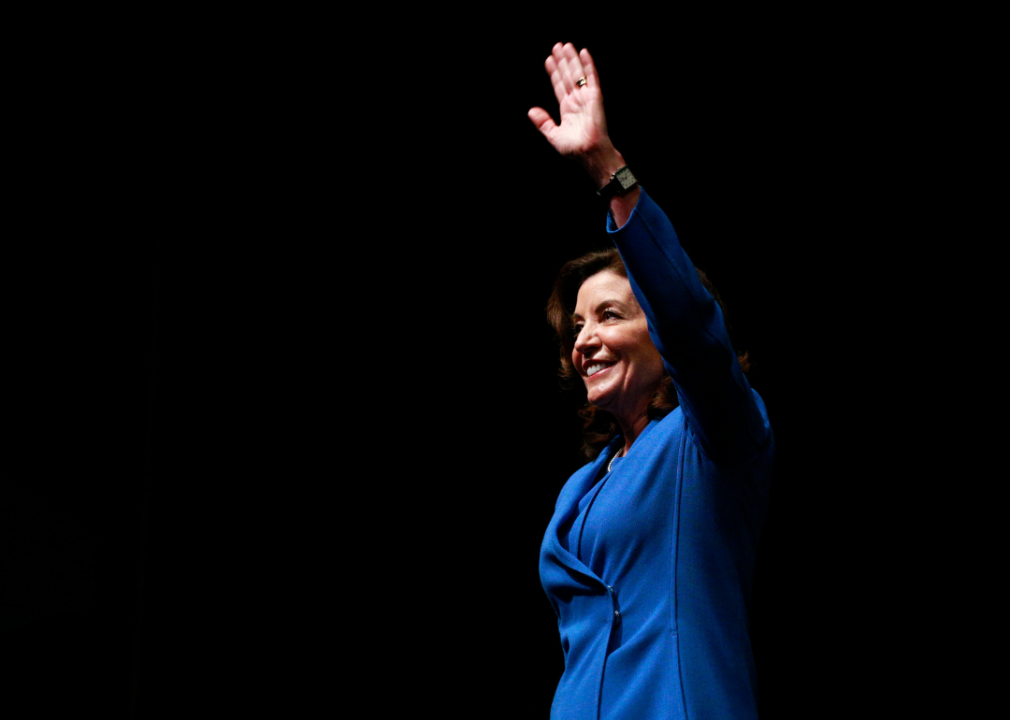
KENA BETANCUR // Getty Images
2022
– Women in office: 2,616
– Political party: 1,703 Democratic, 858 Republican, 17 nonpartisan, 38 other party
– Level of government: 150 federal executive or Congress, 2,315 state legislature, 96 statewide executive, 55 D.C. or other territory legislature
New York entered 2022 with its first woman governor, Kathy Hochul. Hochul was sworn in in August 2021 following the resignation of Andrew Cuomo amid sexual harrassment allegations. She is seeking election in 2022 to a full term.
